X DevAPI User Guide

Table of Contents
Preface and Legal Notices ................................................................................................................. ix
1 Overview ......................................................................................................................................... 1
2 Connection and Session Concepts .................................................................................................. 3
2.1 Database Connection Example ............................................................................................. 3
2.2 Connecting to a Session ....................................................................................................... 6
2.2.1 Connecting to a Single MySQL Server ....................................................................... 6
2.2.2 Connecting to One of Multiple Hosts and Connection Failover ...................................... 9
2.2.3 Connecting to a Single MySQL Server Using Connection Pooling ................................. 9
2.2.4 Connections Using DNS SRV Records ..................................................................... 12
2.2.5 Connection Option Summary .................................................................................... 13
2.2.6 Connection Attributes ............................................................................................... 13
2.3 Working with a Session Object ............................................................................................ 14
2.4 Using SQL with Session ..................................................................................................... 17
2.5 Setting the Current Schema ................................................................................................ 20
2.6 Dynamic SQL ..................................................................................................................... 21
3 CRUD Operations ......................................................................................................................... 25
3.1 CRUD Operations Overview ................................................................................................ 25
3.2 Method Chaining ................................................................................................................ 26
3.3 Synchronous versus Asynchronous Execution ...................................................................... 28
3.4 Parameter Binding .............................................................................................................. 30
3.5 MySQL Shell Automatic Code Execution ............................................................................. 36
4 Working with Collections ................................................................................................................ 39
4.1 Basic CRUD Operations on Collections ............................................................................... 39
4.2 Collection Objects ............................................................................................................... 43
4.2.1 Creating a Collection ................................................................................................ 43
4.2.2 Working with Existing Collections ............................................................................. 44
4.3 Collection CRUD Function Overview ................................................................................... 45
4.3.1 Collection.add() ........................................................................................................ 45
4.3.2 Collection.find() ........................................................................................................ 47
4.3.3 Collection.modify() .................................................................................................... 54
4.3.4 Collection.remove() .................................................................................................. 62
4.4 Indexing Collections ............................................................................................................ 64
4.5 Single Document Operations ............................................................................................... 67
4.6 JSON Schema Validation .................................................................................................... 68
5 Working with Documents ............................................................................................................... 73
5.1 Creating Documents ........................................................................................................... 73
5.2 Working with Document IDs ................................................................................................ 75
5.3 Understanding Document IDs .............................................................................................. 77
6 Working with Relational Tables ...................................................................................................... 81
6.1 Syntax of the SQL CRUD Functions .................................................................................... 84
7 Working with Relational Tables and Documents .............................................................................. 87
7.1 Collections as Relational Tables .......................................................................................... 87
8 Statement Execution ...................................................................................................................... 89
8.1 Transaction Handling .......................................................................................................... 89
8.1.1 Processing Warnings ............................................................................................... 92
8.1.2 Error Handling ......................................................................................................... 97
8.2 Working with Savepoints ................................................................................................... 101
8.3 Working with Locking ........................................................................................................ 102
8.4 Working with Prepared Statements .................................................................................... 103
9 Working with Result Sets ............................................................................................................. 105
9.1 Result Set Classes ........................................................................................................... 105
iii

X DevAPI User Guide
9.2 Working with AUTO-INCREMENT Values ............................................................................ 106
9.3 Working with Data Sets .................................................................................................... 106
9.4 Fetching All Data Items at Once ........................................................................................ 110
9.5 Working with SQL Result Sets .......................................................................................... 112
9.6 Working with Metadata ..................................................................................................... 122
9.7 Support for Language Native Iterators ............................................................................... 123
10 Building Expressions .................................................................................................................. 125
10.1 Expression Strings .......................................................................................................... 125
10.1.1 Boolean Expression Strings .................................................................................. 125
10.1.2 Value Expression Strings ...................................................................................... 125
11 CRUD EBNF Definitions ............................................................................................................ 127
11.1 Session Objects and Functions ....................................................................................... 127
11.2 Schema Objects and Functions ....................................................................................... 129
11.3 Collection CRUD Functions ............................................................................................. 132
11.4 Collection Index Management Functions .......................................................................... 134
11.5 Table CRUD Functions ................................................................................................... 134
11.6 Result Functions ............................................................................................................. 136
11.7 Other EBNF Definitions ................................................................................................... 139
12 Expressions EBNF Definitions .................................................................................................... 147
13 Implementation Notes ................................................................................................................ 163
13.1 MySQL Connector Notes ................................................................................................. 163
13.2 MySQL Shell X DevAPI extensions ................................................................................. 163
13.3 MySQL Connector/Node.js Notes .................................................................................... 163
13.4 MySQL Connector/J Notes .............................................................................................. 163
iv

List of Figures
2.1 Connection URI .......................................................................................................................... 13
3.1 Database Object - Class Diagram ............................................................................................... 26
6.1 Table.insert() Syntax Diagram ..................................................................................................... 85
6.2 Table.select() Syntax Diagram .................................................................................................... 86
6.3 Table.update() Syntax Diagram ................................................................................................... 86
6.4 Table.delete() Syntax Diagram .................................................................................................... 86
9.1 Result Classes ......................................................................................................................... 106
11.1 Session .................................................................................................................................. 128
11.2 SqlExecute ............................................................................................................................. 128
11.3 SQLPlaceholderValues ............................................................................................................ 129
11.4 SQLPlaceholderName ............................................................................................................. 129
11.5 SQLLiteral .............................................................................................................................. 129
11.6 Schema .................................................................................................................................. 130
11.7 Collection ............................................................................................................................... 131
11.8 Table ...................................................................................................................................... 132
11.9 CollectionFindFunction ............................................................................................................ 132
11.10 CollectionModifyFunction ....................................................................................................... 133
11.11 CollectionAddFunction ........................................................................................................... 133
11.12 CollectionRemoveFunction ..................................................................................................... 134
11.13 CollectionCreateIndexFunction ............................................................................................... 134
11.14 CollectionDropIndex .............................................................................................................. 134
11.15 TableSelectFunction .............................................................................................................. 135
11.16 TableInsertFunction ............................................................................................................... 135
11.17 TableUpdateFunction ............................................................................................................ 136
11.18 TableDeleteFunction .............................................................................................................. 136
11.19 Result ................................................................................................................................... 137
11.20 DocResult ............................................................................................................................. 137
11.21 RowResult ............................................................................................................................ 137
11.22 Column ................................................................................................................................. 138
11.23 SqlResult .............................................................................................................................. 139
11.24 SearchConditionStr ............................................................................................................... 139
11.25 SearchExprStrList ................................................................................................................. 139
11.26 ProjectedDocumentExprStr .................................................................................................... 140
11.27 ProjectedSearchExprStrList ................................................................................................... 140
11.28 SortExprStrList ...................................................................................................................... 140
11.29 ExprOrLiteral ......................................................................................................................... 140
11.30 ExprOrLiterals ....................................................................................................................... 141
11.31 ExprOrLiteralOrOperand ........................................................................................................ 141
11.32 PlaceholderValues ................................................................................................................. 141
11.33 PlaceholderName .................................................................................................................. 141
11.34 DocPath ............................................................................................................................... 142
11.35 Literal ................................................................................................................................... 142
11.36 Expression ............................................................................................................................ 143
11.37 Document ............................................................................................................................. 143
11.38 JSONExpression ................................................................................................................... 144
11.39 JSONDocumentExpression .................................................................................................... 144
11.40 FunctionName ....................................................................................................................... 144
11.41 DocumentOrJSON ................................................................................................................. 144
11.42 TableField ............................................................................................................................. 145
11.43 TableFields ........................................................................................................................... 145
12.1 ident ....................................................................................................................................... 147
v

X DevAPI User Guide
12.2 schemaQualifiedIdent .............................................................................................................. 147
12.3 columnIdent ............................................................................................................................ 147
12.4 documentPathLastItem ............................................................................................................ 148
12.5 documentPathItem .................................................................................................................. 148
12.6 documentPath ......................................................................................................................... 148
12.7 documentField ........................................................................................................................ 148
12.8 argsList .................................................................................................................................. 149
12.9 lengthSpec ............................................................................................................................. 149
12.10 castType ............................................................................................................................... 150
12.11 functionCall ........................................................................................................................... 150
12.12 placeholder ........................................................................................................................... 150
12.13 groupedExpr ......................................................................................................................... 151
12.14 unaryOp ............................................................................................................................... 151
12.15 literal .................................................................................................................................... 151
12.16 jsonKeyValue ........................................................................................................................ 151
12.17 jsonDoc ................................................................................................................................ 152
12.18 jsonarray ............................................................................................................................... 152
12.19 atomicExpr ............................................................................................................................ 152
12.20 INTERVAL_UNIT .................................................................................................................. 154
12.21 interval .................................................................................................................................. 154
12.22 intervalExpr ........................................................................................................................... 155
12.23 mulDivExpr ........................................................................................................................... 155
12.24 addSubExpr .......................................................................................................................... 155
12.25 shiftExpr ............................................................................................................................... 155
12.26 bitExpr .................................................................................................................................. 156
12.27 compExpr ............................................................................................................................. 156
12.28 ilriExpr .................................................................................................................................. 157
12.29 andExpr ................................................................................................................................ 157
12.30 orExpr .................................................................................................................................. 158
12.31 expr ...................................................................................................................................... 158
12.32 DIGIT ................................................................................................................................... 158
12.33 FLOAT .................................................................................................................................. 158
12.34 INT ....................................................................................................................................... 159
12.35 QUOTED_ID ......................................................................................................................... 159
12.36 ID ......................................................................................................................................... 159
12.37 WS ....................................................................................................................................... 160
12.38 SCHAR ................................................................................................................................. 161
12.39 STRING_DQ ......................................................................................................................... 162
12.40 STRING_SQ ......................................................................................................................... 162
vi

List of Tables
2.1 Options for Configuring a Connection Pool .................................................................................... 9
4.1 JSON Patch Merge of Document Fields ...................................................................................... 56
5.1 Different Types of Document Objects, Their Supported Languages, and Their Advantages .............. 73
9.1 The Result Classes and the Information They Provide ................................................................ 105
vii

viii

Preface and Legal Notices
This is the X DevAPI User Guide.
Legal Notices
Copyright © 2015, 2024, Oracle and/or its affiliates.
License Restrictions
This software and related documentation are provided under a license agreement containing restrictions
on use and disclosure and are protected by intellectual property laws. Except as expressly permitted
in your license agreement or allowed by law, you may not use, copy, reproduce, translate, broadcast,
modify, license, transmit, distribute, exhibit, perform, publish, or display any part, in any form, or by any
means. Reverse engineering, disassembly, or decompilation of this software, unless required by law for
interoperability, is prohibited.
Warranty Disclaimer
The information contained herein is subject to change without notice and is not warranted to be error-free.
If you find any errors, please report them to us in writing.
Restricted Rights Notice
If this is software, software documentation, data (as defined in the Federal Acquisition Regulation), or
related documentation that is delivered to the U.S. Government or anyone licensing it on behalf of the U.S.
Government, then the following notice is applicable:
U.S. GOVERNMENT END USERS: Oracle programs (including any operating system, integrated
software, any programs embedded, installed, or activated on delivered hardware, and modifications
of such programs) and Oracle computer documentation or other Oracle data delivered to or accessed
by U.S. Government end users are "commercial computer software," "commercial computer software
documentation," or "limited rights data" pursuant to the applicable Federal Acquisition Regulation and
agency-specific supplemental regulations. As such, the use, reproduction, duplication, release, display,
disclosure, modification, preparation of derivative works, and/or adaptation of i) Oracle programs (including
any operating system, integrated software, any programs embedded, installed, or activated on delivered
hardware, and modifications of such programs), ii) Oracle computer documentation and/or iii) other Oracle
data, is subject to the rights and limitations specified in the license contained in the applicable contract.
The terms governing the U.S. Government's use of Oracle cloud services are defined by the applicable
contract for such services. No other rights are granted to the U.S. Government.
Hazardous Applications Notice
This software or hardware is developed for general use in a variety of information management
applications. It is not developed or intended for use in any inherently dangerous applications, including
applications that may create a risk of personal injury. If you use this software or hardware in dangerous
applications, then you shall be responsible to take all appropriate fail-safe, backup, redundancy, and other
measures to ensure its safe use. Oracle Corporation and its affiliates disclaim any liability for any damages
caused by use of this software or hardware in dangerous applications.
Trademark Notice
Oracle, Java, MySQL, and NetSuite are registered trademarks of Oracle and/or its affiliates. Other names
may be trademarks of their respective owners.
ix

Access to Oracle Support for Accessibility
Intel and Intel Inside are trademarks or registered trademarks of Intel Corporation. All SPARC trademarks
are used under license and are trademarks or registered trademarks of SPARC International, Inc. AMD,
Epyc, and the AMD logo are trademarks or registered trademarks of Advanced Micro Devices. UNIX is a
registered trademark of The Open Group.
Third-Party Content, Products, and Services Disclaimer
This software or hardware and documentation may provide access to or information about content,
products, and services from third parties. Oracle Corporation and its affiliates are not responsible for and
expressly disclaim all warranties of any kind with respect to third-party content, products, and services
unless otherwise set forth in an applicable agreement between you and Oracle. Oracle Corporation and its
affiliates will not be responsible for any loss, costs, or damages incurred due to your access to or use of
third-party content, products, or services, except as set forth in an applicable agreement between you and
Oracle.
Use of This Documentation
This documentation is NOT distributed under a GPL license. Use of this documentation is subject to the
following terms:
You may create a printed copy of this documentation solely for your own personal use. Conversion to other
formats is allowed as long as the actual content is not altered or edited in any way. You shall not publish
or distribute this documentation in any form or on any media, except if you distribute the documentation in
a manner similar to how Oracle disseminates it (that is, electronically for download on a Web site with the
software) or on a CD-ROM or similar medium, provided however that the documentation is disseminated
together with the software on the same medium. Any other use, such as any dissemination of printed
copies or use of this documentation, in whole or in part, in another publication, requires the prior written
consent from an authorized representative of Oracle. Oracle and/or its affiliates reserve any and all rights
to this documentation not expressly granted above.
Access to Oracle Support for Accessibility
Oracle customers that have purchased support have access to electronic support through My Oracle
Support. For information, visit
http://www.oracle.com/pls/topic/lookup?ctx=acc&id=info or visit http://www.oracle.com/pls/topic/
lookup?ctx=acc&id=trs if you are hearing impaired.
x

Chapter 1 Overview
This guide explains how to use the X DevAPI and provides examples of its functionality. The X DevAPI
is implemented by MySQL Shell and MySQL Connectors that support X Protocol. For more background
information and instructions on how to install and get started using X DevAPI, see Using MySQL as a
Document Store. For quick-start tutorials introducing you to X DevAPI, see JavaScript Quick-Start Guide:
MySQL Shell for Document Store and Python Quick-Start Guide: MySQL Shell for Document Store. In
addition to this documentation, there is developer documentation for all X DevAPI methods in the API
references, available from Connectors and APIs.
This section introduces the X DevAPI and provides an overview of the features available when using it to
develop applications.
Important
The X DevAPI implementation in MySQL Shell can differ from the implementation in
the Connector products. This guide provides an overview of using the concepts in
all X DevAPI implementations.
The X DevAPI wraps powerful concepts in a simple API.
• A new high-level session concept enables you to write code that can transparently scale from single
MySQL Server to a multiple server environment. See Chapter 2, Connection and Session Concepts.
• Read operations are simple and easy to understand.
• Non-blocking, asynchronous calls follow common host language patterns.
The X DevAPI introduces a new, modern, and easy-to-learn way to work with your data.
• Documents are stored in Collections and have their dedicated CRUD operation set. See Chapter 4,
Working with Collections and Chapter 5, Working with Documents.
• Work with your existing domain objects or generate code based on structure definitions for strictly typed
languages. See Chapter 5, Working with Documents.
• Focus is put on working with data via CRUD operations. See Section 3.1, “CRUD Operations Overview”.
• Modern practices and syntax styles are used to get away from traditional SQL-String-Building. See
Chapter 10, Building Expressions for details.
1

2

Chapter 2 Connection and Session Concepts
Table of Contents
2.1 Database Connection Example ..................................................................................................... 3
2.2 Connecting to a Session ............................................................................................................... 6
2.2.1 Connecting to a Single MySQL Server ............................................................................... 6
2.2.2 Connecting to One of Multiple Hosts and Connection Failover .............................................. 9
2.2.3 Connecting to a Single MySQL Server Using Connection Pooling ......................................... 9
2.2.4 Connections Using DNS SRV Records ............................................................................. 12
2.2.5 Connection Option Summary ............................................................................................ 13
2.2.6 Connection Attributes ....................................................................................................... 13
2.3 Working with a Session Object ................................................................................................... 14
2.4 Using SQL with Session ............................................................................................................. 17
2.5 Setting the Current Schema ........................................................................................................ 20
2.6 Dynamic SQL ............................................................................................................................. 21
This section explains the concepts of connections and sessions as used by the X DevAPI. Code examples
for connecting to a MySQL Document Store (see Using MySQL as a Document Store) and using sessions
are provided.
An X DevAPI session is a high-level database session concept that is different from working with traditional
low-level MySQL connections. Sessions can encapsulate one or more actual MySQL connections when
using the X Protocol. Use of this higher abstraction level decouples the physical MySQL setup from the
application code. Sessions provide full support of X DevAPI and limited support of SQL.
For MySQL Shell, when a low-level MySQL connection to a single MySQL instance is needed this is still
supported by using a ClassicSession, which provides full support of SQL.
Before looking at the concepts in more detail, the following examples show how to connect using a
session.
2.1 Database Connection Example
The code that is needed to connect to a MySQL document store looks a lot like the traditional MySQL
connection code, but now applications can establish logical sessions to MySQL server instances running
the X Plugin. Sessions are produced by the mysqlx factory, and the returned sessions can encapsulate
access to one or more MySQL server instances running X Plugin. Applications that use Session objects by
default can be deployed on both single server setups and database clusters with no code changes.
Create an X DevAPI session using the mysqlx.getSession(connection) method. You pass in the
connection parameters to connect to the MySQL server, such as the hostname and user, very much like
the code in one of the classic APIs. The connection parameters can be specified as either a URI type
string, for example user:@localhost:33060, or as a data dictionary, for example {user: myuser,
password: mypassword, host: example.com, port: 33060}. See Connecting to the Server
Using URI-Like Strings or Key-Value Pairs for more information.
The MySQL user account used for the connection should use either the mysql_native_password
or caching_sha2_password authentication plugin, see Pluggable Authentication. The server
you are connecting to should have encrypted connections enabled, the default in MySQL 8.0 and
later. This ensures that the client uses the X Protocol PLAIN password mechanism which works
with user accounts that use either of the authentication plugins. If you try to connect to a server
instance which does not have encrypted connections enabled, for user accounts that use the
3

Database Connection Example
mysql_native_password plugin authentication is attempted using MYSQL41 first, and for user accounts
that use caching_sha2_password authentication falls back to SHA256_MEMORY.
The following example code shows how to connect to a MySQL server and get a document from the
my_collection collection that has the field name starting with L. The example assumes that a schema
called test exists, and the my_collection collection exists. To make the example work, replace user
with your username, and password with your password. If you are connecting to a different host or
through a different port, change the host from localhost and the port from 33060.
MySQL Shell JavaScript Code
var mysqlx = require('mysqlx');
// Connect to server on localhost
var mySession = mysqlx.getSession( {
host: 'localhost', port: 33060,
user: 'user', password: 'password' } );
var myDb = mySession.getSchema('test');
// Use the collection 'my_collection'
var myColl = myDb.getCollection('my_collection');
// Specify which document to find with Collection.find() and
// fetch it from the database with .execute()
var myDocs = myColl.find('name like :param').limit(1).
bind('param', 'L%').execute();
// Print document
print(myDocs.fetchOne());
mySession.close();
MySQL Shell Python Code
from mysqlsh import mysqlx
# Connect to server on localhost
mySession = mysqlx.get_session( {
'host': 'localhost', 'port': 33060,
'user': 'user', 'password': 'password' } )
myDb = mySession.get_schema('test')
# Use the collection 'my_collection'
myColl = myDb.get_collection('my_collection')
# Specify which document to find with Collection.find() and
# fetch it from the database with .execute()
myDocs = myColl.find('name like :param').limit(1).bind('param', 'L%').execute()
# Print document
document = myDocs.fetch_one()
print(document)
mySession.close()
Node.js JavaScript Code
var mysqlx = require('@mysql/xdevapi');
// Connect to server on localhost
mysqlx
.getSession({
4

Database Connection Example
user: 'user',
password: 'password',
host: 'localhost',
port: '33060'
})
.then(function (session) {
var db = session.getSchema('test');
// Use the collection 'my_collection'
var myColl = db.getCollection('my_collection');
// Specify which document to find with Collection.find() and
// fetch it from the database with .execute()
return myColl
.find('name like :param')
.limit(1)
.bind('param', 'L%')
.execute(function (doc) {
console.log(doc);
});
})
.catch(function (err) {
// Handle error
});
C# Code
// Connect to server on localhost
var mySession = MySQLX.GetSession("server=localhost;port=33060;user=user;password=password;");
var myDb = mySession.GetSchema("test");
// Use the collection "my_collection"
var myColl = myDb.GetCollection("my_collection");
// Specify which document to find with Collection.Find() and
// fetch it from the database with .Execute()
var myDocs = myColl.Find("name like :param").Limit(1)
.Bind("param", "L%").Execute();
// Print document
Console.WriteLine(myDocs.FetchOne());
mySession.Close();
Python Code
import mysqlx
# Connect to server on localhost
my_session = mysqlx.get_session({
'host': 'localhost', 'port': 33060,
'user': 'user', 'password': 'password'
})
my_schema = my_session.get_schema('test')
# Use the collection 'my_collection'
my_coll = my_schema.get_collection('my_collection')
# Specify which document to find with Collection.find() and
# fetch it from the database with .execute()
docs = my_coll.find('name like :param').limit(1).bind('param', 'L%').execute()
# Print document
doc = docs.fetch_one()
print(doc)
my_session.close()
5

Connecting to a Session
Java Code
import com.mysql.cj.xdevapi.*;
// Connect to server on localhost
Session mySession = new SessionFactory().getSession("mysqlx://localhost:33060/test?user=user&password=password");
Schema myDb = mySession.getSchema("test");
// Use the collection 'my_collection'
Collection myColl = myDb.getCollection("my_collection");
// Specify which document to find with Collection.find() and
// fetch it from the database with .execute()
DocResult myDocs = myColl.find("name like :param").limit(1).bind("param", "L%").execute();
// Print document
System.out.println(myDocs.fetchOne());
mySession.close();
C++ Code
#include <mysqlx/xdevapi.h>
// Scope controls life-time of objects such as session or schema
{
Session sess("localhost", 33060, "user", "password");
Schema db= sess.getSchema("test");
// or Schema db(sess, "test");
Collection myColl = db.getCollection("my_collection");
// or Collection myColl(db, "my_collection");
DocResult myDocs = myColl.find("name like :param")
.limit(1)
.bind("param","L%").execute();
cout << myDocs.fetchOne();
}
2.2 Connecting to a Session
There are several ways of using a session to connect to MySQL depending on the specific setup in use.
This section explains the different methods available.
2.2.1 Connecting to a Single MySQL Server
In this example a connection to a local MySQL Server instance running X Plugin on the default TCP/IP port
33060 is established using the MySQL user account user with its password. As no other parameters are
set, default values are used.
MySQL Shell JavaScript Code
// Passing the parameters in the { param: value } format
var dictSession = mysqlx.getSession( {
host: 'localhost', 'port': 33060,
user: 'user', password: 'password' } )
var db1 = dictSession.getSchema('test')
6

Connecting to a Single MySQL Server
// Passing the parameters in the URI format
var uriSession = mysqlx.getSession('user:password@localhost:33060')
var db2 = uriSession.getSchema('test')
MySQL Shell Python Code
# Passing the parameters in the { param: value } format
dictSession = mysqlx.get_session( {
'host': 'localhost', 'port': 33060,
'user': 'user', 'password': 'password' } )
db1 = dictSession.get_schema('test')
# Passing the parameters in the URI format
uriSession = mysqlx.get_session('user:password@localhost:33060')
db2 = uriSession.get_schema('test')
The following example shows how to connect to a single MySQL Server instance by providing a TCP/IP
address “localhost” and the same user account as before. You are prompted to enter the user name and
password in this case.
MySQL Shell JavaScript Code
// Passing the parameters in the { param: value } format
// Query the user for the account information
print("Please enter the database user information.");
var usr = shell.prompt("Username: ", {defaultValue: "user"});
var pwd = shell.prompt("Password: ", {type: "password"});
// Connect to MySQL Server on a network machine
mySession = mysqlx.getSession( {
host: 'localhost', 'port': 33060,
user: usr, password: pwd} );
myDb = mySession.getSchema('test');
MySQL Shell Python Code
# Passing the parameters in the { param: value } format
# Query the user for the account information
print("Please enter the database user information.")
usr = shell.prompt("Username: ", {'defaultValue': "user"})
pwd = shell.prompt("Password: ", {'type': "password"})
# Connect to MySQL Server on a network machine
mySession = mysqlx.get_session( {
'host': 'localhost', 'port': 33060,
'user': usr, 'password': pwd} )
myDb = mySession.get_schema('test')
Node.js JavaScript Code
// Passing the parameters in the { param: value } format
mysqlx.getSession({ host: 'localhost', port: 33060, user: 'user', password: 'password' })
.then(function (dictSession) {
var db1 = dictSession.getSchema('test')
})
// Passing the parameters in the URI format
mysqlx.getSession('user:password@localhost:33060')
.then(function (uriSession) {
7

Connecting to a Single MySQL Server
var db2 = uriSession.getSchema('test')
})
C# Code
// Query the user for the user information
Console.WriteLine("Please enter the database user information.");
Console.Write("Username: ");
var usr = Console.ReadLine();
Console.Write("Password: ");
var pwd = Console.ReadLine();
// Connect to server on localhost using a connection URI
var mySession = MySQLX.GetSession(string.Format("mysqlx://localhost:33060/test?user={0}&password={1}", usr, pwd));
var myDb = mySession.GetSchema("test");
Python Code
# Passing the parameters in the { param: value } format
dict_session = mysqlx.get_session({
'host': 'localhost', 'port': 33060,
'user': 'user', 'password': 'password'
})
my_schema_1 = dict_session.get_schema('test')
# Passing the parameters in the URI format
uri_session = mysqlx.get_session('user:password@localhost:33060')
my_schema_2 = uri_session.get_schema('test')
Java Code
import com.mysql.cj.xdevapi.*;
// Connect to server on localhost using a connection URI
Session mySession = new SessionFactory().getSession("mysqlx://localhost:33060/test?user=user&password=password");
Schema myDb = mySession.getSchema("test");
C++ Code
// This code sample assumes that we have function prompt() defined somewhere.
string usr = prompt("Username:");
string pwd = prompt("Password:");
// Connect to MySQL Server on a network machine
Session mySession(SessionOption::HOST, "localhost",
SessionOption::PORT, 33060,
SessionOption::USER, usr,
SessionOption::PWD, pwd);
// An alternative way of defining session settings.
SessionSettings settings(SessionOption::HOST,"localhost",
SessionOption::PORT, 33060);
settings.set(SessionOption::USER, usr);
settings.set(SessionOption::PWD, pwd);
Session mySession(settings);
Schema myDb= mySession.getSchema("test");
8

Connecting to One of Multiple Hosts and Connection Failover
2.2.2 Connecting to One of Multiple Hosts and Connection Failover
You can provide multiple MySQL Router or server endpoints (as host and an optional port, or Unix sockets)
when creating a session. You specify a URI-like string which contains multiple hosts, ports, and optional
priority. This enables the connector to perform automatic connection failover selection when any of the
endpoints are not available. When multiple endpoints are available, the choice of which server is used
for the session depends on whether you specify priority. If a priority is specified for each endpoint, the
available endpoint with the highest priority is used. If you do not specify priority, a random available
endpoint is used. This section describes how to configure multiple endpoints in a URI-like string. For more
information on URI-like connection strings, see Connecting Using URI-Like Connection Strings.
Note
The user and password you supply in the URI-like string apply to all of the possible
endpoints and therefore the same MySQL account must exist on each of the
endpoints.
To specify multiple hosts without priority, the URI-like connection string is formatted as:
user:password@[(address=[host]:[port]), (address=[host]:[port]) ..]
The collection of endpoints is listed as either host, port, or host and port. When setting up multiple
endpoints without priority, any of the available endpoints is chosen for the connection.
To specify priorities for the endpoints, the URI-like connection string is formatted as:
user:password@[(address=[host]:[port], priority=value), (address=[host]:[port], priority=value) ..]
This sets up endpoints with explicit priority, for example to failover the connection to a specific endpoint in
the event of another endpoint not being available. Specified priorities can range from 0 (lowest priority) to
100 (highest priority). When two endpoints share the same priority, one of them is chosen randomly.
For example, suppose you connect using an URI-like string such as:
mysqlx://user:password@[(address=example1.com:33060,priority=99),(address=example2.com:33060,priority=100)]
In this case, there are two possible endpoints, and example2:33060 has a higher priority. When
both endpoints are available, the connector connects to example2.com:33060. In the event that
example2.com:33060 is not available, the connector connects to example1:33060.
2.2.3 Connecting to a Single MySQL Server Using Connection Pooling
X DevAPI supports connection pooling, which can reduce overhead for applications that open many
connections to a MySQL Server. Connections are managed as a pool by a Client object. When opening a
new Session with a Client, before a new network connection is opened, an attempt is made to retrieve from
the pool an existing and currently unused connection, which is then reset and reused.
A connection pool is configured using a single key-value pair (see Connecting Using Key-Value Pairs) that
contains a single key named pooling. The value for the pooling key is another set of key-value pairs
containing any combination of the keys described in the following table:
Table 2.1 Options for Configuring a Connection Pool
Option Meaning Default
enabled Connection pooling enabled.
When the option is set to false,
a regular, non-pooled connection
true
9

Connecting to a Single MySQL Server Using Connection Pooling
Option Meaning Default
is returned, and the other
connection pool options listed
below are ignored.
maxSize The maximum number of
connections allowed in the pool
25
maxIdleTime The maximum number of
milliseconds a connection is
allowed to idle in the queue before
being closed. A zero value means
infinite.
0
queueTimeout The maximum number of
milliseconds a request is allowed
to wait for a connection to become
available. A zero value means
infinite
0
Closing the Session marks the underlying connection as unused and returns it to the Client object's
connection pool.
Closing the Client object closes all connections it manages, invalidates all Sessions the Client has created,
and destroys the managed pool.
Note
Connection pooling is not supported by MySQL Shell.
Node.js JavaScript Code
var mysqlx = require('@mysql/xdevapi');
var client = mysqlx.getClient(
{ user: 'user', host: 'localhost', port: 33060 },
{ pooling: { enabled: true, maxIdleTime: 30000, maxSize: 25, queueTimeout: 10000 } }
);
client.getSession()
.then(session => {
console.log(session.inspect())
return session.close() // the connection becomes idle in the client pool
})
.then(() => {
return client.getSession()
})
.then(session => {
console.log(session.inspect())
return client.close() // closes all connections and destroys the pool
})
C# Code
using (Client client = MySQLX.GetClient("server=localhost;user=user:port=33060;",
new { pooling = new { Enabled = true, MaxSize = 100, MaxIdleTime=30000, QueueTimeout = 10000 } }))
{
using (Session session = client.GetSession())
{
foreach (Collection coll in session.Schema.GetCollections())
{
Console.WriteLine(coll.Name);
}
10

Connecting to a Single MySQL Server Using Connection Pooling
} // session.Dispose() is called and the session becomes idle in the pool
} // client.Dispose() is called then all sessions are closed and pool is destroyed
Python Code
connection_string = {
'host': 'localhost',
'port': 37210,
'user': 'user',
'password': 'password'
}
client_options = {
'pooling': {
"max_size": 10,
"max_idle_time": 30000
}
}
client = mysqlx.get_client(connection_string, client_options)
session1 = client.get_session()
session2 = client.get_session()
# closing all the sessions
client.close()
Java Code
//Obtain new ClientFactory
ClientFactory cf = new ClientFactory();
//Obtain Client from ClientFactory
Client cli = cf.getClient(this.baseUrl, "{\"pooling\":{\"enabled\":true, \"maxSize\":8,
\"maxIdleTime\":30000, \"queueTimeout\":10000} }");
Session sess = cli.getSession();
//Use Session as usual
//Close Client after use
cli.close();
C++ Code
using namespace mysqlx;
Client cli("user:password@host_name/db_name", ClientOption::POOL_MAX_SIZE, 7);
Session sess = cli.getSession();
// use Session sess as usual
cli.close(); // close all Sessions
Connector/C++ Code using X DevAPI for C
char error_buf[255];
int error_code;
mysqlx_client_t *cli
= mysqlx_get_client_from_url(
"user:password@host_name/db_name", "{ \"maxSize\": 7 }", error_buf, &error_code
);
mysqlx_session_t *sess = mysqlx_get_session_from_client(cli);
// use sess as before
mysqlx_close_client(cli); // close session sess
11

Connections Using DNS SRV Records
2.2.4 Connections Using DNS SRV Records
X DevAPI supports the use of DNS SRV records for connecting to MySQL servers. A client that receives
a DNS SRV lookup result attempts to connect to the MySQL server on each of the listed hosts in order of
preference, based on the priority and weighting assigned to each host by the DNS administrator. A failure
to connect occurs only if the client cannot connect to any of the servers. This section focuses on use of
DNS SRV within X DevAPI applications. For general information about DNS SRV support in MySQL, see
Connecting to the Server Using DNS SRV Records.
MySQL Connectors that implement X DevAPI can request DNS SRV record lookup by specifying mysqlx
+srv as the scheme element of the URI-like connection string, along with the DNS SRV name. For
example:
mysqlx+srv://_mysqlx._tcp.example.com/db?options
A DNS SRV name consists of a service, protocol, and domain, with the service and protocol each prefixed
by an underscore. In the example, mysqlx indicates the X Protocol service and tcp indicates the TCP
protocol.
The X DevAPI mysqlx.getSession() method, and the mysqlx.getClient() method for connection
pooling, validate connection information with this protocol scheme extension, and handle the resulting DNS
SRV record as a list of hosts for the purposes of failover behavior and connection pooling. The priority and
weighting specified in the DNS SRV record is respected.
MySQL Connectors also have connector-specific options to request DNS SRV record lookup both for X
Protocol connections and for classic MySQL protocol connections. For details, see the documentation for
individual MySQL Connectors.
Note
MySQL Shell does not currently support DNS SRV records.
When DNS SRV record lookup is used, clients generally must apply these rules for connection requests
(there may be connector-specific exceptions):
• The request must specify the full DNS SRV record name, with the service and protocol names prefixed
by underscores. For example, this DNS SRV record relates to an X Protocol service implemented over
TCP that can be provided by multiple servers in the installation:
Name TTL Class Priority Weight Port Target
_mysqlx._tcp.example.com. 86400 IN SRV 0 5 33060 server1.example.com.
_mysqlx._tcp.example.com. 86400 IN SRV 0 10 33060 server2.example.com.
_mysqlx._tcp.example.com. 86400 IN SRV 10 5 33060 server3.example.com.
_mysqlx._tcp.example.com. 86400 IN SRV 20 5 33060 server4.example.com.
A client can specify that DNS SRV record using syntax like this:
var client = mysqlx.getClient("mysqlx+srv://_mysqlx._tcp.example.com")
• The request must not specify multiple host names.
• The request must not specify a port number.
• Only TCP connections are supported. Unix socket files, Windows named pipes, and shared memory
cannot be used.
Java Code
12

Connection Option Summary
Session mySession = new
SessionFactory().getSession("mysqlx+srv://user:password@_mysql._tcp.example.com/db");
Node.js JavaScript Code
mysqlx.getSession({ host: '_mysqlx._tcp.example.com', resolveSrv: true })
C# Code
var session = MySQLX.GetSession("mysqlx+srv://user:password@_mysqlx._tcp.example.com.");
Connector/C++ Code using X DevAPI for C
mysqlx::Session sess(
SessionOption::HOST, "_mysqlx._tcp.example.com",
SessionOption::DNS_SRV, true,
SessionOption::USER, "user",
SessionOption::PWD, "password");
Python Code
session = mysqlx.get_session(host="tcp.example.com", dns_srv=True)
2.2.5 Connection Option Summary
When using an X DevAPI session the following options are available to configure the connection.
Option Name Optional Default Notes
TCP/IP Host host - localhost, IPv4 host
name, no IP-range
TCP/IP Port port Yes 33060 Standard X Plugin
port is 33060
MySQL user user - MySQL database
user
MySQL password password - The MySQL user's
password
Supported authentication methods are:
• PLAIN
• MYSQL 4.1
URI elements and format.
Figure 2.1 Connection URI
ConnectURI1::= 'user' ':' 'password' '@' 'host' ':' 'port'
2.2.6 Connection Attributes
Connection attributes are key-value pairs that application programs can pass to the server during
connection time to be stored in the PERFORMANCE_SCHEMA tables session_account_connect_attrs and
session_connect_attrs. There are two different kinds of connection attributes:
13

Working with a Session Object
• Client-defined attributes are reserved key-value mappings implicitly encoded by a client. The set of
client-defined attributes differ from client to client—see the X DevAPI references of you client for details.
The client-defined attributes are sent to the server by default.
• User-defined attributes are key-value mappings provided by the user or application.
X DevAPI supports MySQL connection attributes through the connection parameter connection-
attributes (xdevapi.connection-attributes for Connector/J), set through the getSession()
and getClient() methods. Here are the different ways to use the parameter:
• These settings for the parameter are equivalent to the default behavior (that is, sending client-defined
attributes) when the parameter is not used:
• connection-attributes
• connection-attributes=
• connection-attributes=true
• connection-attributes=[]
• connection-attributes=false prevents any connection attributes to be sent, including the client-
defined ones.
• connection-attributes=[key1=value1,key2=value2, ...] sends user-defined connection
attributes as key-value pairs alongside the client-defined connection attributes. When a value is missing
from a key-value pair, a null value is set for the attribute
The following is a generic example of a connection string that configures the connection attributes:
mysqlx://user:password@localhost:33060?connection-attributes=[key1=value1,key2=value2,key3=]
2.3 Working with a Session Object
All previous examples used the getSchema() or getDefaultSchema() methods of the Session object,
which return a Schema object. You use this Schema object to access Collections and Tables. Most
examples make use of the X DevAPI ability to chain all object constructions, enabling you to get to the
Schema object in one line. For example:
schema = mysqlx.getSession(...).getSchema();
This object chain is equivalent to the following, with the difference that the intermediate step is omitted:
session = mysqlx.getSession();
schema = session.getSchema().
There is no requirement to always chain calls until you get a Schema object, neither is it always what
you want. If you want to work with the Session object, for example, to call the Session object method
getSchemas(), there is no need to navigate down to the Schema. For example:
session = mysqlx.getSession(); session.getSchemas().
In this example the mysqlx.getSession() function is used to open a Session. Then the
Session.getSchemas() function is used to get a list of all available schemas and print them to the
console.
MySQL Shell JavaScript Code
14

Working with a Session Object
// Connecting to MySQL and working with a Session
var mysqlx = require('mysqlx');
// Connect to a dedicated MySQL server using a connection URI
var mySession = mysqlx.getSession('user:password@localhost');
// Get a list of all available schemas
var schemaList = mySession.getSchemas();
print('Available schemas in this session:\n');
// Loop over all available schemas and print their name
for (index in schemaList) {
print(schemaList[index].name + '\n');
}
mySession.close();
MySQL Shell Python Code
# Connecting to MySQL and working with a Session
from mysqlsh import mysqlx
# Connect to a dedicated MySQL server using a connection URI
mySession = mysqlx.get_session('user:password@localhost')
# Get a list of all available schemas
schemaList = mySession.get_schemas()
print('Available schemas in this session:\n')
# Loop over all available schemas and print their name
for schema in schemaList:
print('%s\n' % schema.name)
mySession.close()
Node.js JavaScript Code
// Connecting to MySQL and working with a Session
var mysqlx = require('@mysql/xdevapi');
// Connect to a dedicated MySQL server using a connection URI
mysqlx
.getSession('user:password@localhost')
.then(function (mySession) {
// Get a list of all available schemas
return mySession.getSchemas();
})
.then(function (schemaList) {
console.log('Available schemas in this session:\n');
// Loop over all available schemas and print their name
schemaList.forEach(function (schema) {
console.log(schema.getName() + '\n');
});
});
C# Code
// Connect to a dedicated MySQL server node using a connection URI
var mySession = MySQLX.GetSession("mysqlx://user:password@localhost:33060");
// Get a list of all available schemas
var schemaList = mySession.GetSchemas();
15

Working with a Session Object
Console.WriteLine("Available schemas in this session:");
// Loop over all available schemas and print their name
foreach (var schema in schemaList)
{
Console.WriteLine(schema.Name);
}
mySession.Close();
Python Code
# Connector/Python
# Connecting to MySQL and working with a Session
from mysqlsh import mysqlx
# Connect to a dedicated MySQL server using a connection URI
mySession = mysqlx.get_session('user:password@localhost')
# Get a list of all available schemas
schemaList = mySession.get_schemas()
print('Available schemas in this session:\n')
# Loop over all available schemas and print their name
for schema in schemaList:
print('%s\n' % schema.name)
mySession.close()
Java Code
import java.util.List;
import com.mysql.cj.xdevapi.*;
// Connecting to MySQL and working with a Session
// Connect to a dedicated MySQL server using a connection URI
Session mySession = new SessionFactory().getSession("mysqlx://localhost:33060/test?user=user&password=password");
// Get a list of all available schemas
List<Schema> schemaList = mySession.getSchemas();
System.out.println("Available schemas in this session:");
// Loop over all available schemas and print their name
for (Schema schema : schemaList) {
System.out.println(schema.getName());
}
mySession.close();
C++ Code
#include <mysqlx/xdevapi.h>
// Connecting to MySQL and working with a Session
// Connect to a dedicated MySQL server using a connection URI
string url = "mysqlx://localhost:33060/test?user=user&password=password";
{
Session mySession(url);
// Get a list of all available schemas
std::list<Schema> schemaList = mySession.getSchemas();
cout << "Available schemas in this session:" << endl;
16

Using SQL with Session
// Loop over all available schemas and print their name
for (Schema schema : schemaList) {
cout << schema.getName() << endl;
}
}
2.4 Using SQL with Session
In addition to the simplified X DevAPI syntax of the Session object, the Session object has a sql()
function that takes any SQL statement as a string.
The following example uses a Session to call an SQL Stored Procedure on the specific node.
MySQL Shell JavaScript Code
var mysqlx = require('mysqlx');
// Connect to server using a Session
var mySession = mysqlx.getSession('user:password@localhost');
// Switch to use schema 'test'
mySession.sql("USE test").execute();
// In a Session context the full SQL language can be used
mySession.sql("CREATE PROCEDURE my_add_one_procedure " +
" (INOUT incr_param INT) " +
"BEGIN " +
" SET incr_param = incr_param + 1;" +
"END;").execute();
mySession.sql("SET @my_var = ?;").bind(10).execute();
mySession.sql("CALL my_add_one_procedure(@my_var);").execute();
mySession.sql("DROP PROCEDURE my_add_one_procedure;").execute();
// Use an SQL query to get the result
var myResult = mySession.sql("SELECT @my_var").execute();
// Gets the row and prints the first column
var row = myResult.fetchOne();
print(row[0]);
mySession.close();
MySQL Shell Python Code
from mysqlsh import mysqlx
# Connect to server using a Session
mySession = mysqlx.get_session('user:password@localhost')
# Switch to use schema 'test'
mySession.sql("USE test").execute()
# In a Session context the full SQL language can be used
sql = """CREATE PROCEDURE my_add_one_procedure
(INOUT incr_param INT)
BEGIN
SET incr_param = incr_param + 1;
END
"""
mySession.sql(sql).execute()
mySession.sql("SET @my_var = ?").bind(10).execute()
mySession.sql("CALL my_add_one_procedure(@my_var)").execute()
mySession.sql("DROP PROCEDURE my_add_one_procedure").execute()
17

Using SQL with Session
# Use an SQL query to get the result
myResult = mySession.sql("SELECT @my_var").execute()
# Gets the row and prints the first column
row = myResult.fetch_one()
print(row[0])
mySession.close()
Node.js JavaScript Code
var mysqlx = require('@mysql/xdevapi');
var session;
// Connect to server using a Low-Level Session
mysqlx
.getSession('user:password@localhost')
.then(function (s) {
session = s;
return session.getSchema('test');
})
.then(function () {
return Promise.all([
// Switch to use schema 'test'
session.sql('USE test').execute(),
// In a Session context the full SQL language can be used
session.sql('CREATE PROCEDURE my_add_one_procedure' +
' (INOUT incr_param INT) ' +
'BEGIN ' +
' SET incr_param = incr_param + 1;' +
'END;').execute(),
session.executeSql('SET @my_var = ?;', 10).execute(),
session.sql('CALL my_add_one_procedure(@my_var);').execute(),
session.sql('DROP PROCEDURE my_add_one_procedure;').execute()
])
})
.then(function() {
// Use an SQL query to get the result
return session.sql('SELECT @my_var').execute(function (row) {
// Print result
console.log(row);
});
});
C# Code
// Connect to server using a Session
var mySession = MySQLX.GetSession("server=localhost;port=33060;user=user;password=password;");
// Switch to use schema "test"
mySession.SQL("USE test").Execute();
// In a Session context the full SQL language can be used
mySession.SQL("CREATE PROCEDURE my_add_one_procedure " +
" (INOUT incr_param INT) " +
"BEGIN " +
" SET incr_param = incr_param + 1;" +
"END;").Execute();
mySession.SQL("SET @my_var = 10;").Execute();
mySession.SQL("CALL my_add_one_procedure(@my_var);").Execute();
mySession.SQL("DROP PROCEDURE my_add_one_procedure;").Execute();
// Use an SQL query to get the result
var myResult = mySession.SQL("SELECT @my_var").Execute();
18

Using SQL with Session
// Gets the row and prints the first column
var row = myResult.FetchOne();
Console.WriteLine(row[0]);
mySession.Close();
Python Code
# Connector/Python
from mysqlsh import mysqlx
# Connect to server using a Session
mySession = mysqlx.get_session('user:password@localhost')
# Switch to use schema 'test'
mySession.sql("USE test").execute()
# In a Session context the full SQL language can be used
sql = """CREATE PROCEDURE my_add_one_procedure
(INOUT incr_param INT)
BEGIN
SET incr_param = incr_param + 1;
END
"""
mySession.sql(sql).execute()
mySession.sql("SET @my_var = ?").bind(10).execute()
mySession.sql("CALL my_add_one_procedure(@my_var)").execute()
mySession.sql("DROP PROCEDURE my_add_one_procedure").execute()
# Use an SQL query to get the result
myResult = mySession.sql("SELECT @my_var").execute()
# Gets the row and prints the first column
row = myResult.fetch_one()
print(row[0])
mySession.close()
Java Code
import com.mysql.cj.xdevapi.*;
// Connect to server on localhost
Session mySession = new SessionFactory().getSession("mysqlx://localhost:33060/test?user=user&password=password");
// Switch to use schema 'test'
mySession.sql("USE test").execute();
// In a Session context the full SQL language can be used
mySession.sql("CREATE PROCEDURE my_add_one_procedure " + " (INOUT incr_param INT) " + "BEGIN " + " SET incr_param = incr_param + 1;" + "END")
.execute();
mySession.sql("SET @my_var = ?").bind(10).execute();
mySession.sql("CALL my_add_one_procedure(@my_var)").execute();
mySession.sql("DROP PROCEDURE my_add_one_procedure").execute();
// Use an SQL query to get the result
SqlResult myResult = mySession.sql("SELECT @my_var").execute();
// Gets the row and prints the first column
Row row = myResult.fetchOne();
System.out.println(row.getInt(0));
mySession.close();
C++ Code
19

Setting the Current Schema
#include <mysqlx/xdevapi.h>
// Connect to server on localhost
string url = "mysqlx://localhost:33060/test?user=user&password=password";
Session mySession(url);
// Switch to use schema 'test'
mySession.sql("USE test").execute();
// In a Session context the full SQL language can be used
mySession.sql("CREATE PROCEDURE my_add_one_procedure "
" (INOUT incr_param INT) "
"BEGIN "
" SET incr_param = incr_param + 1;"
"END;")
.execute();
mySession.sql("SET @my_var = ?;").bind(10).execute();
mySession.sql("CALL my_add_one_procedure(@my_var);").execute();
mySession.sql("DROP PROCEDURE my_add_one_procedure;").execute();
// Use an SQL query to get the result
auto myResult = mySession.sql("SELECT @my_var").execute();
// Gets the row and prints the first column
Row row = myResult.fetchOne();
cout << row[0] << endl;
When using literal/verbatim SQL the common API patterns are mostly the same compared to using DML
and CRUD operations on Tables and Collections. Two differences exist: setting the current schema and
escaping names.
2.5 Setting the Current Schema
A default schema for a session can be specified using the schema attribute in the URI-like
connection string or key-value pairs when opening a connection session. The Session class
getDefaultSchema() method returns the default schema for the Session.
If no default schema has been selected at connection, the Session class setCurrentSchema()
function can be used to set a current schema.
MySQL Shell JavaScript Code
var mysqlx = require('mysqlx');
// Direct connect with no client-side default schema specified
var mySession = mysqlx.getSession('user:password@localhost');
mySession.setCurrentSchema("test");
MySQL Shell Python Code
from mysqlsh import mysqlx
# Direct connect with no client-side default schema specified
mySession = mysqlx.get_session('user:password@localhost')
mySession.set_current_schema("test")
Node.js JavaScript Code
/*
Connector/Node.js does not support the setCurrentSchema() method.
One can specify the default schema in the URI-like connection string.
*/
20

Dynamic SQL
C# Code
// Direct connect with no client-side default schema specified
var mySession = MySQLX.GetSession("server=localhost;port=33060;user=user;password=password;");
mySession.SetCurrentSchema("test");
Python Code
# Connector/Python
from mysqlsh import mysqlx
# Direct connect with no client-side default schema specified
mySession = mysqlx.get_session('user:password@localhost')
mySession.set_current_schema("test")
Java Code
/*
Connector/J does not support the setCurrentSchema() method.
One can specify the default schema in the URI-like connection string.
*/
C++ Code
/*
Connector/C++ does not support the setCurrentSchema() method.
One can specify the default schema in the URI-like connection string.
*/
Notice that setCurrentSchema() does not change the session's default schema, which remains
unchanged throughout the session, or remains null if not set at connection. The schema set by
setCurrentSchema() can be returned by the getCurrentSchema() method.
An alternative way to set the current schema is to use the Session class sql() method and the USE
db_name statement.
2.6 Dynamic SQL
A quoting function exists to escape SQL names and identifiers. Session.quoteName() escapes the
identifier given in accordance to the settings of the current connection.
Note
The quoting function must not be used to escape values. Use the value binding
syntax of Session.sql() instead; see Section 2.4, “Using SQL with Session” for
some examples.
MySQL Shell JavaScript Code
function createTestTable(session, name) {
// use escape function to quote names/identifier
quoted_name = session.quoteName(name);
session.sql("DROP TABLE IF EXISTS " + quoted_name).execute();
var create = "CREATE TABLE ";
create += quoted_name;
create += " (id INT NOT NULL PRIMARY KEY AUTO_INCREMENT)";
session.sql(create).execute();
21

Dynamic SQL
return session.getCurrentSchema().getTable(name);
}
var mysqlx = require('mysqlx');
var session = mysqlx.getSession('user:password@localhost:33060/test');
var default_schema = session.getDefaultSchema().name;
session.setCurrentSchema(default_schema);
// Creates some tables
var table1 = createTestTable(session, 'test1');
var table2 = createTestTable(session, 'test2');
MySQL Shell Python Code
def createTestTable(session, name):
# use escape function to quote names/identifier
quoted_name = session.quote_name(name)
session.sql("DROP TABLE IF EXISTS " + quoted_name).execute()
create = "CREATE TABLE "
create += quoted_name
create += " (id INT NOT NULL PRIMARY KEY AUTO_INCREMENT)"
session.sql(create).execute()
return session.get_current_schema().get_table(name)
from mysqlsh import mysqlx
session = mysqlx.get_session('user:password@localhost:33060/test')
default_schema = session.get_default_schema().name
session.set_current_schema(default_schema)
# Creates some tables
table1 = createTestTable(session, 'test1')
table2 = createTestTable(session, 'test2')
Node.js JavaScript Code
var mysqlx = require('mysqlx');
function createTestTable(session, name) {
var create = 'CREATE TABLE ';
create += name;
create += ' (id INT NOT NULL PRIMARY KEY AUTO_INCREMENT)';
return session
.sql('DROP TABLE IF EXISTS ' + name)
.execute()
.then(function () {
return session.sql(create).execute();
});
}
var session;
mysqlx
.getSession({
user: 'user',
password: 'password'
})
.then(function (s) {
session = s;
22

Dynamic SQL
return session
.sql('use myschema')
.execute()
})
.then(function () {
// Creates some tables
return Promise.map([
createTestTable(session, 'test1'),
createTestTable(session, 'test2')
])
})
.then(function () {
session.close();
})
});
C# Code
var session = MySQLX.GetSession("server=localhost;port=33060;user=user;password=password;");
session.SQL("use test;").Execute();
session.GetSchema("test");
// Creates some tables
var table1 = CreateTestTable(session, "test1");
var table2 = CreateTestTable(session, "test2");
private Table CreateTestTable(Session session, string name)
{
// use escape function to quote names/identifier
string quoted_name = "`" + name + "`";
session.SQL("DROP TABLE IF EXISTS " + quoted_name).Execute();
var create = "CREATE TABLE ";
create += quoted_name;
create += " (id INT NOT NULL PRIMARY KEY AUTO_INCREMENT)";
session.SQL(create).Execute();
return session.Schema.GetTable(name);
}
Python Code
# Connector/Python
def createTestTable(session, name):
# use escape function to quote names/identifier
quoted_name = session.quote_name(name)
session.sql("DROP TABLE IF EXISTS " + quoted_name).execute()
create = "CREATE TABLE "
create += quoted_name
create += " (id INT NOT NULL PRIMARY KEY AUTO_INCREMENT)"
session.sql(create).execute()
return session.get_current_schema().get_table(name)
from mysqlsh import mysqlx
session = mysqlx.get_session('user:password@localhost:33060/test')
default_schema = session.get_default_schema().name
session.set_current_schema(default_schema)
# Creates some tables
table1 = createTestTable(session, 'test1')
23

Dynamic SQL
table2 = createTestTable(session, 'test2')
Java Code
Java does not currently support the quoteName() method.
C++ Code
#include <mysqlx/xdevapi.h>
// Note: The following features are not yet implemented by
// Connector/C++:
// - DataSoure configuration files,
// - quoteName() method.
Table createTestTable(Session &session, const string &name)
{
string quoted_name = string("`")
+ session.getDefaultSchemaName()
+ L"`.`" + name + L"`";
session.sql(string("DROP TABLE IF EXISTS") + quoted_name).execute();
string create = "CREATE TABLE ";
create += quoted_name;
create += L"(id INT NOT NULL PRIMARY KEY AUTO_INCREMENT)";
session.sql(create).execute();
return session.getDefaultSchema().getTable(name);
}
Session session(33060, "user", "password");
Table table1 = createTestTable(session, "test1");
Table table2 = createTestTable(session, "test2");
Code that uses X DevAPI does not need to escape identifiers. This is true for working with collections and
for working with relational tables.
24

Chapter 3 CRUD Operations
Table of Contents
3.1 CRUD Operations Overview ........................................................................................................ 25
3.2 Method Chaining ........................................................................................................................ 26
3.3 Synchronous versus Asynchronous Execution ............................................................................. 28
3.4 Parameter Binding ...................................................................................................................... 30
3.5 MySQL Shell Automatic Code Execution ..................................................................................... 36
This section explains how to use the X DevAPI for Create Read, Update, and Delete (CRUD) operations.
MySQL's core domain has always been working with relational tables. X DevAPI extends this domain
by adding support for CRUD operations that can be run against collections of documents. This section
explains how to use these.
3.1 CRUD Operations Overview
CRUD operations are available as methods, which operate on Schema objects. The available Schema
objects consist of Collection objects containing Documents, or Table objects consisting of rows and
Collections containing Documents.
The following table shows the available CRUD operations for both Collection and Table objects.
Operation Document Relational
Create Section 4.3.1, “Collection.add()” Table.insert()
Read Section 4.3.2, “Collection.find()” Table.select()
Update Section 4.3.3, “Collection.modify()” Table.update()
Delete Section 4.3.4,
“Collection.remove()”
Table.delete()
25
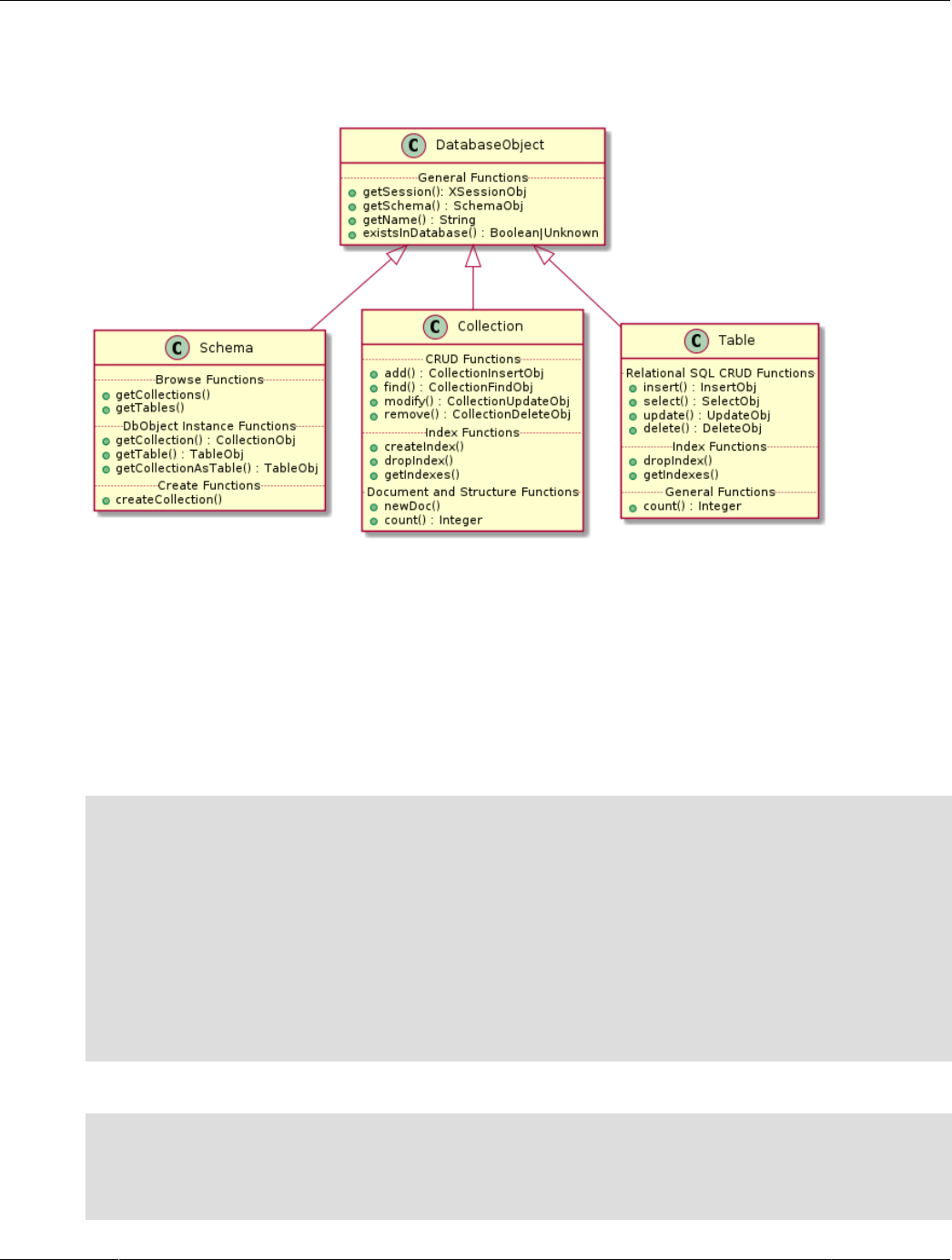
Database Object Classes
Database Object Classes
Figure 3.1 Database Object - Class Diagram
3.2 Method Chaining
X DevAPI supports a number of modern practices to make working with CRUD operations easier and to
fit naturally into modern development environments. This section explains how to use method chaining
instead of working with SQL strings of JSON structures.
The following example shows how method chaining is used instead of an SQL string when working with
Session objects. The example assumes that the test schema exists and an employee table exists.
MySQL Shell JavaScript Code
// New method chaining used for executing an SQL SELECT statement
// Recommended way for executing queries
var employees = db.getTable('employee');
var res = employees.select(['name', 'age']).
where('name like :param').
orderBy(['name']).
bind('param', 'm%').execute();
// Traditional SQL execution by passing an SQL string
// It should only be used when absolutely necessary
var result = session.sql('SELECT name, age ' +
'FROM employee ' +
'WHERE name like ? ' +
'ORDER BY name').bind('m%').execute();
MySQL Shell Python Code
# New method chaining used for executing an SQL SELECT statement
# Recommended way for executing queries
employees = db.get_table('employee')
res = employees.select(['name', 'age']) \
.where('name like :param') \
26

Method Chaining
.order_by(['name']) \
.bind('param', 'm%').execute()
# Traditional SQL execution by passing an SQL string
# It should only be used when absolutely necessary
result = session.sql('SELECT name, age ' +
'FROM employee ' +
'WHERE name like ? ' +
'ORDER BY name').bind('m%').execute()
Node.js JavaScript Code
// New method chaining used for executing an SQL SELECT statement
// Recommended way for executing queries
var employees = db.getTable('employee');
var promise = employees.select('name', 'age')
.where('name like :name')
.orderBy('name')
.bind('m%')
.execute();
// Traditional SQL execution by passing an SQL string
var sqlString = 'SELECT name, age ' +
'FROM employee ' +
'WHERE name like ? ' +
'ORDER BY name';
var promise = db.executeSql(sqlString, 'm%').execute();
C# Code
// New method chaining used for executing an SQL SELECT statement
// Recommended way for executing queries
var employees = db.GetTable("employee");
var res = employees.Select("name", "age")
.Where("name like :param")
.OrderBy("name")
.Bind("param", "m%").Execute();
// Traditional SQL execution by passing an SQL string
// It should only be used when absolutely necessary
var result = session.SQL("SELECT name, age " +
"FROM employee " +
"WHERE name like ? " +
"ORDER BY name").Bind("m%").Execute();
Python Code
# Connector/Python
# New method chaining used for executing an SQL SELECT statement
# Recommended way for executing queries
employees = db.get_table('employee')
res = employees.select(['name', 'age']) \
.where('name like :param') \
.order_by(['name']) \
.bind('param', 'm%').execute()
# Traditional SQL execution by passing an SQL string
# It should only be used when absolutely necessary
result = session.sql('SELECT name, age ' +
'FROM employee ' +
'WHERE name like ? ' +
'ORDER BY name').bind('m%').execute()
Java Code
27

Synchronous versus Asynchronous Execution
// New method chaining used for executing an SQL SELECT statement
// Recommended way for executing queries
Table employees = db.getTable("employee");
RowResult res = employees.select("name, age")
.where("name like :param")
.orderBy("name")
.bind("param", "m%").execute();
// Traditional SQL execution by passing an SQL string
// It should only be used when absolutely necessary
SqlResult result = session.sql("SELECT name, age " +
"FROM employee " +
"WHERE name like ? " +
"ORDER BY name").bind("m%").execute();
C++ Code
// New method chaining used for executing an SQL SELECT statement
// Recommended way for executing queries
Table employees = db.getTable("employee");
RowResult res = employees.select("name", "age")
.where("name like :param")
.orderBy("name")
.bind("param", "m%").execute();
// Traditional SQL execution by passing an SQL string
// It should only be used when absolutely necessary
RowResult result = session.sql("SELECT name, age "
"FROM employee "
"WHERE name like ? "
"ORDER BY name").bind("m%").execute();
3.3 Synchronous versus Asynchronous Execution
Traditionally, many MySQL drivers used a synchronous approach when executing SQL statements. This
meant that operations such as opening connections and executing queries were blocked until completion,
which could take a long time. To allow for parallel execution, a developer had to write a multithreaded
application.
Any MySQL client that supports the X Protocol can provide asynchronous execution, either using
callbacks, Promises, or by explicitly waiting on a specific result at the moment in time when it is actually
needed.
Asynchronous Operations
Using callbacks is a very common way to implement asynchronous operations. When a callback function is
specified, the CRUD operation is non-blocking which means that the next statement is called immediately
even though the result from the database has not yet been fetched. Only when the result is available is the
callback called.
Node.js JavaScript Code
var employees = db.getTable('employee');
employees.select('name', 'age')
.where('name like :name')
.orderBy('name')
.bind('name', 'm%')
.execute(function (row) {
// do something with a row
28

Asynchronous Operations using Awaits
})
.catch(err) {
// Handle error
});
C# Code
var employees = db.GetTable("employee");
var select = employees.Select("name", "age")
.Where("name like :name")
.OrderBy("name")
.Bind("name", "m%")
.ExecuteAsync();
select.ContinueWith(t =>
{
if (t.Exception != null)
{
// Handle error
}
// Do something with the resultset
});
Java Code
Table employees = db.getTable("employee");
// execute the query asynchronously, obtain a future
CompletableFuture<RowResult> rowsFuture = employees.select("name", "age")
.where("name like :name")
.orderBy("name")
.bind("name", "m%").executeAsync();
// dependent functions can be attached to the CompletableFuture
MySQL Shell JavaScript Code
// Asynchronous execution is not implemented
MySQL Shell Python Code
// Asynchronous execution is not implemented
Python Code
// Asynchronous execution is not implemented
C++ Code
// Asynchronous execution is not implemented
Asynchronous Operations using Awaits
Some languages can use an async/await pattern.
C# Code
Task<RowResult> getEmployeesTask = employees.Select("name", "age")
.Where("name like :name").OrderBy("name")
.Bind("name", "m%").ExecuteAsync();
// Do something else while the getEmployeesTask is executing in the background
// at this point we are ready to get our results back. If it is not done,
29

Syntax Differences
// this will block until done
RowResult res = await getEmployeesTask;
foreach (var row in res.FetchAll())
{
// use row object
}
Connector/Node.js uses asynchronous operations using Promises for all network operations. See other
examples.
Java Code
Table employees = db.getTable("employee");
// execute the query asynchronously, obtain a future
CompletableFuture<RowResult> rowsFuture = employees.select("name", "age")
.where("name like :name")
.orderBy("name")
.bind("name", "m%").executeAsync();
// wait until it's ready
RowResult rows = rowsFuture.get();
Syntax Differences
Depending on which language you are using, the X DevAPI may implement a function such
as executeAsync() in exchange for execute([mysqlx.Async]) or in addition to
execute([mysqlx.Async]).
For example, in a Node.js context all executions are asynchronous. Therefore, Connector/Node.js does
not need to distinguish between execute() and executeAsync(). To denote the asynchronous default
execution, Connector/Node.js only implements execute() which returns JavaScript Promise objects.
Strongly typed programming languages, such as Java or C#, can take advantage of having two distinctly
named API calls for synchronous and asynchronous executions. The two calls can have different return
types. For example, Connector/J can use execute() to return a RowResult or DocResult and
executeAsync() to return a CompletableFuture<T> where the type parameter is one of the result
types.
3.4 Parameter Binding
Instead of using values directly in an expression string it is good practice to separate values from the
expression string. This is done using parameters in the expression string and the bind() function to bind
values to the parameters.
Parameters can be specified in the following ways: anonymous and named.
Parameter Type Syntax Example Allowed in CRUD
operations
Allowed in SQL
strings
Anonymous ? 'age > ?' no yes
Named :<name> 'age > :age' yes no
The following example shows how to use the bind() function before an execute() function. For each
named parameter, provide an argument to bind() that contains the parameter name and its value. The
order in which the parameter value pairs are passed to bind() is of no importance. The example assumes
that the test schema has been assigned to the variable db and that the collection my_collection
exists.
30

Parameter Binding
MySQL Shell and Node.js JavaScript Code
// Collection.find() function with fixed values
var myColl = db.getCollection('my_collection');
var myRes1 = myColl.find('age = 18').execute();
// Using the .bind() function to bind parameters
var myRes2 = myColl.find('name = :param1 AND age = :param2').bind('param1','Rohit').bind('param2', 18).execute();
// Using named parameters
myColl.modify('name = :param').set('age', 55).
bind('param', 'Nadya').execute();
// Binding works for all CRUD statements except add()
var myRes3 = myColl.find('name like :param').
bind('param', 'R%').execute();
When running this with Connector/Node.js be aware that execute() returns a Promise. You might want
to check the results to avoid errors being lost.
MySQL Shell Python Code
# Collection.find() function with hardcoded values
myColl = db.get_collection('my_collection')
myRes1 = myColl.find('age = 18').execute()
# Using the .bind() function to bind parameters
myRes2 = myColl.find('name = :param1 AND age = :param2').bind('param1','Rohit').bind('param2', 18).execute()
# Using named parameters
myColl.modify('name = :param').set('age', 55).bind('param', 'Nadya').execute()
# Binding works for all CRUD statements except add()
myRes3 = myColl.find('name like :param').bind('param', 'R%').execute()
C# Code
// Collection.Find() function with fixed values
var myColl = db.GetCollection("my_collection");
var myRes1 = myColl.Find("age = 18").Execute();
// Using the .Bind() function to bind parameters
var myRes2 = myColl.Find("name = :param1 AND age = :param2").Bind("param1", "Rohit").Bind("param2", 18).Execute();
// Using named parameters
myColl.Modify("name = :param").Set("age", 55)
.Bind("param", "Nadya").Execute();
// Binding works for all CRUD statements except Add()
var myRes3 = myColl.Find("name like :param")
.Bind("param", "R%").Execute();
Python Code
# Collection.find() function with hardcoded values
my_coll = my_schema.get_collection('my_collection')
my_res_1 = my_coll.find('age = 18').execute()
# Using the .bind() function to bind parameters
my_res_2 = my_coll.find('name = :param1 AND age = :param2').bind('param1', 'Rohit').bind('param2', 18).execute()
# Using named parameters
31

Parameter Binding
my_coll.modify('name = :param').set('age', 55).bind('param', 'Nadya').execute()
# Binding works for all CRUD statements except add()
my_res_3 = my_coll.find('name like :param').bind('param', 'R%').execute()
Java Code
// Collection.find() function with fixed values
Collection myColl = db.getCollection("my_collection");
DocResult myRes1 = myColl.find("age = 18").execute();
// Using the .bind() function to bind parameters
DocResult myRes2 = myColl.find("name = :param1 AND age = :param2").bind("param1", "Rohit").bind("param2", 18).execute();
// Using named parameters
myColl.modify("name = :param").set("age", 55)
.bind("param", "Nadya").execute();
// Using named parameters with a Map
Map<String, Object> params = new HashMap<>();
params.put("name", "Nadya");
myColl.modify("name = :name").set(".age", 55).bind(params).execute();
// Binding works for all CRUD statements except add()
DocResult myRes3 = myColl.find("name like :param")
.bind("param", "R%").execute(); }
C++ Code
/// Collection.find() function with fixed values
Collection myColl = db.getCollection("my_collection");
auto myRes1 = myColl.find("age = 18").execute();
// Using the .bind() function to bind parameters
auto myRes2 = myColl.find("name = :param1 AND age = :param2")
.bind("param1","Rohit").bind("param2", 18)
.execute();
// Using named parameters
myColl.modify("name = :param").set("age", 55)
.bind("param", "Nadya").execute();
// Binding works for all CRUD statements except add()
auto myRes3 = myColl.find("name like :param")
.bind("param", "R%").execute();
Anonymous placeholders are not supported in X DevAPI. This restriction improves code clarity in CRUD
command chains with multiple methods using placeholders. Regardless of the bind() syntax variant used
there is always a clear association between parameters and placeholders based on the parameter name.
All methods of a CRUD command chain form one namespace for placeholders. In the following example,
modify() and set() (or find() and Fields()) are chained. Both methods take an expression
with placeholders. The placeholders refer to one combined namespace. Both use one placeholder
called :param. A single call to bind() with one name value parameter for :param is used to assign a
placeholder value to both occurrences of :param in the chained methods.
MySQL Shell JavaScript Code
// one bind() per parameter
var myColl = db.getCollection('relatives');
var juniors = myColl.find('alias = "jr"').execute().fetchAll();
32

Parameter Binding
for (var index in juniors){
myColl.modify('name = :param').
set('parent_name',mysqlx.expr(':param')).
bind('param', juniors[index].name).execute();
}
MySQL Shell Python Code
# one bind() per parameter
myColl = db.get_collection('relatives')
juniors = myColl.find('alias = "jr"').execute().fetch_all()
for junior in juniors:
myColl.modify('name = :param'). \
set('parent_name',mysqlx.expr(':param')). \
bind('param', junior.name).execute()
Node.js JavaScript Code
// one bind() per parameter
db
.getCollection('relatives');
.find('alias = "jr"')
.execute(function (junior) {
return myColl
.modify('name = :param')
.set('parent_name', mysqlx.expr(':param'))
.bind('param', junior.name)
.execute();
});
C# Code
// one bind() per parameter
myColl.Find("a = :param").Fields(":param as b")
.Bind(new { param = "c"}).Execute();
Python Code
# one bind() per parameter
my_coll = my_schema.get_collection('relatives')
juniors = my_coll.find('alias = "jr"').execute().fetch_all()
for junior in juniors:
my_coll.modify('name = :param') \
.set('parent_name', mysqlx.expr(':param')) \
.bind('param', junior.name).execute()
Java Code
# one bind() per parameter
Collection myColl = db.getCollection("relatives");
DocResult juniors = myColl.find("alias = 'Jr.'").execute();
while (juniors.hasNext()){
myColl.modify("name = :param")
.set("parent_name", Expression.expr(":param"))
.bind("param", juniors.next().get("name"))
.execute();
}
C++ Code
// one bind() per parameter
Collection myColl = db.getCollection("relatives");
DocResult juniors = myColl.find("alias = 'jr'").execute();
33

Preparing CRUD Statements
DbDoc junior;
while ((junior = juniors.fetchOne()))
{
myColl.modify("name = :param")
.set("parent_name", expr(":param"))
.bind("param", junior["name"]).execute();
}
It is not permitted for a named parameter to use a name that starts with a digit. For example, :1one and
:1 are not allowed.
Preparing CRUD Statements
Instead of directly binding and executing CRUD operations with bind() and execute() or execute() it
is also possible to store the CRUD operation object in a variable for later execution.
The advantage of doing so is to be able to bind several sets of variables to the parameters defined in
the expression strings and therefore get better performance when executing a large number of similar
operations. The example assumes that the test schema has been assigned to the variable db and that
the collection my_collection exists.
MySQL Shell JavaScript Code
var myColl = db.getCollection('my_collection');
// Only prepare a Collection.remove() operation, but do not run it yet
var myRemove = myColl.remove('name = :param1 AND age = :param2');
// Binding parameters to the prepared function and .execute()
myRemove.bind('param1', 'Leon').bind('param2', 39).execute();
myRemove.bind('param1', 'Johannes').bind('param2', 28).execute();
// Binding works for all CRUD statements but add()
var myFind = myColl.find('name like :param1 AND age > :param2');
var myDocs = myFind.bind('param1', 'L%').bind('param2', 20).execute();
var MyOtherDocs = myFind.bind('param1', 'J%').bind('param2', 25).execute();
MySQL Shell Python Code
myColl = db.get_collection('my_collection')
# Only prepare a Collection.remove() operation, but do not run it yet
myRemove = myColl.remove('name = :param1 AND age = :param2')
# Binding parameters to the prepared function and .execute()
myRemove.bind('param1', 'Leon').bind('param2', 39).execute()
myRemove.bind('param1', 'Johannes').bind('param2', 28).execute()
# Binding works for all CRUD statements but add()
myFind = myColl.find('name like :param1 AND age > :param2')
myDocs = myFind.bind('param1', 'L%').bind('param2', 20).execute()
MyOtherDocs = myFind.bind('param1', 'J%').bind('param2', 25).execute()
Node.js JavaScript Code
var myColl = db.getCollection('my_collection');
// Only prepare a Collection.remove() operation, but do not run it yet
var myRemove = myColl.remove('name = :param1 AND age = :param2');
// Binding parameters to the prepared function and .execute()
34

Preparing CRUD Statements
myRemove.bind('param1', 'Leon').bind('param2', 39).execute();
myRemove.bind('param1', 'Johannes').bind('param2', 28).execute();
// Binding works for all CRUD statements but add()
var myFind = myColl.find('name like :param1 AND age > :param2');
var myDocs = myFind.bind('param1', 'L%').bind('param2', 20).execute();
var MyOtherDocs = myFind.bind('param1', 'J%').bind('param2', 25).execute();
C# Code
var myColl = db.GetCollection("my_collection");
// Only prepare a Collection.Remove() operation, but do not run it yet
var myRemove = myColl.Remove("name = :param1 AND age = :param2");
// Binding parameters to the prepared function and .Execute()
myRemove.Bind("param1", "Leon").Bind("param2", 39).Execute();
myRemove.Bind("param1", "Johannes").Bind("param2", 28).Execute();
// Binding works for all CRUD statements but Add()
var myFind = myColl.Find("name like :param1 AND age > :param2");
var myDocs = myFind.Bind("param1", "L%").Bind("param2", 20).Execute();
var MyOtherDocs = myFind.Bind("param1", "J%").Bind("param2", 25).Execute();
Python Code
my_coll = my_schema.get_collection('my_collection')
# Only prepare a Collection.remove() operation, but do not run it yet
my_remove = my_coll.remove('name = :param1 AND age = :param2')
# Binding parameters to the prepared function and .execute()
my_remove.bind('param1', 'Leon').bind('param2', 39).execute()
my_remove.bind('param1', 'Johannes').bind('param2', 28).execute()
# Binding works for all CRUD statements but add()
my_find = my_coll.find('name like :param1 AND age > :param2')
my_docs = my_find.bind('param1', 'L%').bind('param2', 20).execute()
my_other_docs = my_find.bind('param1', 'J%').bind('param2', 25).execute()
Java Code
Collection myColl = db.getCollection("my_collection");
// Create Collection.remove() operation, but do not run it yet
RemoveStatement myRemove = myColl.remove("name = :param1 AND age = :param2");
// Binding parameters to the prepared function and .execute()
myRemove.bind("param1", "Leon").bind("param2", 39).execute();
myRemove.bind("param1", "Johannes").bind("param2", 28).execute();
// Binding works for all CRUD statements but add()
FindStatement myFind = myColl.find("name LIKE :name AND age > :age");
Map<String, Object> params = new HashMap<>();
params.put("name", "L%");
params.put("age", 20);
DocResult myDocs = myFind.bind(params).execute();
params.put("name", "J%");
params.put("age", 25);
DocResult myOtherDocs = myFind.bind(params).execute();
C++ Code
35

MySQL Shell Automatic Code Execution
Collection myColl = db.getCollection("my_collection");
// Create Collection.remove() operation, but do not run it yet
auto myRemove = myColl.remove("name = :param1 AND age = :param2");
// Binding parameters to the prepared function and .execute()
myRemove.bind("param1", "Leon").bind("param2", 39).execute();
myRemove.bind("param1", "Johannes").bind("param2", 28).execute();
// Binding works for all CRUD statements but Add()
auto myFind = myColl.find("name like :param1 AND age > :param2");
auto myDocs = myFind.bind("param1", "L%").bind("param2", 20).execute();
auto MyOtherDocs = myFind.bind("param1", "J%").bind("param2", 25).execute();
3.5 MySQL Shell Automatic Code Execution
When you use X DevAPI in a programming language that fully specifies the syntax to be used, for
example, when executing SQL statements through an X DevAPI session or working with any of the CRUD
operations, the actual operation is performed only when the execute() function is called. For example:
var result = mySession.sql('show databases').execute()
var result2 = myColl.find().execute()
The call of the execute() function above causes the operation to be executed and returns a Result
object. The returned Result object is then assigned to a variable, and the assignment is the last operation
executed, which returns no data. Such operations can also return a Result object, which is used to process
the information returned from the operation.
Alternatively, MySQL Shell provides the following usability features that make it easier to work with X
DevAPI interactively:
• Automatic execution of CRUD and SQL operations.
• Automatic processing of results.
To achieve this functionality MySQL Shell monitors the result of the last operation executed every time
you enter a statement. The combination of these features makes using the MySQL Shell interactive mode
ideal for prototyping code, as operations are executed immediately and their results are displayed without
requiring any additional coding. For more information see MySQL Shell 8.4.0.
Automatic Code Execution
If MySQL Shell detects that a CRUD operation ready to execute has been returned, it automatically calls
the execute() function. Repeating the example above in MySQL Shell and removing the assignment
operation shows the operation is automatically executed.
mysql-js> mySession.sql('show databases')
mysql-js> myColl.find()
MySQL Shell executes the SQL operation, and as mentioned above, once this operation is executed a
Result object is returned.
Automatic Result Processing
If MySQL Shell detects that a Result object is going to be returned, it automatically processes it, printing
the result data in the best format possible. There are different types of Result objects and the format
changes across them.
36

Automatic Result Processing
mysql-js> db.countryInfo.find().limit(1)
[
{
"GNP": 828,
"IndepYear": null,
"Name": "Aruba",
"_id": "ABW",
"demographics": {
"LifeExpectancy": 78.4000015258789,
"Population": 103000
},
"geography": {
"Continent": "North America",
"Region": "Caribbean",
"SurfaceArea": 193
},
"government": {
"GovernmentForm": "Nonmetropolitan Territory of The Netherlands",
"HeadOfState": "Beatrix"
}
}
]
1 document in set (0.00 sec)
37

38

Chapter 4 Working with Collections
Table of Contents
4.1 Basic CRUD Operations on Collections ....................................................................................... 39
4.2 Collection Objects ....................................................................................................................... 43
4.2.1 Creating a Collection ....................................................................................................... 43
4.2.2 Working with Existing Collections ..................................................................................... 44
4.3 Collection CRUD Function Overview ........................................................................................... 45
4.3.1 Collection.add() ................................................................................................................ 45
4.3.2 Collection.find() ................................................................................................................ 47
4.3.3 Collection.modify() ............................................................................................................ 54
4.3.4 Collection.remove() .......................................................................................................... 62
4.4 Indexing Collections .................................................................................................................... 64
4.5 Single Document Operations ....................................................................................................... 67
4.6 JSON Schema Validation ............................................................................................................ 68
The following section explains how to work with Collections, how to use CRUD operations on Collections
and return Documents.
4.1 Basic CRUD Operations on Collections
Working with collections of documents is straightforward when using X DevAPI. The following example
shows the basic usage of CRUD operations (see Section 4.3, “Collection CRUD Function Overview” for
more details) when working with documents: After establishing a connection to a MySQL Server instance,
a new collection that can hold JSON documents is created and several documents are inserted. Then,
a find operation is executed to search for a specific document from the collection. Finally, the collection
is dropped again from the database. The example assumes that the test schema exists and that the
collection my_collection does not exist.
MySQL Shell JavaScript Code
// Connecting to MySQL Server and working with a Collection
var mysqlx = require('mysqlx');
// Connect to server
var mySession = mysqlx.getSession( {
host: 'localhost', port: 33060,
user: 'user', password: 'password'} );
var myDb = mySession.getSchema('test');
// Create a new collection 'my_collection'
var myColl = myDb.createCollection('my_collection');
// Insert documents
myColl.add({ name: 'Laurie', age: 19 }).execute();
myColl.add({ name: 'Nadya', age: 54 }).execute();
myColl.add({ name: 'Lukas', age: 32 }).execute();
// Find a document
var docs = myColl.find('name like :param1 AND age < :param2').limit(1).
bind('param1','L%').bind('param2',20).execute();
// Print document
print(docs.fetchOne());
39

Basic CRUD Operations on Collections
// Drop the collection
myDb.dropCollection('my_collection');
MySQL Shell Python Code
# Connecting to MySQL Server and working with a Collection
from mysqlsh import mysqlx
# Connect to server
mySession = mysqlx.get_session( {
'host': 'localhost', 'port': 33060,
'user': 'user', 'password': 'password'} )
myDb = mySession.get_schema('test')
# Create a new collection 'my_collection'
myColl = myDb.create_collection('my_collection')
# Insert documents
myColl.add({ 'name': 'Laurie', 'age': 19 }).execute()
myColl.add({ 'name': 'Nadya', 'age': 54 }).execute()
myColl.add({ 'name': 'Lukas', 'age': 32 }).execute()
# Find a document
docs = myColl.find('name like :param1 AND age < :param2') \
.limit(1) \
.bind('param1','L%') \
.bind('param2',20) \
.execute()
# Print document
doc = docs.fetch_one()
print(doc)
# Drop the collection
myDb.drop_collection('my_collection')
Node.js JavaScript Code
// --------------------------------------------------
// Connecting to MySQL Server and working with a Collection
var mysqlx = require('@mysql/xdevapi');
var db;
// Connect to server
mysqlx
.getSession({
user: 'user',
password: 'password',
host: 'localhost',
port: '33060',
})
.then(function (session) {
db = session.getSchema('test');
// Create a new collection 'my_collection'
return db.createCollection('my_collection');
})
.then(function (myColl) {
// Insert documents
return Promise
.all([
myColl.add({ name: 'Laurie', age: 19 }).execute(),
myColl.add({ name: 'Nadya', age: 54 }).execute(),
myColl.add({ name: 'Lukas', age: 32 }).execute()
])
40

Basic CRUD Operations on Collections
.then(function () {
// Find a document
return myColl
.find('name like :name && age < :age')
.bind({ name: 'L%', age: 20 })
.limit(1)
.execute(function (doc) {
// Print document
console.log(doc);
});
});
})
.then(function(docs) {
// Drop the collection
return db.dropCollection('my_collection');
})
.catch(function(err) {
// Handle error
});
C# Code
// Connecting to MySQL Server and working with a Collection
// Connect to server
var mySession = MySQLX.GetSession("server=localhost;port=33060;user=user;password=password;");
var myDb = mySession.GetSchema("test");
// Create a new collection "my_collection"
var myColl = myDb.CreateCollection("my_collection");
// Insert documents
myColl.Add(new { name = "Laurie", age = 19 }).Execute();
myColl.Add(new { name = "Nadya", age = 54 }).Execute();
myColl.Add(new { name = "Lukas", age = 32 }).Execute();
// Find a document
var docs = myColl.Find("name like :param1 AND age < :param2").Limit(1)
.Bind("param1", "L%").Bind("param2", 20).Execute();
// Print document
Console.WriteLine(docs.FetchOne());
// Drop the collection
myDb.DropCollection("my_collection");
Python Code
# Connecting to MySQL Server and working with a Collection
import mysqlx
# Connect to server
my_session = mysqlx.get_session({
'host': 'localhost', 'port': 33060,
'user': 'user', 'password': 'password'
})
my_schema = my_session.get_schema('test')
# Create a new collection 'my_collection'
my_coll = my_schema.create_collection('my_collection')
# Insert documents
my_coll.add({ 'name': 'Laurie', 'age': 19 }).execute()
my_coll.add({ 'name': 'Nadya', 'age': 54 }).execute()
41

Basic CRUD Operations on Collections
my_coll.add({ 'name': 'Lukas', 'age': 32 }).execute()
# Find a document
docs = my_coll.find('name like :param1 AND age < :param2') \
.limit(1) \
.bind('param1', 'L%') \
.bind('param2', 20) \
.execute()
# Print document
doc = docs.fetch_one()
print("Name: {0}".format(doc['name']))
print("Age: {0}".format(doc['age]))
# Drop the collection
my_session.drop_collection('test', 'my_collection')
Java Code
// Connect to server
Session mySession = new SessionFactory().getSession("mysqlx://localhost:33060/test?user=user&password=password");
Schema myDb = mySession.getSchema("test");
// Create a new collection 'my_collection'
Collection myColl = myDb.createCollection("my_collection");
// Insert documents
myColl.add("{ \"name\":\"Laurie\", \"age\":19 }").execute();
myColl.add("{ \"name\":\"Nadya\", \"age\":54 }").execute();
myColl.add("{ \"name\":\"Lukas\", \"age\":32 }").execute();
// Find a document
DocResult docs = myColl.find("name like :name AND age < :age")
.bind("name", "L%").bind("age", 20).execute();
// Print document
DbDoc doc = docs.fetchOne();
System.out.println(doc);
// Drop the collection
myDb.dropCollection("my_collection");
C++ Code
// Connecting to MySQL Server and working with a Collection
#include <mysqlx/xdevapi.h>
// Connect to server
Session session(33060, "user", "password");
Schema db = session.getSchema("test");
// Create a new collection 'my_collection'
Collection myColl = db.createCollection("my_collection");
// Insert documents
myColl.add(R"({ "name": "Laurie", "age": 19 })").execute();
myColl.add(R"({ "name": "Nadya", "age": 54 })").execute();
myColl.add(R"({ "name": "Lukas", "age": 32 })").execute();
// Find a document
DocResult docs = myColl.find("name like :param1 AND age < :param2").limit(1)
.bind("param1","L%").bind("param2",20).execute();
// Print document
42

Collection Objects
cout << docs.fetchOne();
// Drop the collection
db.dropCollection("my_collection");
4.2 Collection Objects
Documents of the same type (for example users, products) are grouped together and stored in the
database as collections. X DevAPI uses Collection objects to store and retrieve documents.
4.2.1 Creating a Collection
In order to create a new collection call the createCollection() function from a Schema object. It
returns a Collection object that can be used right away to, for example, insert documents into the database.
Optionally, for Connectors, the field reuseExistingObject can be set to true and passed as second
parameter to prevent an error being generated if a collection with the same name already exists.
MySQL Shell JavaScript Code
// Create a new collection called 'my_collection'
var myColl = db.createCollection('my_collection');
MySQL Shell Python Code
# Create a new collection called 'my_collection'
myColl = db.create_collection('my_collection')
Node.js JavaScript Code
// Create a new collection called 'my_collection'
var promise = db.createCollection('my_collection');
// Create a new collection or reuse existing one
var promise = db.createCollection('my_collection', { ReuseExistingObject: true } );
C# Code
// Create a new collection called "my_collection"
var myColl = db.CreateCollection("my_collection");
// Create a new collection or reuse existing one
var myExistingColl = db.CreateCollection("my_collection", ReuseExistingObject: true);
Python Code
# Create a new collection called 'my_collection'
my_coll = my_schema.create_collection('my_collection')
# Create a new collection or reuse existing one
my_coll = my_schema.create_collection('my_collection', True)
Java Code
// Create a new collection called 'my_collection'
Collection myColl = db.createCollection("my_collection");
// Create a new collection or reuse existing one
// Second parameter is: boolean reuseExistingObject
Collection myExistingColl = db.createCollection("my_collection", true);
C++ Code
// Create a new collection called 'my_collection'
Collection myColl = db.createCollection("my_collection");
43

Working with Existing Collections
// Create a new collection or reuse existing one
Collection myExistingColl = db.createCollection("my_collection", true);
4.2.2 Working with Existing Collections
In order to retrieve a Collection object for an existing collection stored in the database call the
getCollection() function from a Schema object.
If the collection does not yet exist in the database, any subsequent call of a Collection object function
throws an error; for some of the Connectors, you can prevent that and catch the error right at the time of
Collection retrival by setting the validateExistence field to true and pass it as second parameter to
db.getCollection().
MySQL Shell JavaScript Code
// Get a collection object for 'my_collection'
var myColl = db.getCollection('my_collection');
MySQL Shell Python Code
# Get a collection object for 'my_collection'
myColl = db.get_collection('my_collection')
Node.js JavaScript Code
// Get a collection object for 'my_collection'
var collection = db.getCollection('my_collection');
C# Code
// Get a collection object for "my_collection"
var myColl = db.GetCollection("my_collection");
// Get a collection object but also ensure it exists in the database
var myColl2 = db.GetCollection("my_collection", ValidateExistence: true);
Python Code
# Get a collection object for 'my_collection'
my_coll = my_schema.get_collection('my_collection')
# Get a collection object but also ensure it exists in the database
my_coll = my_schema.get_collection('my_collection', True)
Java Code
// Get a collection object for 'my_collection'
Collection myColl = db.getCollection("my_collection");
// Get a collection object but also ensure it exists in the database
// Second parameter is: boolean requireExists
Collection myColl = db.getCollection("my_collection", true);
C++ Code
// Get a collection object for 'my_collection'
Collection myColl = db.getCollection("my_collection");
// Get a collection object but also ensure it exists in the database
Collection myColl = db.getCollection("my_collection", true);
The createCollection(), together with the ReuseExistingObject field set to true, can be used to
create a new collection or reuse an existing collection with the given name. See Section 4.2.1, “Creating a
Collection” for details.
44

Collection CRUD Function Overview
Note
In most cases it is good practice to create database objects during development
time and refrain from creating them on the fly during the production phase of
a database project. Therefore it is best to separate the code that creates the
collections in the database from the actual user application code.
4.3 Collection CRUD Function Overview
The following section explains the individual functions of the Collection object.
The most common operations to be performed on a Collection are the Create Read Update Delete (CRUD)
operations. In order to speed up find operations it is recommended to make proper use of indexes.
Note
Beyond the CRUD functions described in this section, X DevAPI also provides
additional functions that operate on single documents identified by their document
IDs; see Section 4.5, “Single Document Operations” for details.
4.3.1 Collection.add()
The Collection.add() function is for storing documents in a collection, similar to the INSERT
statement for an SQL database. It takes a single document or a list of documents as its argument, and is
executed by the execute() function.
The collection needs to be created with the Schema.createCollection() function before documents
can be inserted. To insert documents into an existing collection use the Schema.getCollection()
function to retrieve the Collection object.
The following example shows how to use the Collection.add() function. The example assumes that
the test schema exists and that the collection my_collection does not exist.
MySQL Shell JavaScript Code
// Create a new collection
var myColl = db.createCollection('my_collection');
// Insert a document
myColl.add({ name: 'Laurie', age: 19 }).execute();
// Insert several documents at once
myColl.add([
{ name: 'Nadya', age: 54 },
{ name: 'Lukas', age: 32 } ]).execute();
MySQL Shell Python Code
# Create a new collection
myColl = db.create_collection('my_collection')
# Insert a document
myColl.add({ 'name': 'Laurie', 'age': 19 }).execute()
# Insert several documents at once
myColl.add([
{ 'name': 'Nadya', 'age': 54 },
{ 'name': 'Lukas', 'age': 32 } ]).execute()
Node.js JavaScript Code
45

Collection.add()
// Create a new collection
db.createCollection('myCollection').then(function (myColl) {
return Promise.all([
// Insert a document
myColl
.add({ name: 'Laurie', age: 19 })
.execute(),
// Insert several documents at once
myColl
.add([
{ name: 'Nadya', age: 54 },
{ name: 'Lukas', age: 32 }
])
.execute()
])
});
C# Code
// Assumptions: test schema assigned to db, my_collection collection not exists
// Create a new collection
var myColl = db.CreateCollection("my_collection");
// Insert a document
myColl.Add(new { name = "Laurie", age = 19 }).Execute();
// Insert several documents at once
myColl.Add(new[] {
new { name = "Nadya", age = 54 },
new { name = "Lukas", age = 32 } }).Execute();
Python Code
# Create a new collection
my_coll = my_schema.create_collection('my_collection')
# Insert a document
my_coll.add({ 'name': 'Laurie', 'age': 19 }).execute()
# Insert several documents at once
my_coll.add([
{ 'name': 'Nadya', 'age': 54 },
{ 'name': 'Lukas', 'age': 32 }
]).execute()
Java Code
// Create a new collection
Collection coll = db.createCollection("payments");
// Insert a document
coll.add("{ \"name\":\"Laurie\", \"age\":19 }").execute();
// Insert several documents at once
coll.add("{ \"name\":\"Nadya\", \"age\":54 }",
"{ \"name\":\"Lukas\", \"age\":32 }").execute();
C++ Code
// Create a new collection
Collection coll = db.createCollection("payments");
// Insert a document
coll.add(R"({ "name":"Laurie", "age":19 })").execute();
46

Collection.find()
// Insert several documents at once
std::list<DbDoc> docs = {
DbDoc(R"({ "name":"Nadya", "age":54 })"),
DbDoc(R"({ "name":"Lukas", "age":32 })")
};
coll.add(docs).execute();
See also CollectionAddFunction for the syntax of add() in EBNF.
4.3.2 Collection.find()
The find(SearchConditionStr) function is for searching documents in a collection, similar to the
SELECT statement for an SQL database. It takes a search condition string (SearchConditionStr) as a
parameter to specify the documents that should be returned from the database. The execute() function
triggers the actual execution of the find() operation.
The SearchConditionStr can be in one of these forms:
• If no SearchConditionStr is specified, the find() operation returns all the documents in the collection.
// Get a collection
var myColl = session.getSchema("world_x").getCollection("countryinfo");
// To return all documents in world_x:
myColl.find().execute();
• The most common form for a SearchConditionStr is:
JSON-path [ operator { value | JSON-path} ]
Here are some explanations for the different parts of a SearchConditionStr:
• JSON-path: A JSON path identifies an element in a JSON document; see JSON Path Syntax for
details . Here is a short summary of the JSON path syntax:
• A JSON path starts with a scope: in MySQL's JSON document implementation, the scope of
the path is always the document being operated on, represented as $, which is always implicitly
assumed, so it can be skipped in most cases; for example, the path $.geography.Region is
equivalent to geography.Region.
Note
In some cases, $ cannot be omitted; for example:
• When the ** wildcard is used (for example, find("$**.b1"); see the
discussion on wildcards below),
• When the JSON path only contains a literal string if $ is omitted (for
example, find("$.'country_name'") for finding all documents that
have a country name field.
• After the scope, a path consists of one or more path legs. A path leg leads from one level of the
JSON tree down to the next, and consecutive paths are separated by a period (.). For example:
myColl.find("geography.Continent = 'Africa'") finds all documents that have the
value Africa for the field Continent under the field geography .
• Elements in arrays are represented by [N], where N is an array index, which has to be a non-
negative integer.
myColl.add({ name:'John', favorNums: [1, 3, 5, 7, 9] }).execute();
myColl.find("favorNums[0] = 1").execute(); //Returns the document just added
47

Collection.find()
}
• The wildcard tokens * and ** can be used in JSON paths as follows:
• object.* represents the values of all members under the member object. For example, in the
countryinfo collection in the sample world_x schema, geography.* represents all members
under the object geography, and myColl.find("'Africa' in geography.*") returns all
documents that have the value Africa in any of the members under geography.
• array[*] represents the values of all elements in an array. For example:
myColl.add({ name:'John', favorNums: [1, 3, 5, 7, 9] }).execute();
myColl.add({ name:'Jane', favorNums: [2, 4, 6, 8, 10] }).execute();
myColl.find("1 in favorNums[*]").execute(); //Returns the first document added above
myColl.find("2 in favorNums[*]").execute(); //Returns the second document added above
}
• [prefix]**suffix represents all paths under the document prefix that end with suffix,
regardless of the depth of the path. The following examples illustrate how ** can be used to return
different results:
mysql-js> myColl.find().execute();
{
"a": "bar",
"b": {
"b1": 6,
"b2": 7,
"b3": {
"b1": 99,
"b2": 98,
"b3": {
"b1": 999,
"b2": 998
}
}
},
"_id": "000061313aa10000000000000001"
}
{
"a": "baz",
"b": {
"b1": 1,
"b2": 7
},
"_id": "000061313aa10000000000000002"
}
{
"a": "bbr",
"c": 37,
"_id": "0000613247ed0000000000000001"
}
3 documents in set (0.0007 sec)
mysql-js> myColl.find("$**.b2").execute();
{
"a": "bar",
"b": {
"b1": 6,
"b2": 7,
"b3": {
"b1": 99,
"b2": 98,
"b3": {
"b1": 999,
"b2": 998
48

Collection.find()
}
}
},
"_id": "000061313aa10000000000000001"
}
{
"a": "baz",
"b": {
"b1": 1,
"b2": 7
},
"_id": "000061313aa10000000000000002"
}
2 documents in set, 1 warning (0.0008 sec)
...
mysql-js> myColl.find("$**.b3**.b2").execute();
{
"a": "bar",
"b": {
"b1": 6,
"b2": 7,
"b3": {
"b1": 99,
"b2": 98,
"b3": {
"b1": 999,
"b2": 998
}
}
},
"_id": "000061313aa10000000000000001"
}
1 document in set, 1 warning (0.0011 sec)
...
The following requirements apply when using the ** wildcard:
• prefix should be $ or an element that is a document itself.
• suffix should be a path leg and is always required (that is, a path expression may not end in
**).
• A path expression may not contain the sequence ***.
• value is a value to be compared to an element on the JSON-path. The % and _ wildcard characters
can be used in value with the LIKE operator, just like in a MySQL WHERE clause. For example:
myColl.find("Name LIKE 'Austra%'")
myColl.find("geography.Continent LIKE 'Asi_'")
• operator: The following operators can be used in a SearchConditionStr: OR (||), AND (&&), XOR,
IS, NOT, BETWEEN, IN, LIKE, OVERLAPS, !=, <>, >, >=, <, <=, &, |, <<, >>, +, -, *, /, ~, and %. Here
are some examples for using the operators:
myColl.find("Name = 'Australia'")
myColl.find("demographics.Population >= 1000000" )
myColl.find("demographics.LifeExpectancy BETWEEN 50 AND 60")
49

Collection.find()
myColl.find("government.HeadOfState = 'Elizabeth II' AND geography.Region = 'Caribbean'")
If no operator and subsequent JSON path is supplied, find() returns all documents for which the
JSON path supplied points to some non-null elements. For example:
myColl.find("demographics.Population" ).execute();
Returns all documents that have a demographics.Population element:
{
"GNP": 828,
"_id": "00005de917d80000000000000000",
"Code": "ABW",
"Name": "Aruba",
"IndepYear": null,
"geography": {
"Region": "Caribbean",
"Continent": "North America",
"SurfaceArea": 193
},
"government": {
"HeadOfState": "Beatrix",
"GovernmentForm": "Nonmetropolitan Territory of The Netherlands"
},
"demographics": {
"Population": 103000,
"LifeExpectancy": 78.4000015258789
}
}
{
"GNP": 5976,
"_id": "00005de917d80000000000000001",
...
232 documents in set, 1 warning (0.0013 sec)
Warning (code 3986): Evaluating a JSON value in SQL boolean context does an implicit comparison against JSON integer 0;
if this is not what you want, consider converting JSON to an SQL numeric type with JSON_VALUE RETURNING
Use the IN operator in the SearchConditionStr to check for a value within all the members covered by
a wildcard:
mysql-js> myColl.find("$**.b1").execute();
{
"a": "bar",
"b": {
"b1": 6,
"b2": 7,
"b3": {
"b1": 99,
"b2": 98,
"b3": {
"b1": 999,
"b2": 998
}
}
},
"_id": "000061313aa10000000000000001"
}
{
"a": "baz",
"b": {
"b1": 1,
"b2": 7
},
"_id": "000061313aa10000000000000002"
}
2 documents in set, 1 warning (0.0012 sec)
50

Collection.find()
...
mysql-js> myColl.find("99 IN $**.b1").execute();
{
"a": "bar",
"b": {
"b1": 6,
"b2": 7,
"b3": {
"b1": 99,
"b2": 98,
"b3": {
"b1": 999,
"b2": 998
}
}
},
"_id": "000061313aa10000000000000001"
}
1 document in set (0.0016 sec)
...
The OVERLAPS operator compares two JSON fragments and returns true (1) if the two fragments have
any values in any key-value pair or array element in common. For example:
mysql-js> myColl.find("list").execute();
{
"_id": "1",
"list": [
1,
4
]
}
{
"_id": "2",
"list": [
4,
7
]
}
2 documents in set, 1 warning (0.0010 sec)
mysql-js> myColl.find("[1,2,3] OVERLAPS $.list")
{
"_id": "1",
"list": [
1,
4
]
}
1 document in set (0.0006 sec)
Several methods such as fields(), sort() , and limit() can be chained to the find() function to
further refine the result. For example:
myColl.find("Name LIKE 'Austra%'").fields("Code")
myColl.find("geography.Continent LIKE 'A%'").limit(10)
Parameter binding using bind() is also supported. The following example illustrates the use of bind()
with find():
MySQL Shell JavaScript Code
// Use the collection 'my_collection'
var myColl = db.getCollection('my_collection');
// Find a single document that has a field 'name' that starts with 'L'
var docs = myColl.find('name like :param').
51

Collection.find()
limit(1).bind('param', 'L%').execute();
print(docs.fetchOne());
// Get all documents with a field 'name' that starts with 'L'
docs = myColl.find('name like :param').
bind('param','L%').execute();
var myDoc;
while (myDoc = docs.fetchOne()) {
print(myDoc);
}
MySQL Shell Python Code
# Use the collection 'my_collection'
myColl = db.get_collection('my_collection')
# Find a single document that has a field 'name' that starts with 'L'
docs = myColl.find('name like :param').limit(1).bind('param', 'L%').execute()
print(docs.fetch_one())
# Get all documents with a field 'name' that starts with 'L'
docs = myColl.find('name like :param').bind('param','L%').execute()
myDoc = docs.fetch_one()
while myDoc:
print(myDoc)
myDoc = docs.fetch_one()
Node.js JavaScript Code
// Use the collection 'my_collection'
var myColl = db.getCollection('my_collection');
// Find a single document that has a field 'name' that starts with 'L'
myColl
.find('name like :name')
.bind('name', 'L%')
.limit(1)
.execute(function (doc) {
console.log(doc);
})
.then(function () {
// handle details
});
// Get all documents with a field 'name' that starts with 'L'
myColl
.find('name like :name')
.bind('name', 'L%')
.execute(function (doc) {
console.log(doc);
})
.then(function () {
// handle details
});
C# Code
// Use the collection "my_collection"
var myColl = db.GetCollection("my_collection");
// Find a single document that has a field "name" that starts with "L"
var docs = myColl.Find("name like :param")
.Limit(1).Bind("param", "L%").Execute();
52

Collection.find()
Console.WriteLine(docs.FetchOne());
// Get all documents with a field "name" that starts with "L"
docs = myColl.Find("name like :param")
.Bind("param", "L%").Execute();
while (docs.Next())
{
Console.WriteLine(docs.Current);
}
Python Code
# Use the collection 'my_collection'
my_coll = my_schema.get_collection('my_collection')
# Find a single document that has a field 'name' that starts with 'L'
docs = my_coll.find('name like :param').limit(1).bind('param', 'L%').execute()
print(docs.fetch_one())
# Get all documents with a field 'name' that starts with 'L'
docs = my_coll.find('name like :param').bind('param', 'L%').execute()
doc = docs.fetch_one()
print(doc)
Java Code
// Use the collection 'my_collection'
Collection myColl = db.getCollection("my_collection");
// Find a single document that has a field 'name' that starts with 'L'
DocResult docs = myColl.find("name like :name").bind("name", "L%").execute();
System.out.println(docs.fetchOne());
// Get all documents with a field 'name' that starts with 'L'
docs = myColl.find("name like :name").bind("name", "L%").execute();
while (docs.hasNext()) {
DbDoc myDoc = docs.next();
System.out.println(myDoc);
}
C++ Code
// Use the collection 'my_collection'
Collection myColl = db.getCollection("my_collection");
// Find a single document that has a field 'name' that starts with 'L'
DocResult docs = myColl.find("name like :param")
.limit(1).bind("param", "L%").execute();
cout << docs.fetchOne() << endl;
// Get all documents with a field 'name' that starts with 'L'
docs = myColl.find("name like :param")
.bind("param","L%").execute();
DbDoc myDoc;
while ((myDoc = docs.fetchOne()))
{
cout << myDoc << endl;
}
53

Collection.modify()
See also CollectionFindFunction for the syntax of find() in EBNF.
4.3.3 Collection.modify()
The modify(SearchConditionStr) function is for modifying documents in a collection, similar to
an UPDATE statement for an SQL database. It takes a search condition string (SearchConditionStr)
as a parameter to specify the documents that are to be modified—a detailed discussion on the
SearchConditionStr can be found in Section 4.3.2, “Collection.find()”.
If one or more documents are matched by the search condition string, they are modified by any of these
methods that are chained after the modify() method. They can be chained one after another and for
multiple times:
Notes
• The _id of a document cannot be modified or removed by the methods below.
• For any methods below that take a DocPath expression as one of its arguments,
the following rules apply:
• Within the DocPath expression, any field names containing a space or a
special character must be quoted; for example, set("name.'last name'",
"Smith"), unset("name.'last%name'")
• The DocPath expression cannot contain a wildcard token (either * or **).
• The DocPath expression cannot be null or empty.
• set("DocPath", ExprOrLiteral): Set the elements matched by the Document Path (DocPath)
expression with the value represented by the Expression or Literal (ExprOrLiteral) expression.
The DocPath expression is a JSON path expression identifying one or more JSON elements in the
documents found by the modify() function. See discussions on the JSON path in Section 4.3.2,
“Collection.find()”. If the element specified by DocPath does not exist, it is added to the document as a
new element.
ExprOrLiteral specifies the value to be set for the element represented by DocPath. It can be any of the
following:
• A literal value. For example, 10 or "John".
• Any X DevAPI Expression, wrapped in the expr() function (or mysql.expr() for MySQL Shell and
some Connectors), so that it is not taken as a literal value. Here are some examples, which do not
exhaust the possibilities of using mysql.expr(Expression) for ExprOrLiteral:
• Another DocPath selecting a value from the document that is being modified (for example,
set("favorNums[0]", mysqlx.expr("favorNums[1]")), or set("name",
mysqlx.expr("$.'last name'")).
• A functional expression that involves one or more Expressions (for example,
set("favorNums[0]", mysqlx.expr("abs(favorNums[1])")).
• One or more Expressions connected by operators (for example, set("favorNums[0]",
mysqlx.expr("favorNums[1]+favorNums[2]+favorNums[3]+3")) , or
set("SameValueOrNot", mysqlx.expr("favorNums[1] = favorNums[2]")).
54

Collection.modify()
• A JSON document (for example, set("Greeting", mysqlx.expr("{'season':'winter',
'phrase': 'Happy Holiday'}"))
Note
set("$", mysqlx.expr("json_document") replaces all documents
matched by modify() with the supplied json_document, except for the original
_id field, which is inalterable once set at document creation.
• unset("DocPath[, DocPath] ..."): Delete one or more fields or array elements represented
by a list of one or more DocPath (for example, unset("name"), unset("name.'last name'",
name.'first name'"), or unset("favorNums[0]")).
An error is returned if no DocPath is supplied, or if DocPath is $ (use remove() instead if you want to
delete a whole document).
Warning
Notice that when multiple array elements are unset or deleted, they are being
removed one after another, and the same array index in a statement might,
therefore, refer to different elements for each unset action. Take that into
consideration when removing array elements. For example, for the document:
mysql-js> myColl.find("name = 'Ann'");
{
"_id": "00006239f74a0000000000000004",
"name": "Ann",
"favorNums": [
1,
2,
3,
4,
5
]
}
The following statement does not remove the first and second elements of the
array as one might expect:
mysql-js> myColl.modify("name = 'Ann'").unset("favorNums[0]","favorNums[1]");
Query OK, 1 item affected (0.0038 sec)
mysql-js> myColl.find("name = 'Ann'").fields("favorNums");
{
"favorNums": [
2,
4,
5
]
}
1 document in set (0.0007 sec)
Instead, it removed the first and third elements of the array. To delete the first two
elements, you can do the following:
mysql-js> myColl.modify("name = 'Ann'").unset("favorNums[0]","favorNums[0]");
Query OK, 1 item affected (0.0108 sec)
Rows matched: 1 Changed: 1 Warnings: 0
mysql-js > myColl.find("name = 'Ann'").fields("favorNums");
{
55

Collection.modify()
"favorNums": [
3,
4,
5
]
}
1 document in set (0.0005 sec)
• patch(Document): Performs a merge patch for any documents matched by modify() and the JSON
Document supplied as its parameter. The operation follows the RFC 7396 specification for JSON merge
patch created by the Internet Engineering Task Force (IETF). The following table explains the action
on a field, which depends on the field statuses in the two documents (notice that this is a recursive
operation):
Table 4.1 JSON Patch Merge of Document Fields
Field Status in the Original
Document
Field Status in Patch
Document
Action to be Taken on the Field
in the Original Document
Any value Value is Null Remove field
Value B Value A (not Null) If either Value A or B is a scalar,
replace Value B with Value A
If both Value A and B are JSON
objects, they are merged using
the same rules described in
this table (that is, the merge is
applied recursively for JSON
documents).
Field does not exist Value A (not Null) Add field with Value A
Value C Field does not exist No change to field
Here is a simple example of a merge using patch():
mysql-js> myColl.find("name = 'John Doe'");
{
"DOB": "1970-01-01",
"_id": "0000626028c30000000000000002",
"name": "John Doe",
"Phone": 1234567,
"Standing": "Good",
"favorNums": {
"a": 1,
"b":2
}
}
1 document in set (0.0009 sec)
mysql-js> myColl.modify("name = 'John Doe'")
.patch({ name: "Jane Doe", DOB: null, Phone: 9876543, favorNums: { a: 3, b:4 } });
Query OK, 1 item affected (0.0413 sec)
Rows matched: 1 Changed: 1 Warnings: 0
mysql-js> myColl.find("name = 'Jane Doe'");
{
"_id": "0000626028c30000000000000002",
"name": "Jane Doe",
"Phone": 9876543,
"Standing": "Good",
56

Collection.modify()
"favorNums": {
"a": 3,
"b": 4
}
}
1 document in set (0.0008 sec)
• arrayInsert(DocPath, ExprOrLiteral): Insert an ExprOrLiteral (see explanations above) into
an array at the location identified by DocPath, shifting any following values in the array to the right. For
example: arrayInsert("favorNums[1]", 7), arrayInsert("favorNums[1]", {even: 2,
odd: 3, irrational: 'pi'}). The following rules apply:
• If DocPath does not identify an array element, an error is returned.
• If DocPath identifies an array position past the end of an array, the value is inserted at the end of the
array.
• arrayAppend(DocPath, ExprOrLiteral): Append a value represented by ExprOrLiteral to the end
of an array identified by DocPath. For example, arrayAppend("favorNums", 555).
Notice that if DocPath points to a scalar or a document value, that value is autowrapped within an array
and the value represented by ExprOrLiteral is added to that array. For example:
mysql-js> myColl.find("name='Jane Doe'");
{
"_id": "000062b0faf90000000000000001",
"name": "Jane Doe",
"favorNum": 2
}
1 document in set (0.0011 sec)
mysql-js> myColl.modify("name='Jane Doe'").arrayAppend("favorNum",3);
Query OK, 1 item affected (0.0094 sec)
Rows matched: 1 Changed: 1 Warnings: 0
mysql-js> myColl.find("name='Jane Doe'");
{
"_id": "000062b0faf90000000000000001",
"name": "Jane Doe",
"favorNum": [
2,
3
]
}
1 document in set (0.0006 sec)
The following methods can be chained to the modification methods described above to configure the
modification:
• sort(sortCriteriaList): Sort the order in which documents are to be modified according to
sortCriteriaList, which is either a comma-separated list or an array of sortCriteria. Each
sortCriteria consists of a component name and a search order (asc for ascending, or desc for
descending). For example:
• sort('name asc', 'age desc')
• sort(['name asc', 'age desc'])
The method is used in combination with the limit() method to determine which of the documents
matched by modify(SearchConditionStr) are to be modified.
57

Collection.modify()
• limit(int): Limits the number of documents to be modified to int. When chained after sort(), only
the first int of documents in the sorted list are modified.
This is an example of using sort().limit() to limit modifications to the documents:
mysql-js> myColl.find("name like '%Doe'");
{
"_id": "000062b0faf90000000000000001",
"name": "Jane Doe",
"favorNum": [
2,
3
]
}
{
"_id": "000062b372f80000000000000001",
"name": "Bob Doe",
"favorNum": [
1,
2
]
}
{
"_id": "000062b372f80000000000000002",
"name": "Mark Doe",
"favorNum": [
7,
8
]
}
{
"_id": "000062b372f80000000000000003",
"name": "John Doe",
"favorNum": [
0,
4
]
}
mysql-js> myColl.modify("name like '%Doe'").unset("favorNum").sort("name asc").limit(2);
Query OK, 2 items affected (0.0082 sec)
Rows matched: 2 Changed: 2 Warnings: 0
mysql-js> myColl.find("name like '%Doe'").sort('name asc');
{
"_id": "000062b372f80000000000000001",
"name": "Bob Doe"
}
{
"_id": "000062b0faf90000000000000001",
"name": "Jane Doe"
}
{
"_id": "000062b372f80000000000000003",
"name": "John Doe",
"favorNum": [
0,
4
]
}
{
"_id": "000062b372f80000000000000002",
"name": "Mark Doe",
"favorNum": [
7,
8
]
}
58

Collection.modify()
4 documents in set (0.0068 sec)
Parameter binding using bind() is also supported. The execute() function triggers the actual execution
of the modify() operation. The following example illustrates the use of modify():
MySQL Shell JavaScript Code
// Use the collection 'my_collection'
var myColl = db.getCollection('my_collection');
// Add a new document to the collection
myColl.add({ name:"John Doe", DOB:"1970-01-01", Phone:1234567, Standing: "Good" }).execute();
// Patch the added document, adding, removing, and changing some fields
myColl.modify("name = 'John Doe'").patch({ name: "Jane Doe", DOB: null, Phone: 9876543, favorNums: [1,2,3,4,5] }).execute();
//Modify fields with different methods
myColl.modify("name like :param").set("Standing", "Bad").bind("param", "J%Doe").execute();
myColl.modify("name like :param").unset("Phone").bind("param", "J%Doe").execute();
myColl.modify("name like :param").arrayInsert("favorNums[1]", 7).bind("param", "J%Doe").execute();
myColl.modify("name like :param").arrayAppend("favorNums", 99).bind("param", "J%Doe").execute();
myColl.modify("name like :param").unset("favorNums[2]").bind("param", "J%Doe").execute();
var doc = myColl.find('name like :param').limit(1).bind('param', 'J%Doe').execute();
print(doc.fetchOne());
/* The output looks like:
{
"Standing": "Bad",
"_id": "0000626718c10000000000000002",
"favorNums": [
1,
7,
3,
4,
5,
99
],
"name": "Jane Doe"
} */
MySQL Shell Python Code
# Use the collection 'my_collection'
myColl = db.get_collection('my_collection')
# Add a new document to the collection
myColl.add({ "name":"John Doe", "DOB":"1970-01-01", "Phone":1234567, "Standing": "Good" }).execute()
# Patch the added document, adding, removing, and changing some fields
myColl.modify("name = 'John Doe'").patch({ "name": "Jane Doe", "DOB": None, "Phone": 9876543, "favorNums": [1,2,3,4,5] }).execute()
# Modify fields with different methods
myColl.modify("name like :param").set("Standing", "Bad").bind("param", "J%Doe").execute()
myColl.modify("name like :param").unset("Phone").bind("param", "J%Doe").execute()
myColl.modify("name like :param").array_insert("favorNums[1]", 7).bind("param", "J%Doe").execute()
myColl.modify("name like :param").array_append("favorNums", 99).bind("param", "J%Doe").execute()
myColl.modify("name like :param").unset("favorNums[2]").bind("param", "J%Doe").execute()
doc = myColl.find('name like :param').limit(1).bind('param', 'J%Doe').execute()
print(doc.fetch_one())
# The output looks like:
# {"Standing": "Bad", "_id": "0000626718c10000000000000005", "favorNums": [1, 7, 3, 4, 5, 99], "name": "Jane Doe"}
59

Collection.modify()
Node.js JavaScript Code
const mysqlx = require('@mysql/xdevapi');
mysqlx.getSession('mysqlx://localhost:33060')
.then(session=> {
const collection = session.getSchema('mySchema').getCollection('myCollection');
// Add a new document to the collection
return collection.add({ name:"John Doe", DOB:"1970-01-01", Phone:1234567, Standing: "Good" })
.execute()
// Patch the added document, adding, removing, and changing some fields
.then(()=> {
return collection.modify("name = 'John Doe'")
.patch({ name: "Jane Doe", DOB: null, Phone: 9876543, favorNums: [1,2,3,4,5] })
.execute();
})
// Modify fields with different methods
.then(()=> {
return collection.modify("name like :param")
.set("Standing", "Bad")
.bind("param", "J%Doe")
.execute();
})
.then(()=> {
return collection.modify("name like :param")
.unset("Phone").bind("param", "J%Doe")
.bind("param", "J%Doe")
.execute();
})
.then(()=> {
return collection.modify("name like :param")
.arrayInsert("favorNums[1]", 7)
.bind("param", "J%Doe")
.execute();
})
.then(()=> {
return collection.modify("name like :param")
.arrayAppend("favorNums", 99)
.bind("param", "J%Doe")
.execute();
})
.then(()=> {
return collection.modify("name like :param")
.unset("favorNums[2]")
.bind("param", "J%Doe")
.execute();
})
.then(()=> {
return collection.find('name like :param')
.limit(1).bind('param', 'J%Doe')
.execute();
})
.then(res => {
console.log(res.fetchOne());
/* The output looks like:
{
_id: '00006272fb890000000000000004',
name: 'Jane Doe',
Standing: 'Bad',
favorNums: [ 1, 7, 3, 4, 5, 99 ]
} */
});
});
C# Code
60

Collection.modify()
// Use the collection "my_collection"
var myColl = myDb.GetCollection("my_collection");
// Insert a document
myColl.Add(new { name = "John Doe", DOB = "1970-01-01", Phone = 1234567, Standing = "Good" }).Execute();
//Patch the added document, adding, removing, and changing some fields
myColl.Modify("name = 'John Doe'")
.Patch(new { name = "Jane Doe", DOB = (string)null, Phone = 9876543, favorNums = new[] { 1, 2, 3, 4, 5 } })
.Execute();
//Modify fields with different methods
myColl.Modify("name like :param").Set("Standing", "Bad").Bind("param", "J%Doe").Execute();
myColl.Modify("name like :param").Unset("Phone").Bind("param", "J%Doe").Execute();
myColl.Modify("name like :param").ArrayInsert("favorNums[1]", 7).Bind("param", "J%Doe").Execute();
myColl.Modify("name like :param").ArrayAppend("favorNums", 99).Bind("param", "J%Doe").Execute();
myColl.Modify("name like :param").Unset("favorNums[2]").Bind("param", "J%Doe").Execute();
var docs = myColl.Find("name like :param").Limit(1).Bind("param", "J%Doe").Execute();
Console.WriteLine(docs.FetchOne());
/* The output looks like:
{
"_id": "00006274151a0000000000000004",
"name": "Jane Doe",
"Standing": "Bad",
"favorNums": [
1,
7,
3,
4,
5,
99
]
}
*/
Python Code
# Use the collection 'my_collection'
my_coll = my_schema.get_collection('my_collection')
# Add a new document to the collection
my_coll.add({ "name":"John Doe", "DOB":"1970-01-01", "Phone":1234567, "Standing": "Good" }).execute()
# Patch the added document, adding, removing, and changing some fields
my_coll.modify("name = 'John Doe'").patch({"name": "Jane Doe", "DOB": None, "Phone": 9876543, "favorNums": [1,2,3,4,5] }).execute()
# Modify fields with different methods
my_coll.modify("name like :param").set("Standing", "Bad").bind("param", "J%Doe").execute()
my_coll.modify("name like :param").unset("Phone").bind("param", "J%Doe").execute()
my_coll.modify("name like :param").array_insert("favorNums[1]", 7).bind("param", "J%Doe").execute()
my_coll.modify("name like :param").array_append("favorNums", 99).bind("param", "J%Doe").execute()
my_coll.modify("name like :param").unset("favorNums[2]").bind("param", "J%Doe").execute()
docs = my_coll.find('name like :param').limit(1).bind('param', 'J%Doe').execute()
print(docs.fetch_one())
# The output looks like:
#{"_id": "0000627ac9ac0000000000000007", "name": "Jane Doe", "Standing": "Bad", "favorNums": [1, 7, 3, 4, 5, 99]}
Java Code
// Use the collection 'my_collection'
61

Collection.remove()
Collection myColl = db.getCollection("my_collection");
// Add a new document to the collection
myColl.add("{ \"name\":\"John Doe\", \"DOB\" : \"1970-01-01\", \"Phone\" : 1234567, \"Standing\" : \"Good\" }").execute();
// Patch the added document, adding, removing, and changing some fields
myColl.modify("name = 'John Doe'").patch("{ \"name\": \"Jane Doe\", \"DOB\" : null, \"Phone\" : 9876543, \"favorNums\" : [1,2,3,4,5] }").execute();
//Modify fields with different methods
myColl.modify("name like :param").set("Standing", "Bad").bind("param", "J%Doe").execute();
myColl.modify("name like :param").unset("Phone").bind("param", "J%Doe").execute();
myColl.modify("name like :param").arrayInsert("favorNums[1]", 7).bind("param", "J%Doe").execute();
myColl.modify("name like :param").arrayAppend("favorNums", 99).bind("param", "J%Doe").execute();
myColl.modify("name like :param").unset("favorNums[2]").bind("param", "J%Doe").execute();
DocResult docs = myColl.find("name like : param").limit(1).bind("param", "J%Doe").execute();
while (docs.hasNext()) {
DbDoc myDoc = docs.next();
System.out.println(myDoc);
}
//The output looks like:
//{"Standing":"Bad","_id":"0000627eadcb0000000000000001","favorNums":[1,7,3,4,5,99],"name":"Jane Doe"}
C++ Code
Collection myColl = db.getCollection("my_collection");
// Add a new document to the collection
myColl.add(R"({ "name":"John Doe", "DOB" : "1970-01-01", "Phone" : 1234567, "Standing" : "Good" })").execute();
// Patch the added document, adding, removing, and changing some fields
myColl
.modify("name = 'John Doe'")
.patch(R"({
"name": "Jane Doe", "DOB" : null, "Phone" : 9876543, "favorNums" : [1,2,3,4,5]
})")
.execute();
//Modify fields with different methods
myColl.modify("name like :param").set("Standing", "Bad").bind("param", "J%Doe").execute();
myColl.modify("name like :param").unset("Phone").bind("param", "J%Doe").execute();
myColl.modify("name like :param").arrayInsert("favorNums[1]", 7).bind("param", "J%Doe").execute();
myColl.modify("name like :param").arrayAppend("favorNums", 99).bind("param", "J%Doe").execute();
myColl.modify("name like :param").unset("favorNums[2]").bind("param", "J%Doe").execute();
DocResult docs = myColl.find("name like :param").limit(1).bind("param", "J%Doe").execute();
DbDoc myDoc;
while ((myDoc = docs.fetchOne()))
{
cout << myDoc << endl;
}
//The output looks like:
// {"_id": "0000627ea0a80000000000000006", "name": "Jane Doe", "Standing": "Bad", "favorNums": [1, 7, 3, 4, 5, 99]}
See also CollectionModifyFunction for the syntax of add() in EBNF.
4.3.4 Collection.remove()
The Collection.remove() function is for removing documents in a collection, similar to the DELETE
statement for an SQL database. It takes a search condition string (SearchConditionStr) as a parameter
62

Collection.remove()
to specify the documents that should be removed from the collection (a detailed explanation of the
SearchConditionStr can be found in Section 4.3.2, “Collection.find()”). remove() returns an error if no
search condition string is provided, or if an empty string is provided. All documents in the collection are
removed if any expression that evaluates to true without matching any document (for example, “true” or
“_id IS NOT NULL”) is passed as the search condition string.
The following methods can be chained to the remove() method to configure the deletion:
• limit(int): Limits the number of documents to be deleted to int.
• sort(sortCriteriaList): Sort the order in which documents are to be deleted according to
sortCriteriaList, which is either a comma-separated list or an array of sortCriteria. Each
sortCriteria consists of a component name and a search order (asc for ascending, or desc for
descending). For example:
• sort('name asc', 'age desc')
• sort(['name asc', 'age desc'])
The method is usually used in combination with the limit() method to determine which of the
documents matched by the search condition string are to be deleted.
Parameter binding using bind() is also supported, and the execute() function triggers the actual
execution of the remove operation. The following example shows how to use the Collection.remove()
function. It assumes some documents have been added to the collection as illustrated by the code
example in Section 4.3.1, “Collection.add()”:
MySQL Shell JavaScript Code
// Use the collection 'my_collection'
var myColl = db.getCollection('my_collection');
// Remove documents by criteria
myColl.remove('name like :name AND age < :age').
limit(1).bind('name','N%').bind('age', 60).execute();
MySQL Shell Python Code
# Use the collection 'my_collection'
myColl = db.get_collection('my_collection')
# Remove documents by criteria
myColl.remove('name like :name AND age < :age') \
.limit(1).bind('name','N%').bind('age', 60).execute()
Node.js JavaScript Code
// Use the collection 'my_collection'
var myColl = db.getCollection('my_collection');
// Remove documents by criteria
myColl
.remove('name like :name && age < :age')
.limit(1)
.bind({ name: 'N%', age: 60 })
.execute();
C# Code
// Use the collection "my_collection"
var myColl = db.GetCollection("my_collection");
63

Indexing Collections
// Remove documents by criteria
myColl.Remove("name like :name AND age < :age").Limit(1).Bind("name","N%").Bind("age", 60).Execute();
Python Code
# Use the collection "my_collection"
my_coll = my_schema.get_collection('my_collection')
# Remove documents by criteria
my_coll.remove("name like :name AND age < :age").limit(1).bind("name","N%").bind("age", 60).execute();
Java Code
// Use the collection 'my_collection'
Collection myColl = db.getCollection("my_collection");
// Remove documents by criteria
myColl.remove("name like :name AND age < :age").limit(1)
.bind("name","N%").bind("age", 60).execute();
C++ Code
// Use the collection 'my_collection'
Collection myColl = db.getCollection("my_collection");
// Remove documents by criteria
myColl.remove("name like :name AND age < :age").limit(1)
.bind("name","N%").bind("age", 60).execute();
See also CollectionRemoveFunction for the syntax of add() in EBNF.
4.4 Indexing Collections
To make large collections of documents more efficient to navigate you can create an index based on one
or more fields found in the documents in the collection. This section describes how to index a collection.
Creating an Index
Collection indexes are ordinary MySQL indexes on virtual columns that extract data from the
documents in the collection. Because MySQL cannot index JSON values directly, to enable indexing
of a collection, you provide a JSON document that specifies the document's fields to be used by the
index. You pass the JSON document defining the index as the IndexDefinition parameter to the
Collection.createIndex(name, IndexDefinition) method. This generic example (actual syntax
might vary for different programming languages) shows how to create a mandatory integer type index
based on the field count:
myCollection.createIndex("count", {fields:[{"field": "$.count", "type":"INT", required:true}]});
This example shows how to create an index based on a text field: a zip code in this case. For a text field,
you must specify a prefix length for the index, as required by MySQL Server:
myCollection.createIndex("zip", {fields: [{field: "$.zip", type: "TEXT(10)"}]})
See Defining an Index for information on the format of IndexDefinition and on the supported field
types for indexing.
The Collection.createIndex() method fails with an error if an index with the same name already
exists or if the index definition is not correctly formed. The name parameter is required and must be a valid
index name as accepted by the SQL statement CREATE INDEX.
64

Defining an Index
To remove an existing index use the collection.dropIndex(string name) method. This would
delete the index with the passed name, and the operation silently succeeds if the named index does not
exist.
The indexes of a collection are stored as virtual columns. To verify a created index use the SHOW INDEX
statement. For example to use this SQL from MySQL Shell:
session.runSql('SHOW INDEX FROM mySchema.myCollection');
Defining an Index
To create an index based on the documents in a collection you need to create an IndexDefinition
JSON document. This section explains the valid fields you can use in such a JSON document to define an
index.
To define a document field to index a collection on, the type of that field must be uniform across the whole
collection. In other words, the type must be consistent. The JSON document used for defining an index,
such as {fields: [{field: '$.username', type: 'TEXT'}]}, can contain the following:
• fields: an array of at least one IndexField object, each of which describes a JSON document field
to be included in the index.
A single IndexField description consists of the following fields:
• field: a string with the full document path to the document member or field to be indexed
• type: a string for one of the supported column types to map the field to (see Field Data Types ). For
numeric types, the optional UNSIGNED keyword can follow. For the TEXT type you must define the
length to consider for indexing (the prefix length).
• required: an optional boolean that should be set to true if the field is required to exist in the
document. Defaults to false for all types except GEOJSON, which defaults to true.
• options: an optional integer that is used as a special option flag when decoding GEOJSON data (see
the description for ST_GeomFromGeoJSON() for details).
• srid: an optional integer to be used as the srid value when decoding GEOJSON data (see the
description for ST_GeomFromGeoJSON() for details).
• array: An optional boolean that is set to true if the field contains arrays. The default value is false.
See Indexing Array Fields for details.
Important
For MySQL 8.0.16 and earlier, fields that are JSON arrays are not supported in
the index; specifying a field that contains array data does not generate an error
from the server, but the index does not function correctly.
• type: an optional string that defines the type of index. Value is one of INDEX or SPATIAL. The default is
INDEX and can be omitted.
Including any other fields in an IndexDefinition or IndexField JSON document which is not
described above causes collection.createIndex() to fail with an error.
If index type is not specified or is set to INDEX then the resulting index is created in the same way as it
would be created by issuing CREATE INDEX. If index type is set to SPATIAL then the created index is the
65

Field Data Types
same as it would be created by issuing CREATE INDEX with the SPATIAL keyword, see SPATIAL Index
Optimization and Creating Spatial Indexes. For example:
myCollection.createIndex('myIndex', //
{fields: [{field: '$.myGeoJsonField', type: 'GEOJSON', required: true}], type:'SPATIAL'})
Important
When using the SPATIAL type of index the required field cannot be set to false
in IndexField entries.
This is an example to create an index based on multiple fields:
myCollection.createIndex('myIndex', {fields: [{field: '$.myField', type: 'TEXT'}, //
{field: '$.myField2', type: 'TEXT(10)'}, {field: '$.myField3', type: 'INT'}]})
The values of indexed fields are converted from JSON to the type specified in the IndexField description
using standard MySQL type conversions (see Type Conversion in Expression Evaluation), except for the
GEOJSON type, which uses the ST_GeomFromGeoJSON() function for conversion. That means when using
a numeric type in an IndexField description, an actual field value that is non-numeric is converted to 0.
The options and srid fields in IndexField can only be present if type is set to GEOJSON. If present,
they are used as parameters for ST_GeomFromGeoJSON() when converting GEOJSON data into MySQL
native GEOMETRY values.
Field Data Types
The following data types are supported for document fields. Type names are case-insensitive when used in
the type field.
• INT [UNSIGNED]
• TINYINT [UNSIGNED]
• SMALLINT [UNSIGNED]
• MEDIUMINT [UNSIGNED]
• INTEGER [UNSIGNED]
• BIGINT [UNSIGNED]
• REAL [UNSIGNED]
• FLOAT [UNSIGNED]
• DOUBLE [UNSIGNED]
• DECIMAL [UNSIGNED]
• NUMERIC [UNSIGNED]
• DATE
• TIME
• TIMESTAMP
• DATETIME
• TEXT(length)
66

Indexing Array Fields
• GEOJSON (extra options: options, srid)
Indexing Array Fields
X DevAPI supports creating indexes based on array fields by setting the boolean array field in the
IndexField description to true. For example, to create an index on the emails array field:
collection.createIndex("emails_idx", //
{fields: [{"field": "$.emails", "type":"CHAR(128)", "array": true}]});
The following restrictions apply to creating indexes based on arrays:
• For each index, only one indexed field can be an array
• Data types for which index on arrays can be created:
• Numeric types: INTEGER [UNSIGNED] (INT is NOT supported)
• Fixed-point types: DECIMAL(m, n) (the precision and scale values are mandatory)
• Date and time types: DATE, TIME, and DATETIME
• String types: CHAR(n) and BINARY(n); the character or byte length n is mandatory (TEXT is NOT
supported)
4.5 Single Document Operations
The CRUD commands described at Section 4.3, “Collection CRUD Function Overview” all act on a group
of documents in a collection that match a filter. X DevAPI also provides the following operations, which
work on single documents that are identified by their document IDs:
• Collection.getOne(string id) returns the document with the given id. This is a shortcut for
Collection.find("_id = :id").bind("id", id).execute().fetchOne().
• Collection.replaceOne(string id, Document doc) updates or replaces the document
identified by id, if it exists, with the provided document.
• Collection.addOrReplaceOne(string id, Document doc) adds the given document;
however, if the id or any other field that has a unique index on it already exists in the collection, the
operation updates the matching document instead.
• Collection.removeOne(string id) removes the document with the given id. This is a shortcut
for Collection.remove("_id = :id").bind("id", id).execute().
Using these operations you can reference a document by its ID (see Section 5.2, “Working with Document
IDs”), making operations on single documents simpler by following a "load, modify, and save" pattern such
as the following:
doc = collection.getOne(id); // Load document of the specified id into a temporary document called doc
doc["address"] = "123 Long Street"; //Modify the "address" field of doc
collection.replaceOne(id, doc); // Save doc into the document with the specified id
Syntax of Single Document Operations
The syntax of the single document operations is as follows:
• Document getOne(string id), where id is the document ID of the document to be retrieved. This
operation returns the document, or NULL if no match is found. Searches for the document that has the
given id and returns it.
67

JSON Schema Validation
• Result replaceOne(string id, Document doc), where id is the document ID of the document
to be replaced, and doc, which can contain expressions, is the new document for replacing the
document identified by id. If doc itself contains an _id value and it is different from id, the operation
fails. The operation also fails if the new document contains a unique key value that conflicts with any
other document in the collection. The operation returns a Result object, which indicates the number
of affected documents (1 or 0). If no matches are found for id, the function returns normally with no
changes being made.
• Result addOrReplaceOne(string id, Document doc), where id is the document ID of the
document to be replaced or added (if no match can be found for the id), and doc, which can contain
expressions, is the new document used for replacement or addition. If doc itself contains an _id value
and it is different from id, the operation fails. The operation also fails if the new document contains
a unique key value that conflicts with any other document in the collection. This operation returns a
Result object, which indicates the number of affected documents (1 or 0).
• Result removeOne(string id), where id is the document ID of the document to be removed. This
operation returns a Result object, which indicates the number of removed documents (1 or 0, if none).
4.6 JSON Schema Validation
Collections can be configured to verify documents against a JSON schema. This enables you to require
that documents have a certain structure before they can be inserted or updated in a collection. You specify
a JSON schema as described at http://json-schema.org. Schema validation is performed by the server,
which returns an error message if a document in a collection does not validate against the assigned JSON
schema. For more information on JSON schema validation in MySQL, see JSON Schema Validation
Functions. This section describes how to configure a collection to validate documents against a JSON
schema.
Note
Connector/J implements JSON schema validation very differently from the model
described in this section. See Schema Validation in the MySQL Connector/J
Developer Guide for details.
To enable or modify JSON schema validation, you supply to a collection a validation JSON object like
the following:
{
validation: {
level: "off|strict",
schema: "json-schema"
}
}
Here, validation is a JSON object that contains the keys you can use to configure JSON schema
validation. The first key is level, which can take the value strict or off. The second key, schema,
is a JSON schema, as defined at http://json-schema.org. If the level key is set to strict, documents
are validated against the json-schema when they are added to the collection or, if they are already in
the collection, when they are updated by some operations. If a document does not validate, the server
generates an error and the operation fails. If the level key is set to off, documents are not validated
against the json-schema.
Creating a Validated Collection
To enable JSON schema validation when you create a new collection, supply a validation JSON
object as described above. For example, to create a collection that holds longitude and latitude values and
require validating those values as numbers:
68

Creating a Validated Collection
MySQL Shell JavaScript Code
var coll = schema.createCollection("longlang", {
validation: {
level: "strict",
schema: {
"id": "http://json-schema.org/geo",
"$schema": "http://json-schema.org/draft-06/schema#",
"description": "A geographical coordinate",
"type": "object",
"properties": {
"latitude": {
"type": "number"
},
"longitude": {
"type": "number"
}
},
"required": ["latitude", "longitude"]
}
}
})
MySQL Shell Python Code
coll = schema.create_collection("longlang", validation={
"level": "strict",
"schema": {
"id": "http://json-schema.org/geo",
"$schema": "http://json-schema.org/draft-06/schema#",
"description": "A geographical coordinate",
"type": "object",
"properties": {
"latitude": {
"type": "number"
},
"longitude": {
"type": "number"
}
},
"required": ["latitude", "longitude"]
}
})
Node.js JavaScript Code
var coll = schema.createCollection("longlang", {
validation: {
level: "strict",
schema: {
"id": "http://json-schema.org/geo",
"$schema": "http://json-schema.org/draft-06/schema#",
"description": "A geographical coordinate",
"type": "object",
"properties": {
"latitude": {
"type": "number"
},
"longitude": {
"type": "number"
}
},
"required": ["latitude", "longitude"]
}
}
})
69

Modifying Collection Validation
C# Code
var collOptions = CreateCollectionOptions() {
reuseExistingObject = false,
validation = Validation() {
level = ValidationLevel.Strict,
schema = "{\"id\": \"http://json-schema.org/geo\","
+ "\"$schema\": \"http://json-schema.org/draft-06/schema#\","
+ " \"description\": \"A geographical coordinate\","
+ " \"type\": \"object\","
+ " \"properties\": {"
+ " \"latitude\": {"
+ " \"type\": \"number\""
+ " },"
+ " \"longitude\": {"
+ " \"type\": \"number\""
+ " }"
+ " },"
+ " \"required\": [\"latitude\", \"longitude\"]"
+ " }"
}
};
var coll = schema.CreateCollection("longlang", collOptions);
Python Code
coll = schema.create_collection("longlang", validation={
"level": "strict",
"schema": {
"id": "http://json-schema.org/geo",
"$schema": "http://json-schema.org/draft-06/schema#",
"description": "A geographical coordinate",
"type": "object",
"properties": {
"latitude": {
"type": "number"
},
"longitude": {
"type": "number"
}
},
"required": ["latitude", "longitude"]
}
})
Modifying Collection Validation
You can modify a collection to control the JSON schema validation of documents. For example you can
enable or disable validation, or change the JSON schema that documents are validated against.
In order to modify the JSON schema validation of a collection, supply a validation JSON object when
calling the Collection.modify() method. For example, to modify a collection to disable JSON schema
validation, the validation object would be:
{
validation: {
"level": "off"
}
}
When modifying the JSON schema validation, you can supply the level option alone to change just the
level of schema validation. For example, pass the JSON object shown above to disable JSON schema
validation. This makes no change to the JSON schema previously specified and does not remove the
70

Modifying Collection Validation
JSON schema from the collection. Alternatively, you can modify the schema only by passing just a new
JSON schema object.
71

72

Chapter 5 Working with Documents
Table of Contents
5.1 Creating Documents ................................................................................................................... 73
5.2 Working with Document IDs ........................................................................................................ 75
5.3 Understanding Document IDs ...................................................................................................... 77
5.1 Creating Documents
Once a collection has been created, it can store JSON documents. You store documents by passing
a JSON data structure to the Collection.add() function. Some languages have direct support for
JSON data, others have an equivalent syntax to represent that data. MySQL Connectors that implement
X DevAPI aim to implement support for all JSON methods that are native to the Connectors' specific
languages.
In addition, in some MySQL Connectors the generic DbDoc objects can be used. The most convenient
way to create them is by calling the Collection.newDoc(). DbDoc is a data type to represent JSON
documents and how it is implemented is not defined by X DevAPI. Languages implementing X DevAPI are
free to follow an object-oriented approach with getter and setter methods, or use a C struct style with public
members.
For strictly-typed languages it is possible to create class files based on the document structure definition of
collections. MySQL Shell can be used to create those files.
Table 5.1 Different Types of Document Objects, Their Supported Languages, and Their Advantages
Document Objects Supported languages Advantages
Native JSON Scripting languages (JavaScript,
Python)
Easy to use
JSON equivalent syntax C# (Anonymous Types,
ExpandoObject)
Easy to use
DbDoc All languages Unified across languages
Generated Doc Classes Strictly typed languages (C#) Natural to use
The following example shows the different methods of inserting documents into a collection.
MySQL Shell JavaScript Code
// Create a new collection 'my_collection'
var myColl = db.createCollection('my_collection');
// Insert JSON data directly
myColl.add({_id: '8901', name: 'Mats', age: 21}).execute();
// Inserting several docs at once
myColl.add([ {_id: '8902', name: 'Lotte', age: 24},
{_id: '8903', name: 'Vera', age: 39} ]).execute();
MySQL Shell Python Code
// Create a new collection 'my_collection'
var myColl = db.createCollection('my_collection');
73

Creating Documents
// Insert JSON data directly
myColl.add({_id: '8901', name: 'Mats', age: 21}).execute();
// Inserting several docs at once
myColl.add([ {_id: '8902', name: 'Lotte', age: 24},
{_id: '8903', name: 'Vera', age: 39} ]).execute();
Node.js JavaScript Code
// Create a new collection 'my_collection'
db.createCollection('my_collection').then(function (myColl) {
// Add a document to insert
var insert = myColl.add({ name: 'Mats', age: 21 });
// Add multiple documents to insert
insert.add([
{ name: 'Lotte', age: 24 },
{ name: 'Vera', age: 39 }
]);
// Add one more document to insert
var myDoc = {};
myDoc.name = 'Jamie';
myDoc.age = 47;
insert.add(myDoc);
// run the operation
return insert.execute();
});
C# Code
// Create a new collection "my_collection"
var myColl = db.CreateCollection("my_collection");
// Insert JSON data directly
myColl.Add(new { name = "Mats", age = 21 }).Execute();
// Inserting several docs at once
myColl.Add(new[] {new { name = "Lotte", age = 24},
new { name = "Vera", age = 39} }).Execute();
// Insert Documents using DbDoc
var myDoc = new DbDoc();
myDoc.SetValue("name", "Jamie");
myDoc.SetValue("age", 47);
myColl.Add(myDoc).Execute();
//Fetch all docs
var docResult = myColl.Find().Execute();
var docs = docResult.FetchAll();
Python Code
# Create a new collection 'my_collection'
my_coll = my_schema.create_collection('my_collection')
# Insert JSON data directly
my_coll.add({'name': 'Mats', 'age': 21}).execute()
# Inserting several docs at once
my_coll.add([
{'name': 'Lotte', 'age': 24},
{'name': 'Vera', 'age': 39}
]).execute()
74

Working with Document IDs
Java Code
// Create a new collection 'my_collection'
Collection coll = db.createCollection("my_collection");
// Insert JSON data directly
coll.add("{\"name\":\"Mats\", \"age\":21}").execute();
// Insert several documents at once
coll.add("{\"name\":\"Lotte\", \"age\":24}",
"{\"name\":\"Vera\", \"age\":39}").execute();
// Insert Documents using DbDoc
DbDoc myDoc = new coll.newDoc();
myDoc.add("name", new JsonString().setValue("Jamie"));
myDoc.add("age", new JsonNumber().setValue("47"));
coll.add(myDoc).execute();
C++ Code
// Create a new collection 'my_collection'
Collection myColl = db.createCollection("my_collection");
// Insert JSON data directly
myColl.add(R"({"name": "Mats", "age": 21})").execute();
// Inserting several docs at once
std::list<DbDoc> docs = {
DbDoc(R"({"name": "Lotte", "age": 24})"),
DbDoc(R"({"name": "Vera", "age": 39})")
};
myColl.add(docs).execute();
5.2 Working with Document IDs
This section describes what a document ID is and how to work with it.
Every document has a unique identifier called the document ID, which can be thought of as the equivalent
of a table's primary key. The document ID value is usually automatically generated by the server when
the document is added, but can also be manually assigned. The assigned document ID is returned in the
generatedIds property of the Result (AddResult for Connector/J) object for the collection.add()
operation and can be accessed using the getGeneratedIds() method. See Section 5.3, “Understanding
Document IDs” for more background information on document IDs.
The following example in JavaScript code shows adding a document to a collection, retrieving the added
document's IDs and testing that duplicate IDs cannot be added.
mysql-js > var result = mycollection.add({test:'demo01'}).execute()
mysql-js > print(result.generatedIds)
[
"00006075f6810000000000000006"
]
mysql-js > var result = mycollection.add({test:'demo02'}).add({test:'demo03'}).execute()
mysql-js > print(result.generatedIds)
[
"00006075f6810000000000000007",
"00006075f6810000000000000008"
]
mysql-js > mycollection.find()
{
"_id": "00006075f6810000000000000006",
75

Working with Document IDs
"test": "demo01"
}
{
"_id": "00006075f6810000000000000007",
"test": "demo02"
}
{
"_id": "00006075f6810000000000000008",
"test": "demo03"
}
3 documents in set (0.0102 sec)
mysql-js > var result = mycollection.add({_id:'00006075f6810000000000000008', test:'demo04'}).execute()
Document contains a field value that is not unique but required to be (MySQL Error 5116)
As shown in the example above, the document ID is stored in the _id field of a document. The document
ID is a VARBINARY() with a maximum length of 32 characters. If an _id is provided when a document is
created, it is honored; if no _id is provided, one is automatically assigned to the document.
The following example illustrates how the _id value can either be provided or autogenerated. It
is assumed that the test schema exists and is assigned to the variable db, that the collection
my_collection exists and that custom_id is unique.
MySQL Shell JavaScript Code
// If the _id is provided, it will be honored
var result = myColl.add( { _id: 'custom_id', a : 1 } ).execute();
var document = myColl.find("a = 1").execute().fetchOne();
print("User Provided Id:", document._id);
// If the _id is not provided, one will be automatically assigned
result = myColl.add( { b: 2 } ).execute();
print("Autogenerated Id:", result.getGeneratedIds()[0]);
MySQL Shell Python Code
# If the _id is provided, it will be honored
result = myColl.add( { '_id': 'custom_id', 'a' : 1 } ).execute()
document = myColl.find('a = 1').execute().fetch_one()
print("User Provided Id: %s" % document._id)
# If the _id is not provided, one will be automatically assigned
result = myColl.add( { 'b': 2 } ).execute()
print("Autogenerated Id: %s" % result.get_generated_ids()[0])
Node.js JavaScript Code
// If the _id is provided, it will be honored
myColl.add({ _id: 'custom_id', a : 1 }).execute().then(function () {
myColl.getOne('custom_id').then(function (doc) {
console.log('User Provided Id:', doc._id);
});
});
// If the _id is not provided, one will be automatically assigned
myColl.add({ b: 2 }).execute().then(function (result) {
console.log('Autogenerated Id:', result.getGeneratedIds()[0]);
});
C# Code
// If the _id is provided, it will be honored
var result = myColl.Add(new { _id = "custom_id", a = 1 }).Execute();
Console.WriteLine("User Provided Id:", result.AutoIncrementValue);
76

Understanding Document IDs
// If the _id is not provided, one will be automatically assigned
result = myColl.Add(new { b = 2 }).Execute();
Console.WriteLine("Autogenerated Id:", result.AutoIncrementValue);
Python Code
# If the _id is provided, it will be honored
result = my_coll.add({'_id': 'custom_id', 'a': 1}).execute()
print("User Provided Id: {0}".format(result.get_last_document_id()))
# If the _id is not provided, one will be automatically assigned
result = my_coll.add({'b': 2}).execute()
print("Autogenerated Id: {0}".format(result.get_last_document_id()))
Java Code
// If the _id is provided, it will be honored
AddResult result = coll.add("{\"_id\":\"custom_id\",\"a\":1}").execute();
System.out.println("User Provided Id:" + ((JsonString) coll.getOne("custom_id").get("_id")).getString());
// If the _id is not provided, one will be automatically assigned
result = coll.add("{\"b\":2}").execute();
System.out.println("Autogenerated Id:" + result.getGeneratedIds().get(0));
C++ Code
// If the _id is provided, it will be honored
Result result = myColl.add(R"({ "_id": "custom_id", "a" : 1 })").execute();
std::vector<string> ids = result.getGeneratedIds();
if (ids.empty())
cout << "No Autogenerated Ids" << endl;
// If the _id is not provided, one will be automatically assigned
result = myColl.add(R"({ "b": 2 })").execute();
ids = result.getGeneratedIds();
cout << "Autogenerated Id:" << ids[0] << endl;
Some documents have a natural unique key. For example, a collection that holds a list of books is likely to
include the International Standard Book Number (ISBN) for each document that represents a book. The
ISBN is a string with a length of 13 characters, which is well within the length limit of 32 characters for the
_id field.
// using a book's unique ISBN as the object ID
myColl.add( {
_id: "978-1449374020",
title: "MySQL Cookbook: Solutions for Database Developers and Administrators"
}).execute();
Use find() to fetch the newly inserted book from the collection by its document ID.
var book = myColl.find('_id = "978-1449374020"').execute();
Currently, X DevAPI does not support using any document field other than the implicit _id as the
document ID—there is no way to define another key to perform the same function.
5.3 Understanding Document IDs
This sections describes in detail how document IDs are generated and how to interpret them. X DevAPI
relies on server-based document ID generation, which results in sequentially increasing document IDs
across all clients. InnoDB uses the document ID as a primary key, resulting in efficient page splits and tree
reorganizations.
77

Document ID Properties
This section describes the properties and format of the automatically generated document IDs.
Document ID Properties
The _id field of a document behaves in the same way as any other fields of the document during queries,
except that its value cannot be changed once it has been inserted to the collection. The _id field is used
as the primary key of the collection . It is possible to override the automatic generation of document IDs by
manually including an ID in an inserted document.
Important
X Plugin is not aware of the data inserted into the collection, including any manual
document IDs you use. When using manual document IDs, you must ensure that
they do not clash with any IDs that might ever be generated automatically by the
server (see Document ID Generation for details), in order to avoid any errors due to
primary key duplication.
Whenever an _id field value is not present in an inserted document, the server generates an _id
value. The generated _id value used for a document is returned to the client as part of the Result
(Result for Connector/J) object of the add() operation. If you are using X DevAPI on an InnoDB
Cluster, the automatically generated _id must be unique within the whole cluster. By setting the
mysqlx_document_id_unique_prefix to a unique value per cluster instance, you can ensure
document IDs are unique across all the instances.
The _id field must be sequential (always incrementing) for optimal InnoDB insertion performance (at least
within a single server). The sequential nature of _id values is maintained across server restarts.
In a multi-primary Group Replication or InnoDB Cluster environment, the generated _id values of a table
are unique across instances to avoid primary key conflicts and minimize transaction certification.
Document ID Generation
This section describes how document IDs are formatted.
The format of automatically generated document ID is:
unique_prefix start_timestamp serial
4 bytes 8 bytes 16 bytes
Where:
• unique_prefix is a value assigned by InnoDB Cluster to the instance, which is used to make the
document ID unique across all instances from the same cluster. The range of unique_prefix is from
0 to 2
16
-1, which is hex encoded. Default value is 0, if it is neither set by InnoDB Cluster nor by the
mysqlx_document_id_unique_prefix system variable.
• start_timestamp is the time stamp of the startup time of the server instance, which is hex encoded.
In the unlikely event that the value of serial overflows, the start_timestamp is incremented by 1
and the serial value then restarts at 0.
• serial is a per-instance automatically incremented integer serial number value, which is hex encoded
and has a range of 0 to 2
64
-1. The initial value of serial is set to the auto_increment_offset
system variable, and the increment of the value is set by the auto_increment_increment system
variable.
This document ID format ensures that:
78

Document ID Generation
• The primary key value monotonically increments for inserts originating from a single server instance,
although the interval between values is not uniform within a table.
• When using multi-primary Group Replication or InnoDB Cluster, inserts to the same table from
different instances do not have conflicting primary key values, as long as the instances have the
auto_increment_offset and the auto_increment_increment system variables configured
properly (see descriptions of the variables for details).
79

80

Chapter 6 Working with Relational Tables
Table of Contents
6.1 Syntax of the SQL CRUD Functions ............................................................................................ 84
The X DevAPI SQL CRUD functions allow you to work with relational tables in manners similar to using
traditional SQL statements. The following code sample shows how to use the add() and select()
methods of the X DevAPI SQL CRUD functions, which are similar to running INSERT and SELECT
statements on a table with an SQL client. Compare this with the examples found in Section 4.3, “Collection
CRUD Function Overview” to see the differences and similarities between the CRUD functions for tables
and collections in the X DevAPI.
MySQL Shell JavaScript Code
// Working with Relational Tables
var mysqlx = require('mysqlx');
// Connect to server using a connection URL
var mySession = mysqlx.getSession( {
host: 'localhost', port: 33060,
user: 'user', password: 'password'} )
var myDb = mySession.getSchema('test');
// Accessing an existing table
var myTable = myDb.getTable('my_table');
// Insert SQL Table data
myTable.insert(['name', 'birthday', 'age']).
values('Laurie', mysqlx.dateValue(2000, 5, 27), 19).execute();
// Find a row in the SQL Table
var myResult = myTable.select(['_id', 'name', 'birthday']).
where('name like :name AND age < :age').
bind('name', 'L%').bind('age', 30).execute();
// Print result
print(myResult.fetchOne());
MySQL Shell Python Code
# Working with Relational Tables
from mysqlsh import mysqlx
# Connect to server using a connection URL
mySession = mysqlx.get_session( {
'host': 'localhost', 'port': 33060,
'user': 'user', 'password': 'password'} )
myDb = mySession.get_schema('test')
# Accessing an existing table
myTable = myDb.get_table('my_table')
# Insert SQL Table data
myTable.insert(['name','birthday','age']) \
.values('Laurie', mysqlx.date_value(2000, 5, 27), 19).execute()
81

# Find a row in the SQL Table
myResult = myTable.select(['_id', 'name', 'birthday']) \
.where('name like :name AND age < :age') \
.bind('name', 'L%') \
.bind('age', 30).execute()
# Print result
print(myResult.fetch_all())
Node.js JavaScript Code
// Working with Relational Tables
var mysqlx = require('@mysql/xdevapi');
var myTable;
// Connect to server using a connection URL
mysqlx
.getSession({
user: 'user',
password: 'password',
host: 'localhost',
port: 33060
})
.then(function (session) {
// Accessing an existing table
myTable = session.getSchema('test').getTable('my_table');
// Insert SQL Table data
return myTable
.insert(['name', 'birthday', 'age'])
.values(['Laurie', '2000-5-27', 19])
.execute()
})
.then(function () {
// Find a row in the SQL Table
return myTable
.select(['_id', 'name', 'birthday'])
.where('name like :name && age < :age)')
.bind('name', 'L%')
.bind('age', 30)
.execute();
})
.then(function (myResult) {
console.log(myResult.fetchAll());
});
C# Code
// Working with Relational Tables
// Connect to server using a connection
var db = MySQLX.GetSession(
"server=localhost;port=33060;user=user;password=password")
.GetSchema("test");
// Accessing an existing table
var myTable = db.GetTable("my_table");
// Insert SQL Table data
myTable.Insert("name", "age")
.Values("Laurie", "19").Execute();
// Find a row in the SQL Table
var myResult = myTable.Select("_id, name, age")
.Where("name like :name AND age < :age")
82

.Bind(new { name = "L%", age = 30 }).Execute();
// Print result
PrintResult(myResult.FetchAll());
Python Code
# Working with Relational Tables
import mysqlx
# Connect to server using a connection URL
my_session = mysqlx.get_session({
'host': 'localhost', 'port': 33060,
'user': 'user', 'password': 'password'
})
my_schema = my_session.get_schema('test')
# Accessing an existing table
my_table = my_schema.get_table('my_table')
# Insert SQL Table data
my_table.insert(['name', 'birthday', 'age']) \
.values('Laurie', mysqlx.date_value(2000, 5, 27), 19).execute()
# Find a row in the SQL Table
result = my_table.select(['_id', 'name', 'birthday']) \
.where('name like :name AND age < :age') \
.bind('name', 'L%') \
.bind('age', 30).execute()
# Print result
print(result.fetch_all())
Java Code
// Working with Relational Tables
import com.mysql.cj.xdevapi.*;
// Connect to server using a connection URL
Session mySession = new SessionFactory().getSession("mysqlx://localhost:33060/test?user=user&password=password");
Schema db = mySession.getSchema("test");
// Accessing an existing table
Table myTable = db.getTable("my_table");
// Insert SQL Table data
myTable.insert("name", "birthday", "age").values("Laurie", "2000-05-27", 19).execute();
// Find a row in the SQL Table
RowResult myResult = myTable.select("_id, name, birthday")
.where("name like :name AND age < :age")
.bind("name", "L%").bind("age", 30).execute();
// Print result
myResult.forEach(r ->
System.out.println(r.getString(1) + ": " + r.getDate(2)));
C++ Code
// Working with Relational Tables
#include <mysqlx/xdevapi.h>
// Connect to server using a connection URL
Session mySession(33060, "user", "password");
83

Syntax of the SQL CRUD Functions
Schema myDb = mySession.getSchema("test");
// Accessing an existing table
Table myTable = myDb.getTable("my_table");
// Insert SQL Table data
myTable.insert("name", "birthday", "age")
.values("Laurie", "2000-5-27", 19).execute();
// Find a row in the SQL Table
RowResult myResult = myTable.select("_id", "name", "birthday")
.where("name like :name AND age < :age")
.bind("name", "L%").bind("age", 30).execute();
// Print result
Row row = myResult.fetchOne();
cout << " _id: " << row[0] << endl;
cout << " name: " << row[1] << endl;
cout << "birthday: " << row[2] << endl;
6.1 Syntax of the SQL CRUD Functions
The following SQL CRUD functions are available in X DevAPI.
Table.insert()
The Table.insert() method works like an INSERT statement in SQL. It is used to store data in a
relational table in the database. It is executed by the execute() function.
The following example shows how to use the Table.insert() function. The example assumes that
the test schema exists and is assigned to the variable db, and that an empty table called my_table
exists.
MySQL Shell JavaScript Code
// Accessing an existing table
var myTable = db.getTable('my_table');
// Insert a row of data.
myTable.insert(['id', 'name']).
values(1, 'Imani').
values(2, 'Adam').
execute();
MySQL Shell Python Code
# Accessing an existing table
myTable = db.get_table('my_table')
# Insert a row of data.
myTable.insert(['id', 'name']).values(1, 'Imani').values(2, 'Adam').execute()
Node.js JavaScript Code
// Accessing an existing table
var myTable = db.getTable('my_table');
// Insert a row of data.
myTable.insert(['id', 'name']).
values(1, 'Imani').
values(2, 'Adam').
84

Table.select()
execute();
C# Code
// Assumptions: test schema assigned to db, empty my_table table exists
// Accessing an existing table
var myTable = db.GetTable("my_table");
// Insert a row of data.
myTable.Insert("id", "name")
.Values(1, "Imani")
.Values(2, "Adam")
.Execute();
Python Code
# Accessing an existing table
my_table = db.get_table('my_table')
# Insert a row of data.
my_table.insert(['id', 'name']).values(1, 'Imani').values(2, 'Adam').execute()
Java Code
// Accessing an existing table
Table myTable = db.getTable("my_table");
// Insert a row of data.
myTable.insert("id", "name")
.values(1, "Imani")
.values(2, "Adam")
.execute();
C++ Code
// Accessing an existing table
var myTable = db.getTable("my_table");
// Insert a row of data.
myTable.insert("id", "name")
.values(1, "Imani")
.values(2, "Adam")
.execute();
Figure 6.1 Table.insert() Syntax Diagram
Table.select()
The Table.select() method works like a SELECT statement in SQL. Notice that Table.select()
and collection.find() use different methods for sorting results: Table.select() uses the method
orderBy(), reminiscent of the ORDER BY keyword in SQL, while the sort() method is used to sort the
results returned by Collection.find().
85
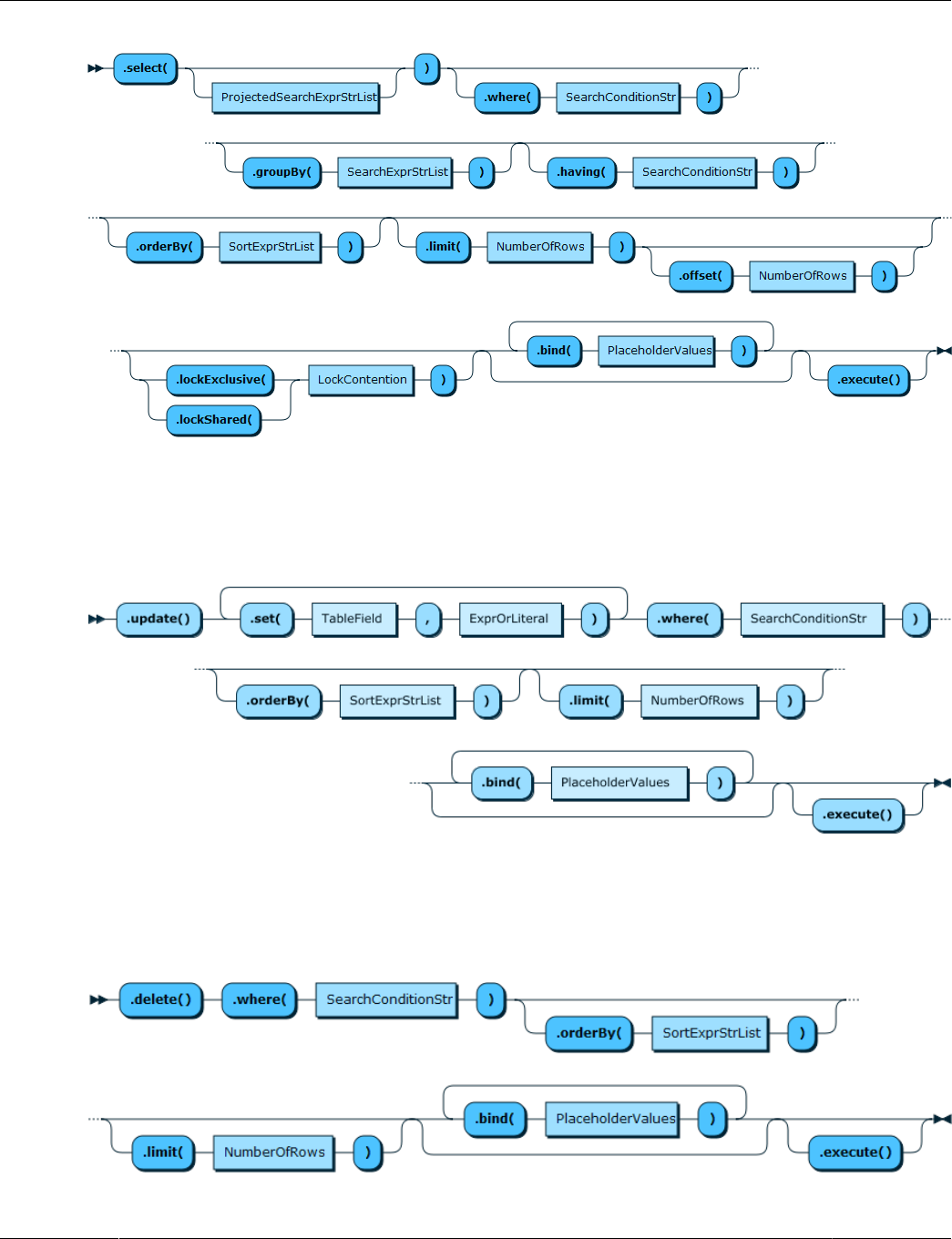
Table.update()
Figure 6.2 Table.select() Syntax Diagram
Table.update()
The Table.update() method works like an UPDATE statement in SQL.
Figure 6.3 Table.update() Syntax Diagram
Table.delete()
The Table.delete() method works like a DELETE statement in SQL.
Figure 6.4 Table.delete() Syntax Diagram
86

Chapter 7 Working with Relational Tables and Documents
Table of Contents
7.1 Collections as Relational Tables .................................................................................................. 87
After seeing how to work with documents and how to work with relational tables, this section explains how
to combine the two and work with both at the same time.
It can be beneficial to use documents for very specific tasks inside an application and rely on relational
tables for other tasks. Or a very simple document only application can outgrow the document model and
incrementally integrate or move to a more powerful relational database. This way the advantages of both
documents and relational tables can be combined. SQL tables contribute strictly typed value semantics,
predictable and optimized storage. Documents contribute type flexibility, schema flexibility and non-scalar
types.
7.1 Collections as Relational Tables
Applications that seek to store standard SQL columns with Documents can cast a collection to a table. In
this case a collection can be fetched as a Table object with the Schema.getCollectionAsTable()
function. From that moment on it is treated as a regular table. Document values can be accessed in SQL
CRUD operations using the following syntax:
doc->'$.field'
doc->'$.field' is used to access the document top level fields. More complex paths can be specified
as well.
doc->'$.some.field.like[3].this'
Once a collection has been fetched as a table with the Schema.getCollectionAsTable() function, all
SQL CRUD operations can be used. Using the syntax for document access, you can select data from the
Documents of the Collection and the extra SQL columns.
The following example shows how to insert a JSON document string into the doc field.
MySQL Shell JavaScript Code
// Get the customers collection as a table
var customers = db.getCollectionAsTable('customers');
customers.insert('doc').values('{"_id":"001", "name": "Ana", "last_name": "Silva"}').execute();
// Now do a find operation to retrieve the inserted document
var result = customers.select(["doc->'$.name'", "doc->'$.last_name'"]).where("doc->'$._id' = '001'").execute();
var record = result.fetchOne();
print ("Name : " + record[0]);
print ("Last Name : " + record[1]);
MySQL Shell Python Code
# Get the customers collection as a table
customers = db.get_collection_as_table('customers')
customers.insert('doc').values('{"_id":"001", "name": "Ana", "last_name": "Silva"}').execute()
# Now do a find operation to retrieve the inserted document
87

Collections as Relational Tables
result = customers.select(["doc->'$.name'", "doc->'$.last_name'"]).where("doc->'$._id' = '001'").execute()
record = result.fetch_one()
print("Name : %s\n" % record[0])
print("Last Name : %s\n" % record[1])
Node.js JavaScript Code
// Get the customers collection as a table
var customers = db.getCollectionAsTable('customers');
customers.insert('doc').values('{"_id":"001", "name": "Ana"}').execute();
C# Code
// Get the customers collection as a table
var customers = db.GetCollectionAsTable("customers");
customers.Insert("doc").Values("{ \"_id\": 1, \"name\": \"Ana\" }").Execute();
Python Code
# Get the customers collection as a table
customers = db.get_collection_as_table("customers")
customers.insert('doc').values({'_id':'001', 'name': 'Ana', 'last_name': 'Silva'}).execute()
# Now do a find operation to retrieve the inserted document
result = customers.select(["doc->'$.name'", "doc->'$.last_name'"]).where("doc->'$._id' = '001'").execute()
record = result.fetch_one()
print('Name : {0}'.format(record[0]))
print('Last Name : {0}'.format(record[1]))
Java Code
// Get the customers collection as a table
Table customers = db.getCollectionAsTable("customers");
customers.insert("doc").values("{\"name\": \"Ana\"}").execute();
C++ Code
// Get the customers collection as a table
Table customers = db.getCollectionAsTable("customers");
customers.insert("doc")
.values(R"({"_id":"001", "name": "Ana", "last_name": "Silva"})").execute();
// Now do a find operation to retrieve the inserted document
RowResult result = customers.select("doc->'$.name'", "doc->'$.last_name'")
.where("doc->'$._id' = '001'").execute();
Row record = result.fetchOne();
cout << "Name : " << record[0] << endl;
cout << "Last Name : " << record[1] << endl;
88

Chapter 8 Statement Execution
Table of Contents
8.1 Transaction Handling .................................................................................................................. 89
8.1.1 Processing Warnings ....................................................................................................... 92
8.1.2 Error Handling ................................................................................................................. 97
8.2 Working with Savepoints ........................................................................................................... 101
8.3 Working with Locking ................................................................................................................ 102
8.4 Working with Prepared Statements ............................................................................................ 103
This section explains statement execution, with information on how to handle transactions and errors.
8.1 Transaction Handling
Transactions can be used to group operations into an atomic unit. Either all operations of a transaction
succeed when they are committed, or none. It is possible to roll back a transaction as long as it has not
been committed.
Transactions can be started in a session using the startTransaction() method, committed with
commitTransaction() and cancelled or rolled back with rollbackTransaction(). This is illustrated
in the following example. The example assumes that the test schema exists and that the collection
my_collection does not exist.
MySQL Shell JavaScript Code
var mysqlx = require('mysqlx');
// Connect to server
var session = mysqlx.getSession( {
host: 'localhost', port: 33060,
user: 'user', password: 'password' } );
// Get the Schema test
var db = session.getSchema('test');
// Create a new collection
var myColl = db.createCollection('my_collection');
// Start a transaction
session.startTransaction();
try {
myColl.add({name: 'Rohit', age: 18, height: 1.76}).execute();
myColl.add({name: 'Misaki', age: 24, height: 1.65}).execute();
myColl.add({name: 'Leon', age: 39, height: 1.9}).execute();
// Commit the transaction if everything went well
session.commit();
print('Data inserted successfully.');
}
catch (err) {
// Rollback the transaction in case of an error
session.rollback();
// Printing the error message
print('Data could not be inserted: ' + err.message);
}
89

Transaction Handling
MySQL Shell Python Code
from mysqlsh import mysqlx
# Connect to server
mySession = mysqlx.get_session( {
'host': 'localhost', 'port': 33060,
'user': 'user', 'password': 'password' } )
# Get the Schema test
myDb = mySession.get_schema('test')
# Create a new collection
myColl = myDb.create_collection('my_collection')
# Start a transaction
mySession.start_transaction()
try:
myColl.add({'name': 'Rohit', 'age': 18, 'height': 1.76}).execute()
myColl.add({'name': 'Misaki', 'age': 24, 'height': 1.65}).execute()
myColl.add({'name': 'Leon', 'age': 39, 'height': 1.9}).execute()
# Commit the transaction if everything went well
mySession.commit()
print('Data inserted successfully.')
except Exception as err:
# Rollback the transaction in case of an error
mySession.rollback()
# Printing the error message
print('Data could not be inserted: %s' % str(err))
C# Code
// Connect to server
var session = MySQLX.GetSession("server=localhost;port=33060;user=user;password=password;");
// Get the Schema test
var db = session.GetSchema("test");
// Create a new collection
var myColl = db.CreateCollection("my_collection");
// Start a transaction
session.StartTransaction();
try
{
myColl.Add(new { name = "Rohit", age = 18, height = 1.76}).Execute();
myColl.Add(new { name = "Misaki", age = 24, height = 1.65}).Execute();
myColl.Add(new { name = "Leon", age = 39, height = 1.9}).Execute();
// Commit the transaction if everything went well
session.Commit();
Console.WriteLine("Data inserted successfully.");
}
catch(Exception err)
{
// Rollback the transaction in case of an error
session.Rollback();
// Printing the error message
Console.WriteLine("Data could not be inserted: " + err.Message);
}
Python Code
90

Transaction Handling
import mysqlx
# Connect to server
my_session = mysqlx.get_session({
'host': 'localhost', 'port': 33060,
'user': 'user', 'password': 'password'
})
# Get the Schema test
my_schema = my_session.get_schema('test')
# Create a new collection
my_coll = my_schema.create_collection('my_collection')
# Start a transaction
session.start_transaction()
try:
my_coll.add({'name': 'Rohit', 'age': 18, 'height': 1.76}).execute()
my_coll.add({'name': 'Misaki', 'age': 24, 'height': 1.65}).execute()
my_coll.add({'name': 'Leon', 'age': 39, 'height': 1.9}).execute()
# Commit the transaction if everything went well
my_session.commit()
print('Data inserted successfully.')
except Exception as err:
# Rollback the transaction in case of an error
my_session.rollback()
# Printing the error message
print('Data could not be inserted: {0}'.format(str(err)))
Java Code
import com.mysql.cj.xdevapi.*;
// Connect to server
Session mySession = new SessionFactory().getSession("mysqlx://localhost:33060/test?user=user&password=password");
Schema db = mySession.getSchema("test");
// Create a new collection
Collection myColl = db.createCollection("my_collection");
// Start a transaction
mySession.startTransaction();
try {
myColl.add("{\"name\":\"Rohit\", \"age\":18}", "{\"name\":\"Misaki\", \"age\":24}", "{\"name\":\"Leon\", \"age\":39}");
mySession.commit();
System.out.println("Data inserted successfully.");
} catch (Exception err) {
// Rollback the transaction in case of an error
mySession.rollback();
// Printing the error message
System.out.println("Data could not be inserted: " + err.getMessage());
}
C++ Code
// Connect to server
Session session(SessionOption::HOST, "localhost",
SessionOption::PORT, 33060,
SessionOption::USER, "user",
SessionOption::PWD, "password");
91

Processing Warnings
// Get the Schema test
Schema db = session.getSchema("test");
// Create a new collection
Collection myColl = db.createCollection("my_collection");
// Start a transaction
session.startTransaction();
try {
myColl.add(R"({"name": "Rohit", "age": 18, "height": 1.76})").execute();
myColl.add(R"({"name": "Misaki", "age": 24, "height": 1.65})").execute();
myColl.add(R"({"name": "Leon", "age": 39, "height": 1.9})").execute();
// Commit the transaction if everything went well
session.commit();
cout << "Data inserted successfully." << endl;
}
catch (const Error &err) {
// Rollback the transaction in case of an error
session.rollback();
// Printing the error message
cout << "Data could not be inserted: " << err << endl;
}
8.1.1 Processing Warnings
Similar to the execution of single statements committing or rolling back a transaction can also trigger
warnings. To be able to process these warnings the replied result object of Session.commit(); or
Session.rollback(); needs to be checked.
This is shown in the following example. The example assumes that the test schema exists and that the
collection my_collection does not exist.
MySQL Shell JavaScript Code
var mysqlx = require('mysqlx');
// Connect to server
var mySession = mysqlx.getSession( {
host: 'localhost', port: 33060,
user: 'user', password: 'password' } );
// Get the Schema test
var myDb = mySession.getSchema('test');
// Create a new collection
var myColl = myDb.createCollection('my_collection');
// Start a transaction
mySession.startTransaction();
try
{
myColl.add({'name': 'Rohit', 'age': 18, 'height': 1.76}).execute();
myColl.add({'name': 'Misaki', 'age': 24, 'height': 1.65}).execute();
myColl.add({'name': 'Leon', 'age': 39, 'height': 1.9}).execute();
// Commit the transaction if everything went well
var reply = mySession.commit();
// handle warnings
if (reply.warningCount){
var warnings = reply.getWarnings();
92

Processing Warnings
for (index in warnings){
var warning = warnings[index];
print ('Type ['+ warning.level + '] (Code ' + warning.code + '): ' + warning.message + '\n');
}
}
print ('Data inserted successfully.');
}
catch(err)
{
// Rollback the transaction in case of an error
reply = mySession.rollback();
// handle warnings
if (reply.warningCount){
var warnings = reply.getWarnings();
for (index in warnings){
var warning = warnings[index];
print ('Type ['+ warning.level + '] (Code ' + warning.code + '): ' + warning.message + '\n');
}
}
// Printing the error message
print ('Data could not be inserted: ' + err.message);
}
MySQL Shell Python Code
from mysqlsh import mysqlx
# Connect to server
mySession = mysqlx.get_session( {
'host': 'localhost', 'port': 33060,
'user': 'user', 'password': 'password' } )
# Get the Schema test
myDb = mySession.get_schema('test')
# Create a new collection
myColl = myDb.create_collection('my_collection')
# Start a transaction
mySession.start_transaction()
try:
myColl.add({'name': 'Rohit', 'age': 18, 'height': 1.76}).execute()
myColl.add({'name': 'Misaki', 'age': 24, 'height': 1.65}).execute()
myColl.add({'name': 'Leon', 'age': 39, 'height': 1.9}).execute()
# Commit the transaction if everything went well
reply = mySession.commit()
# handle warnings
if reply.warning_count:
for warning in result.get_warnings():
print('Type [%s] (Code %s): %s\n' % (warning.level, warning.code, warning.message))
print('Data inserted successfully.')
except Exception as err:
# Rollback the transaction in case of an error
reply = mySession.rollback()
# handle warnings
if reply.warning_count:
for warning in result.get_warnings():
print('Type [%s] (Code %s): %s\n' % (warning.level, warning.code, warning.message))
93

Processing Warnings
# Printing the error message
print('Data could not be inserted: %s' % str(err))
C# Code
// Connect to server
var session = MySQLX.GetSession("server=localhost;port=33060;user=user;password=password;");
// Get the Schema test
var db = session.GetSchema("test");
// Create a new collection
var myColl = db.CreateCollection("my_collection");
// Start a transaction
session.StartTransaction();
int warningCount = 0;
try
{
var result = myColl.Add(new { name = "Rohit", age = 18, height = 1.76}).Execute();
warningCount += result.Warnings.Count;
result = myColl.Add(new { name = "Misaki", age = 24, height = 1.65}).Execute();
warningCount += result.Warnings.Count;
result = myColl.Add(new { name = "Leon", age = 39, height = 1.9}).Execute();
warningCount += result.Warnings.Count;
// Commit the transaction if everything went well
session.Commit();
if(warningCount > 0)
{
// handle warnings
}
Console.WriteLine("Data inserted successfully.");
}
catch (Exception err)
{
// Rollback the transaction in case of an error
session.Rollback();
if(warningCount > 0)
{
// handle warnings
}
// Printing the error message
Console.WriteLine("Data could not be inserted: " + err.Message);
}
Python Code
import mysqlx
# Connect to server
my_session = mysqlx.get_session({
'host': 'localhost', 'port': 33060,
'user': 'user', 'password': 'password'
})
# Get the Schema test
my_schema = my_session.get_schema('test')
# Create a new collection
my_coll = my_schema.create_collection('my_collection')
# Start a transaction
my_session.start_transaction()
94

Processing Warnings
try:
my_coll.add({'name': 'Rohit', 'age': 18, 'height': 1.76}).execute()
my_coll.add({'name': 'Misaki', 'age': 24, 'height': 1.65}).execute()
my_coll.add({'name': 'Leon', 'age': 39, 'height': 1.9}).execute()
# Commit the transaction if everything went well
result = my_session.commit()
# handle warnings
if result.get_warnings_count() > 0:
for warning in result.get_warnings():
print('Type [{0}] (Code {1}): {2}'.format(warning['level'], warning['code'], warning['msg']))
print('Data inserted successfully.')
except Exception as err:
# Rollback the transaction in case of an error
result = my_session.rollback()
# handle warnings
if result.get_warnings_count() > 0:
for warning in result.get_warnings():
print('Type [{0}] (Code {1}): {2}'.format(warning['level'], warning['code'], warning['msg']))
# Printing the error message
print('Data could not be inserted: {0}'.format(err))
Java Code
// c.f. "standard transaction handling"
C++ Code
/*
Connector/C++ does not yet provide access to transaction warnings
-- Session methods commit() and rollback() do not return a result object.
*/
By default all warnings are sent from the server to the client. If an operation is known to generate
many warnings and the warnings are of no value to the application then sending the warnings can be
suppressed. This helps to save bandwith. session.setFetchWarnings() controls whether warnings
are discarded at the server or are sent to the client. session.getFetchWarnings() is used to learn the
currently active setting.
MySQL Shell JavaScript Code
var mysqlx = require('mysqlx');
function process_warnings(result){
if (result.getWarningCount()){
var warnings = result.getWarnings();
for (index in warnings){
var warning = warnings[index];
print ('Type ['+ warning.level + '] (Code ' + warning.code + '): ' + warning.message + '\n');
}
}
else{
print ("No warnings were returned.\n");
}
}
// Connect to server
var mySession = mysqlx.getSession( {
host: 'localhost', port: 33060,
user: 'user', password: 'password' } );
95

Processing Warnings
// Disables warning generation
mySession.setFetchWarnings(false);
var result = mySession.sql('drop schema if exists unexisting').execute();
process_warnings(result);
// Enables warning generation
mySession.setFetchWarnings(true);
var result = mySession.sql('drop schema if exists unexisting').execute();
process_warnings(result);
MySQL Shell Python Code
from mysqlsh import mysqlx
def process_warnings(result):
if result.get_warnings_count():
for warning in result.get_warnings():
print('Type [%s] (Code %s): %s\n' % (warning.level, warning.code, warning.message))
else:
print("No warnings were returned.\n")
# Connect to server
mySession = mysqlx.get_session( {
'host': 'localhost', 'port': 33060,
'user': 'user', 'password': 'password' } );
# Disables warning generation
mySession.set_fetch_warnings(False)
result = mySession.sql('drop schema if exists unexisting').execute()
process_warnings(result)
# Enables warning generation
mySession.set_fetch_warnings(True)
result = mySession.sql('drop schema if exists unexisting').execute()
process_warnings(result)
Java Code
// Connect to server
Session mySession = new SessionFactory().getSession("mysqlx://localhost:33060/test?user=user&password=password");
Schema db = mySession.getSchema("test");
// Create a new collection
Collection myColl = db.createCollection("my_collection");
// Start a transaction
mySession.startTransaction();
try {
Result res = myColl.add("{\"name\":\"Rohit\", \"age\":18}", "{\"name\":\"Misaki\", \"age\":24}", "{\"name\":\"Leon\", \"age\":39}").execute();
System.out.println(res.getWarningsCount());
Iterator<Warning> warnings = res.getWarnings();
while (warnings.hasNext()) {
Warning warn = warnings.next();
System.out.println(warn.getCode() + ", " + warn.getLevel() + ", " + warn.getMessage());
}
mySession.commit();
System.out.println("Data inserted successfully.");
} catch (Exception err) {
// Rollback the transaction in case of an error
mySession.rollback();
96

Error Handling
// Printing the error message
System.out.println("Data could not be inserted: " + err.getMessage());
}
8.1.2 Error Handling
When writing scripts for MySQL Shell you can often simply rely on the exception handling done by MySQL
Shell. For all other languages either proper exception handling is required to catch errors or the traditional
error handling pattern needs to be used if the language does not support exceptions.
The default error handling can be changed by creating a custom SessionContext and passing it to the
mysqlx.getSession() function. This enables switching from exceptions to result based error checking.
The following example shows how to perform proper error handling. The example assumes that the test
schema exists and that the collection my_collection exists.
MySQL Shell JavaScript Code
var mysqlx = require('mysqlx');
var mySession;
try {
// Connect to server on localhost
mySession = mysqlx.getSession( {
host: 'localhost', port: 33060,
user: 'user', password: 'password' } );
}
catch (err) {
print('The database session could not be opened: ' + err.message);
}
try {
var myDb = mySession.getSchema('test');
// Use the collection 'my_collection'
var myColl = myDb.getCollection('my_collection');
// Find a document
var myDoc = myColl.find('name like :param').limit(1)
.bind('param','L%').execute();
// Print document
print(myDoc.first());
}
catch (err) {
print('The following error occurred: ' + err.message);
}
finally {
// Close the session in any case
mySession.close();
}
MySQL Shell Python Code
from mysqlsh import mysqlx
mySession
try:
# Connect to server on localhost
mySession = mysqlx.get_session( {
97

Error Handling
'host': 'localhost', 'port': 33060,
'user': 'user', 'password': 'password' } )
except Exception as err:
print('The database session could not be opened: %s' % str(err))
try:
myDb = mySession.get_schema('test')
# Use the collection 'my_collection'
myColl = myDb.get_collection('my_collection')
# Find a document
myDoc = myColl.find('name like :param').limit(1).bind('param','L%').execute()
# Print document
print(myDoc.first())
except Exception as err:
print('The following error occurred: %s' % str(err))
finally:
# Close the session in any case
mySession.close()
Node.js JavaScript Code
var mysqlx = require('@mysql/xdevapi');
// Connect to server on localhost
mysqlx
.getSession({
host: 'localhost',
port: 33060,
user: 'user',
password: 'password'
})
.then(function (mySession) {
// This can't throw an error as we check existence at a later operation only
var myDb = mySession.getSchema('test');
// Use the collection 'my_collection'
// This can't throw an error as we check existence at a later operation only
var myColl = myDb.getCollection('my_collection');
// Find a document
return myColl
.find('name like :param')
.limit(1)
.bind('param','L%')
.execute(function (row) {
console.log(row);
})
.then(function () {
return session.close();
})
.catch(function (err) {
console.log('The following error occurred: ' + err.message);
});
})
.catch (err) {
console.log('The database session could not be opened: ' + err.message);
});
C# Code
Session mySession = null;
try
98

Error Handling
{
// Connect to server on localhost
mySession = MySQLX.GetSession("mysqlx://user:password@localhost:33060");
try
{
Schema myDb = mySession.GetSchema("test");
// Use the collection 'my_collection'
Collection myColl = myDb.GetCollection("my_collection");
// Find a document
DocResult myDoc = myColl.Find("name like :param").Limit(1).Bind("param", "L%").Execute();
// Print document
Console.WriteLine(myDoc.FetchOne());
}
catch (Exception err)
{
Console.WriteLine("The following error occurred: " + err.Message);
}
finally
{
// Close the session in any case
mySession.Close();
}
}
catch (Exception err)
{
Console.WriteLine("The database session could not be opened: " + err.Message);
}
Python Code
import mysqlx
# Connect to server
my_session = mysqlx.get_session({
'host': 'localhost', 'port': 33060,
'user': 'user', 'password': 'password'
})
# Get the Schema test
my_schema = my_session.get_schema('test')
# Create a new collection
my_coll = my_schema.create_collection('my_collection')
# Start a transaction
my_session.start_transaction()
try:
my_coll.add({'name': 'Rohit', 'age': 18, 'height': 1.76}).execute()
my_coll.add({'name': 'Misaki', 'age': 24, 'height': 1.65}).execute()
my_coll.add({'name': 'Leon', 'age': 39, 'height': 1.9}).execute()
# Commit the transaction if everything went well
result = my_session.commit()
# handle warnings
if result.get_warnings_count() > 0:
for warning in result.get_warnings():
print('Type [{0}] (Code {1}): {2}'.format(warning['level'], warning['code'], warning['msg']))
print('Data inserted successfully.')
except Exception as err:
# Rollback the transaction in case of an error
my_session.rollback()
99

Error Handling
# handle warnings
if reply.get_warnings_count() > 0:
for warning in result.get_warnings():
print('Type [{0}] (Code {1}): {2}'.format(warning['level'], warning['code'], warning['msg']))
# Printing the error message
print('Data could not be inserted: {0}'.format(err))
Java Code
import com.mysql.cj.xdevapi.*;
Session mySession;
try {
// Connect to server on localhost
mySession = new SessionFactory().getSession("mysqlx://localhost:33060/test?user=user&password=password");
try {
Schema myDb = mySession.getSchema("test");
// Use the collection 'my_collection'
Collection myColl = myDb.getCollection("my_collection");
// Find a document
DocResult myDoc = myColl.find("name like :param").limit(1).bind("param", "L%").execute();
// Print document
System.out.println(myDoc.fetchOne());
} catch (XDevAPIError err) { // special exception class for server errors
System.err.println("The following error occurred: " + err.getMessage());
} finally {
// Close the session in any case
mySession.close();
}
} catch (Exception err) {
System.err.println("The database session could not be opened: " + err.getMessage());
}
C++ Code
#include <mysqlx/xdevapi.h>
try
{
// Connect to server on localhost
Session session(33060, "user", "password");
try
{
Schema db = session.getSchema("test");
// Use the collection 'my_collection'
Collection myColl = db.getCollection("my_collection");
// Find a document
auto myDoc = myColl.find("name like :param").limit(1)
.bind("param", "L%").execute();
// Print document
cout << myDoc.fetchOne() << endl;
// Exit with success code
exit(0);
}
100

Working with Savepoints
catch (const Error &err)
{
cout << "The following error occurred: " << err << endl;
exit(1);
}
// Note: session is closed automatically when session object
// is destructed.
}
catch (const Error &err)
{
cout << "The database session could not be opened: " << err << endl;
// Exit with error code
exit(1);
}
8.2 Working with Savepoints
X DevAPI supports savepoints, which enable you to set a named point within a transaction that you can
revert to. By setting savepoints within a transaction, you can later use the rollback functionality to undo
any statements issued after setting the savepoint. Savepoints can be released if you no longer require
them. This section documents how to work with savepoints in X DevAPI. See SAVEPOINT for background
information.
Setting a Savepoint
Savepoints are identified by a string name. The string can contain any character allowed for an identifier.
To create a savepoint, use the session.setSavepoint() operation, which maps to the SQL statement
SAVEPOINT name;. If you do not specify a name, one is automatically generated. For example by issuing:
session.setSavepoint()
a transaction savepoint is created with an automatically generated name and a string is returned
with the name of the savepoint. This name can be used with the session.rollbackTo() or
session.releaseSavepoint() operations. The session.setSavepoint() operation can be called
multiple times within a session and each time a unique savepoint name is generated.
It is also possible to manually define the name of the savepoint by passing in a string name. For example
issuing:
session.setSavepoint('name')
results in a transaction savepoint with the specified name, which is returned by the operation as a string.
The session.setSavepoint('name') operation can be called multiple times in this way, and if the
name has already been used for a savepoint then the previous savepoint is is deleted and a new one is
set.
Rolling Back to a Savepoint
When a session has transaction savepoints, you can undo any subsequent transactions using the
session.rollbackTo() operation, which maps to the ROLLBACK TO name statement. For example,
issuing:
session.rollbackTo('name')
rolls back to the transaction savepoint name. This operation succeeds as long as the given savepoint has
not been released. Rolling back to a savepoint which was created prior to other savepoints results in the
subsequent savepoints being either released or rolled back. For example:
101

Releasing a Savepoint
session.startTransaction()
(some data modifications occur...)
session.setSavepoint('point1') <---- succeeds
(some data modifications occur...)
session.setSavepoint('point2') <---- succeeds
(some data modifications occur...)
session.rollbackTo('point1') <---- succeeds
session.rollbackTo('point1') <---- still succeeds, but position stays the same
session.rollbackTo('point2') <---- generates an error because lines above already cleared point2
session.rollbackTo('point1') <---- still succeeds
Releasing a Savepoint
To cancel a savepoint, for example when it is no longer needed, use releaseSavepoint() and pass in
the name of the savepoint you want to release. For example, issuing:
session.releaseSavepoint('name')
releases the savepoint name.
Savepoints and Implicit Transaction Behavior
The exact behavior of savepoints is defined by the server, and specifically how autocommit is configured.
See autocommit, Commit, and Rollback.
For example, consider the following statements with no explicit BEGIN, session.startTransaction()
or similar call:
session.setSavepoint('testsavepoint');
session.releaseSavepoint('testsavepoint');
If autocommit mode is enabled on the server, these statements result in an error because the savepoint
named testsavepoint does not exist. This is because the call to session.setSavepoint() creates
a transaction, then the savepoint and directly commits it. The result is that savepoint does not exist by the
time the call to releaseSavepoint() is issued, which is instead in its own transaction. In this case, for
the savepoint to survive you need to start an explicit transaction block first.
8.3 Working with Locking
X DevAPI supports MySQL locking through the lockShared() and lockExclusive() methods
for the Collection.find() and Table.select() methods. This enables you to control row locking to
ensure safe, transactional document updates on collections and to avoid concurrency problems, for
example when using the modify() method. This section describes how to use the lockShared()
and lockExclusive() methods for both the Collection.find() and Table.select() methods. For more
background information on locking, see Locking Reads.
The lockShared() and lockExclusive() methods have the following properties, whether they are
used with a Collection or a Table.
• Multiple calls to the lock methods are permitted. If a locking statement executes while a different
transaction holds the same lock, it blocks until the other transaction releases it. If multiple calls
to the lock methods are made, the last called lock method takes precedence. In other words
find().lockShared().lockExclusive() is equivalent to find().lockExclusive().
• lockShared() has the same semantics as SELECT ... LOCK IN SHARE MODE. Sets a shared
mode lock on any rows that are read. Other sessions can read the rows, but cannot modify them until
102

Locking considerations
your transaction commits. If any of these rows were changed by another transaction that has not yet
committed, your query waits until that transaction ends and then uses the latest values.
• lockExclusive() has the same semantics as SELECT ... FOR UPDATE. For any index records the
search encounters, it locks the rows and any associated index entries, in the same way as if you issued
an UPDATE statement for those rows. Other transactions are blocked from updating those rows, from
doing SELECT ... LOCK IN SHARE MODE, or from reading the data in certain transaction isolation
levels. Consistent reads ignore any locks set on the records that exist in the read view. Old versions of
a record cannot be locked; they are reconstructed by applying undo logs on an in-memory copy of the
record.
• Locks are held for as long as the transaction which they were acquired in exists. They are immediately
released after the statement finishes unless a transaction is open or autocommit mode is turned off.
Both locking methods support the NOWAIT and SKIP LOCKED InnoDB locking modes. For more
information see Locking Read Concurrency with NOWAIT and SKIP LOCKED. To use these locking
modes with the locking methods, pass in one of the following:
• NOWAIT - if the function encounters a row lock it aborts and generates an ER_LOCK_NOWAIT error
• SKIP_LOCKED - if the function encounters a row lock it skips the row and continues
• DEFAULT - if the function encounters a row lock it waits until there is no lock. The equivalent of calling
the lock method without a mode.
Locking considerations
When working with locking modes note the following:
• autocommit mode means that there is always a transaction open, which is commited automatically
when an SQL statement executes.
• By default sessions are in autocommit mode.
• You disable autocommit mode implicitly when you call startTransaction().
• When in autocommit mode, if a lock is acquired, it is released after the statement finishes. This could
lead you to conclude that the locks were not acquired, but that is not the case.
• Similarly, if you try to acquire a lock that is already owned by someone else, the statement blocks until
the other lock is released.
8.4 Working with Prepared Statements
X DevAPI improves performance for each CRUD statement that is executed repeatedly by using a server-
side prepared statement for its second and subsequent executions. This happens internally—applications
do not need to do anything extra to utilize the feature, as long as the same operation object is reused.
When a statement is executed for a second time with changes only in data values or in values that refine
the execution results (for example, different offset() or limit() values), the server prepares the
statement for subsequent executions, so that there is no need to reparse the statement when it is being
run again. New values for re-executions of the prepared statement are provided with parameter binding.
When the statement is modified by chaining to it a method that refines the result (for example, sort(),
limit(), or offset()), the statement is reprepared. The following pseudocode and the comments on
them demonstrate the feature:
var f = coll.find("field = :field");
103

Working with Prepared Statements
f.bind("field", 1).execute(); // Normal execution
f.bind("field", 2).execute(); // Same statement executed with a different parameter value triggers statement preparation
f.bind("field", 3).execute(); // Prepared statement executed with a new value
f.bind("field", 3).limit(10).execute(); // Statement reprepared as it is modified with limit()
f.bind("field", 4).limit(20).execute(); // Reprepared statement executed with new parameters
Notice that to take advantage of the feature, the same operation object must be reused in the repetitions of
the statement. Look at this example
for (i=0; i<100; ++i) {
coll.find("field = :field").bind("field", i).execute();
}
This loop cannot take advantage of the prepared statement feature, because the operation object of
coll.find() is recreated at each iteration of the for loop. Now, look at this example:
var f = coll.find("field = :field");
for (i=0; i<100; ++i) {
f.bind("field", i).execute();
}
The repeated statement is prepared once and then reused, as the same operation of coll.find() is re-
executed for each iteration of the for loop.
Prepared statements are part of a Session. When a Client resets the Session (by using, for example,
Mysqlx.Session.Reset), the prepared statements are dropped.
104

Chapter 9 Working with Result Sets
Table of Contents
9.1 Result Set Classes ................................................................................................................... 105
9.2 Working with AUTO-INCREMENT Values .................................................................................... 106
9.3 Working with Data Sets ............................................................................................................ 106
9.4 Fetching All Data Items at Once ................................................................................................ 110
9.5 Working with SQL Result Sets .................................................................................................. 112
9.6 Working with Metadata ............................................................................................................. 122
9.7 Support for Language Native Iterators ....................................................................................... 123
This section explains how to work with result sets returned by database operations.
9.1 Result Set Classes
All database operations return a result. The type of result returned depends on the operation that was
executed. The different types of results are outlined in the following table.
Table 9.1 The Result Classes and the Information They Provide
Result Class Returned By Provides
Result add().execute(),
insert().execute(),
modify().execute(),
update().execute() ,
remove().execute(),
delete().execute()
Number of rows affected by
the operation, auto generated
document IDs, last auto-
generated AUTO INCREMENT
column values, or warnings,
depending on the operation for
which Result is returned.
SqlResult session.sql().execute() Number of rows affected by
the operation, auto generated
document IDs, last auto-
generated AUTO INCREMENT
column values, warnings, or
fetched data set, depending
on the operation for which
SqlResult is returned.
DocResult find().execute() The fetched data set
RowResult select.execute() The fetched data set
The following class diagram gives a basic overview of the result classes and their functions.
105
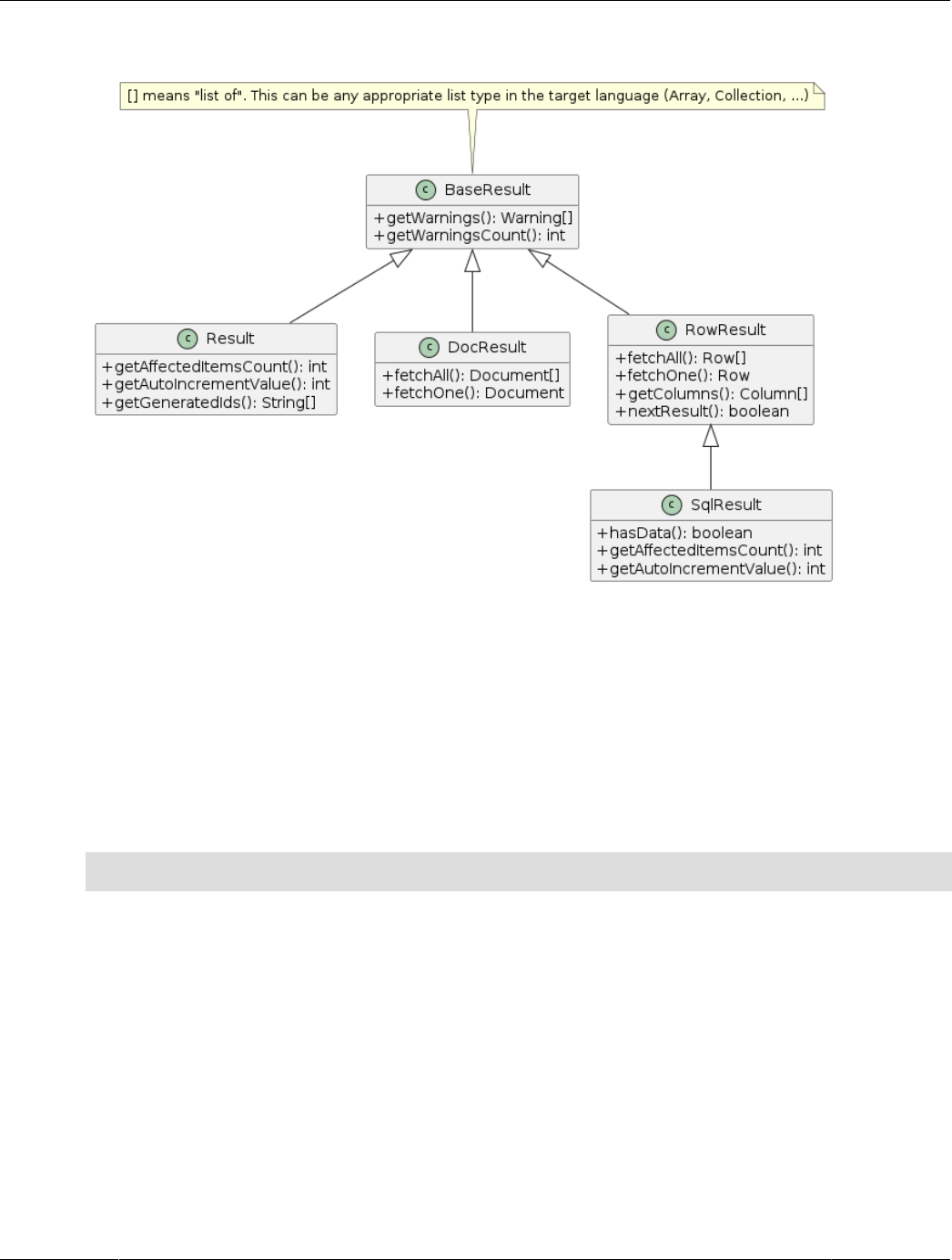
Working with AUTO-INCREMENT Values
Figure 9.1 Result Classes
9.2 Working with AUTO-INCREMENT Values
AUTO_INCREMENT columns can be used in MySQL for generating primary key or id values, but are not
limited to these uses. This section explains how to retrieve AUTO_INCREMENT values when adding rows
using X DevAPI. For more background information, see Using AUTO_INCREMENT.
X DevAPI provides the getAutoIncrementValue() method to return the first AUTO_INCREMENT
column value that was successfully inserted by the operation, taken from the return value of
table.insert(). In the following example it is assumed that the table contains a PRIMARY KEY column
for which the AUTO_INCREMENT attribute is set:
res = myTable.insert(['name']).values('Mats').values('Otto').execute();
print(res.getAutoIncrementValue());
This table.insert() operation inserted multiple rows. getAutoIncrementValue() returns the
AUTO_INCREMENT column value generated for the first inserted row only, so in this example, for the row
containing “Mats”. The reason for this is to make it possible to reproduce easily the same operation against
some other server.
9.3 Working with Data Sets
Operations that fetch data items return a cursor that can be used to consume those data items from the
result set. Data items can be read from the database using Collection.find(), Table.select()
and Session.sql(). Collection.find() returns a data set with documents and Table.select()
respectively Session.sql() return a data set with rows.
All result sets implement a unified way of iterating their data items. The unified syntax supports fetching
items one by one using fetchOne() or retrieving a list of all items using fetchAll(). fetchOne() and
106

Working with Data Sets
fetchAll() follow forward-only iteration semantics. Connectors implementing the X DevAPI can offer
more advanced iteration patterns on top to match common native language patterns.
The following example shows how to access the documents returned by a Collection.find()
operation by using fetchOne() to loop over all documents.
The first call to fetchOne() returns the first document found. All subsequent calls increment the internal
data item iterator cursor by one position and return the item found making the second call to fetchOne()
return the second document found, if any. When the last data item has been read and fetchOne()
is called again, a NULL value is returned. This ensures that the basic while loop shown works with all
languages that support such an implementation.
When using fetchOne(), it is not possible to reset the internal data item cursor to the first data item
to start reading the data items again. A data item (here a Document) that has been fetched once using
fetchOne() can be discarded by the Connector. The data item's life time is decoupled from the data
set. From a Connector perspective items are consumed by the caller as they are fetched. This example
assumes that the test schema exists.
MySQL Shell JavaScript Code
var myColl = db.getCollection('my_collection');
var res = myColl.find('name like :name').bind('name','L%').
execute();
var doc;
while (doc = res.fetchOne()) {
print(doc);
}
MySQL Shell Python Code
myColl = db.get_collection('my_collection')
res = myColl.find('name like :name').bind('name','L%').execute()
doc = res.fetch_one()
while doc:
print(doc)
doc = res.fetch_one()
C# Code
var myColl = db.GetCollection("my_collection");
var res = myColl.Find("name like :name").Bind("name", "L%")
.Execute();
DbDoc doc;
while ((doc = res.FetchOne()) != null)
{
Console.WriteLine(doc);
}
Python Code
my_coll = db.get_collection('my_collection')
res = my_coll.find('name like :name').bind('name', 'L%').execute()
doc = res.fetch_one()
107

Working with Data Sets
while doc:
print(doc)
doc = res.fetch_one()
Java Code
Collection myColl = db.getCollection("my_collection");
DocResult res = myColl.find("name like :name").bind("name", "L%")
.execute();
DbDoc doc;
while ((doc = res.fetchOne()) != null) {
System.out.println(doc);
}
C++ Code
Collection myColl = db.getCollection("my_collection");
DocResult res = myColl.find("name like :name").bind("name", "L%").execute();
DbDoc doc;
while ((doc = res.fetchOne()))
{
cout << doc <<endl;
}
Node.js JavaScript Code
var myColl = db.getCollection('my_collection');
myColl.find('name like :name')
.bind('name', 'L%')
.execute()
.then(res => {
while (doc = res.fetchOne()) {
console.log(doc);
}
});
myColl.find('name like :name')
.bind('name', 'L%')
.execute(function (doc) {
console.log(doc);
});
When using Node.js, results can also be returned to a callback function, which is passed to execute() in
an asychronous manner whenever results from the server arrive.
var myColl = db.getCollection('my_collection');
myColl.find('name like :name')
.bind('name', 'L%')
.execute(function (doc) {
console.log(doc);
});
The following example shows how to directly access the rows returned by a Table.select() operation.
The basic code pattern for result iteration is the same. The difference between the following and the
previous example is in the data item handling. Here, fetchOne() returns Rows. The exact syntax to
access the column values of a Row is language dependent. Implementations seek to provide a language
native access pattern. The example assumes that the test schema exists and that the employee table
exists in myTable.
108

Working with Data Sets
MySQL Shell JavaScript Code
var myRows = myTable.select(['name', 'age']).
where('name like :name').bind('name','L%').
execute();
var row;
while (row = myRows.fetchOne()) {
// Accessing the fields by array
print('Name: ' + row['name'] + '\n');
// Accessing the fields by dynamic attribute
print(' Age: ' + row.age + '\n');
}
MySQL Shell Python Code
myRows = myTable.select(['name', 'age']).where('name like :name').bind('name','L%').execute()
row = myRows.fetch_one()
while row:
# Accessing the fields by array
print('Name: %s\n' % row[0])
# Accessing the fields by dynamic attribute
print('Age: %s\n' % row.age)
row = myRows.fetch_one()
Node.js JavaScript Code
var myRows = myTable
.select(['name', 'age'])
.where('name like :name')
.bind('name','L%')
.execute(function (row) {
// Connector/Node.js does not support referring to row columns by their name yet.
// One needs to access fields by their array index.
console.log('Name: ' + row[0]);
console.log(' Age: ' + row[1]);
});
Alternatively, you can use callbacks:
myTable.select(['name', 'age'])
.where('name like :name')
.bind('name', 'L%')
.execute()
.then(myRows => {
while (var row = myRows.fetchOne()) {
// Accessing the fields by array
console.log('Name: ' + row[0] + '\n');
console.log('Age: ' + row[1] + '\n');
}
});
C# Code
var myRows = myTable.Select("name", "age")
.Where("name like :name").Bind("name", "L%")
.Execute();
Row row;
while ((row = myRows.FetchOne()) != null)
{
// Accessing the fields by array
Console.WriteLine("Name: " + row[0]);
109

Fetching All Data Items at Once
// Accessing the fields by name
Console.WriteLine("Age: " + row["age"]);
}
Python Code
rows = my_table.select(['name', 'age']).where('name like :name').bind('name','L%').execute()
row = rows.fetch_one()
while row:
# Accessing the fields by array
print('Name: {0}'.format(row[0]))
# Accessing the fields by dynamic attribute
print('Age: {0}'.format(row['age'])
row = rows.fetch_one()
Java Code
RowResult myRows = myTable.select("name, age")
.where("name like :name").bind("name", "L%")
.execute();
Row row;
while ((row = myRows.fetchOne()) != null) {
// Accessing the fields
System.out.println(" Age: " + row.getInt("age") + "\n");
}
C++ Code
RowResult myRows = myTable.select("name", "age")
.where("name like :name")
.bind("name", "L%")
.execute();
Row row;
while ((row = myRows.fetchOne()))
{
// Connector/C++ does not support referring to row columns by their name yet.
cout <<"Name: " << row[0] <<endl;
cout <<" Age: " << row[1] <<endl;
int age = row[1];
// One needs explicit .get<int>() as otherwise operator<() is ambiguous
bool uforty = row[age].get<int>() < 40;
// Alternative formulation
bool uforty = (int)row[age] < 40;
}
9.4 Fetching All Data Items at Once
In addition to the pattern of using fetchOne() explained at Section 9.3, “Working with Data Sets”,
which enables applications to consume data items one by one, X DevAPI also provides a pattern using
fetchAll(), which passes all data items of a data set as a list to the application. The different X DevAPI
implementations use appropriate data types for their programming language for the list. Because different
data types are used, the language's native constructs are supported to access the list elements. The
following example assumes that the test schema exists and that the employee table exists in myTable.
MySQL Shell JavaScript Code
var myResult = myTable.select(['name', 'age']).
where('name like :name').bind('name','L%').
110

Fetching All Data Items at Once
execute();
var myRows = myResult.fetchAll();
for (index in myRows){
print (myRows[index].name + " is " + myRows[index].age + " years old.");
}
MySQL Shell Python Code
myResult = myTable.select(['name', 'age']) \
.where('name like :name').bind('name','L%') \
.execute()
myRows = myResult.fetch_all()
for row in myRows:
print("%s is %s years old." % (row.name, row.age))
Node.js JavaScript Code
myTable.select(['name', 'age'])
.where('name like :name')
.bind('name', 'L%')
.execute()
.then(myResult => {
var myRows = myResult.fetchAll();
myRows.forEach(row => {
console.log(`${row[0]} is ${row[1]} years old.`);
});
});
C# Code
var myRows = myTable.Select("name", "age")
.Where("name like :name").Bind("name", "L%")
.Execute();
var rows = myRows.FetchAll();
Python Code
result = myTable.select(['name', 'age']) \
.where('name like :name').bind('name', 'L%') \
.execute()
rows = result.fetch_all()
for row in rows:
print("{0} is {1} years old.".format(row["name"], row["age"]))
Java Code
RowResult myRows = myTable.select("name, age")
.where("name like :name").bind("name", "L%")
.execute();
List<Row> rows = myRows.fetchAll();
for (Row row : rows) {
// Accessing the fields
System.out.println(" Age: " + row.getInt("age") + "\n");
}
C++ Code
111

Working with SQL Result Sets
RowResult myRows = myTable.select("name, age")
.where("name like :name")
.bind("name", "L%")
.execute();
std::list<Row> rows = myRows.fetchAll();
for (Row row : rows)
{
cout << row[1] << endl;
}
// Directly iterate over rows, without storing them in a container
for (Row row : myRows.fetchAll())
{
cout << row[1] << endl;
}
When mixing fetchOne() and fetchAll() to read from one data set keep in mind that every call to
fetchOne() or fetchAll() consumes the data items returned. Items consumed cannot be requested
again. If, for example, an application calls fetchOne() to fetch the first data item of a data set, then a
subsequent call to fetchAll() returns the second to last data item. The first item is not part of the list of
data items returned by fetchAll(). Similarly, when calling fetchAll() again for a data set after calling
it previously, the second call returns an empty collection.
The use of fetchAll() forces a Connector to build a list of all items in memory before the list as a whole
can be passed to the application. The life time of the list is independent from the life of the data set that has
produced it.
9.5 Working with SQL Result Sets
When you execute an SQL operation on a Session using the sql() method, an SqlResult is returned.
Iterating over an SqlResult is identical to working with results from CRUD operations. The following
example assumes that the users table exists.
MySQL Shell JavaScript Code
var res = mySession.sql('SELECT name, age FROM users').execute();
var row;
while (row = res.fetchOne()) {
print('Name: ' + row['name'] + '\n');
print(' Age: ' + row.age + '\n');
}
MySQL Shell Python Code
res = mySession.sql('SELECT name, age FROM users').execute()
row = res.fetch_one()
while row:
print('Name: %s\n' % row[0])
print(' Age: %s\n' % row.age)
row = res.fetch_one()
Node.js JavaScript Code
mySession.sql('SELECT name, age FROM users')
.execute()
.then(res => {
112

Working with SQL Result Sets
while (row = res.fetchOne()) {
console.log('Name: ' + row[0] + '\n');
console.log(' Age: ' + row[1] + '\n');
}
});
Alternatively, you can use callbacks:
mySession.sql('SELECT name, age FROM users')
.execute(function (row) {
console.log('Name: ' + row[0] + '\n');
console.log(' Age: ' + row[1] + '\n');
});
C# Code
var res = Session.SQL("SELECT name, age FROM users").Execute();
while (res.Next())
{
Console.WriteLine("Name: " + res.Current["name"]);
Console.WriteLine("Age: " + res.Current["age"]);
}
Python Code
# Connector/Python
res = mySession.sql('SELECT name, age FROM users').execute()
row = res.fetch_one()
while row:
print('Name: %s\n' % row[0])
print(' Age: %s\n' % row.age)
row = res.fetch_one()
Java Code
SqlResult res = mySession.sql("SELECT name, age FROM users").execute();
Row row;
while ((row = res.fetchOne()) != null) {
System.out.println(" Name: " + row.getString("name") + "\n");
System.out.println(" Age: " + row.getInt("age") + "\n");
}
C++ Code
SqlResult res = mysession.sql("SELECT name, age FROM users").execute();
Row row;
while ((row = res.fetchOne())) {
cout << "Name: " << row[0] << endl;
cout << " Age: " << row[1] << endl;
}
SqlResult differs from results returned by CRUD operations in the way how result sets and data sets
are represented. An SqlResult combines a result set produced by, for example, INSERT, and a data
set, produced by, for example, SELECT in one. Unlike with CRUD operations, there is no distinction
between the two types for SqlResult. An SqlResult instance exports methods for accessing data and
to retrieving the last inserted ID or number of affected rows.
Use the hasData() method to learn whether an SqLResult is a data set or a result. The method is
useful when code is to be written that has no knowledge about the origin of an SqlResult. This can
113

Working with SQL Result Sets
be the case when writing a generic application function to print query results or when processing stored
procedure results. If hasData() returns true, then the SqlResult origins from a SELECT or similar
command that can return rows.
A return value of true does not indicate whether the data set contains any rows. The data set can be
empty if, for example, fetchOne() returns NULL or fetchAll() returns an empty list. And if multiple
result sets are returned, any of the result sets may be empty too. The following example assumes that the
procedure my_proc exists.
MySQL Shell JavaScript Code
var res = mySession.sql('CALL my_proc()').execute();
if (res.hasData()){
var row = res.fetchOne();
if (row){
print('List of rows available for fetching.');
do {
print(row);
} while (row = res.fetchOne());
}
else{
print('Empty list of rows.');
}
}
else {
print('No row result.');
}
MySQL Shell Python Code
res = mySession.sql('CALL my_proc()').execute()
if res.has_data():
row = res.fetch_one()
if row:
print('List of rows available for fetching.')
while row:
print(row)
row = res.fetch_one()
else:
print('Empty list of rows.')
else:
print('No row result.')
Node.js JavaScript Code
mySession.sql('CALL my_proc()')
.execute()
.then(function (res) {
if (!res.hasData()) {
return console.log('No row result.');
}
var row = res.fetchOne();
if (!row) {
return console.log('Empty list of rows.');
}
console.log('List of rows available for fetching.');
114

Working with SQL Result Sets
do {
console.log(row);
} while (row = res.fetchOne());
})
C# Code
var res = Session.SQL("CALL my_proc()").Execute();
if (res.HasData)
{
var row = res.FetchOne();
if (row != null)
{
Console.WriteLine("List of rows available for fetching.");
do
{
PrintResult(row);
} while ((row = res.FetchOne()) != null);
}
else
{
Console.WriteLine("Empty list of rows.");
}
}
else
{
Console.WriteLine("No row result.");
}
Python Code
# Connector/Python
res = mySession.sql('CALL my_proc()').execute()
if res.has_data():
row = res.fetch_one()
if row:
print('List of rows available for fetching.')
while row:
print(row)
row = res.fetch_one()
else:
print('Empty list of rows.')
else:
print('No row result.')
Java Code
SqlResult res = mySession.sql("CALL my_proc()").execute();
if (res.hasData()){
Row row = res.fetchOne();
if (row != null){
System.out.println("List of rows available for fetching.");
do {
for (int c = 0; c < res.getColumnCount(); c++) {
System.out.println(row.getString(c));
}
} while ((row = res.fetchOne()) != null);
}
else{
115

Working with SQL Result Sets
System.out.println("Empty list of rows.");
}
}
else {
System.out.println("No row result.");
}
C++ Code
SqlResult res = mysession.sql("CALL my_proc()").execute();
if (res.hasData())
{
Row row = res.fetchOne();
if (row)
{
cout << "List of rows available for fetching." << endl;
do {
cout << "next row: ";
for (unsigned i=0 ; i < row.colCount(); ++i)
cout << row[i] << ", ";
cout << endl;
} while ((row = res.fetchOne()));
}
else
{
cout << "Empty list of rows." << endl;
}
}
else
{
cout << "No row result." << endl;
}
It is an error to call either fetchOne() or fetchAll() when hasData() indicates that an SqlResult is
not a data set.
MySQL Shell JavaScript Code
function print_result(res) {
if (res.hasData()) {
// SELECT
var columns = res.getColumns();
var record = res.fetchOne();
while (record){
for (index in columns){
print (columns[index].getColumnName() + ": " + record[index] + "\n");
}
// Get the next record
record = res.fetchOne();
}
} else {
// INSERT, UPDATE, DELETE, ...
print('Rows affected: ' + res.getAffectedItemsCount());
}
}
print_result(mySession.sql('DELETE FROM users WHERE age < 30').execute());
print_result(mySession.sql('SELECT * FROM users WHERE age = 40').execute());
MySQL Shell Python Code
def print_result(res):
116

Working with SQL Result Sets
if res.has_data():
# SELECT
columns = res.get_columns()
record = res.fetch_one()
while record:
index = 0
for column in columns:
print("%s: %s \n" % (column.get_column_name(), record[index]))
index = index + 1
# Get the next record
record = res.fetch_one()
else:
#INSERT, UPDATE, DELETE, ...
print('Rows affected: %s' % res.get_affected_items_count())
print_result(mySession.sql('DELETE FROM users WHERE age < 30').execute())
print_result(mySession.sql('SELECT * FROM users WHERE age = 40').execute())
Node.js JavaScript Code
function print_result(res) {
if (res.hasData()) {
// SELECT
var columns = res.getColumns();
var record = res.fetchOne();
while (record) {
for (index in columns) {
console.log(columns[index].getColumnName() + ": " + record[index]);
}
// Get the next record
record = res.fetchOne();
}
} else {
// INSERT, UPDATE, DELETE, ...
console.log('Rows affected: ' + res.getAffectedItemsCount());
}
}
mySession.sql(`DELETE FROM users WHERE age < 30`)
.execute()
.then(function (res) {
print_result(res);
});
mySession.sql(`SELECT * FROM users WHERE age = 40`)
.execute()
.then(function (res) {
print_result(res);
});
C# Code
private void print_result(SqlResult res)
{
if (res.HasData)
{
// SELECT
}
else
{
117

Working with SQL Result Sets
// INSERT, UPDATE, DELETE, ...
Console.WriteLine("Rows affected: " + res.RecordsAffected);
}
}
print_result(Session.SQL("DELETE FROM users WHERE age < 30").Execute());
print_result(Session.SQL("SELECT COUNT(*) AS forty FROM users WHERE age = 40").Execute());
Python Code
# Connector/Python
def print_result(res):
if res.has_data():
# SELECT
columns = res.get_columns()
record = res.fetch_one()
while record:
index = 0
for column in columns:
print("%s: %s \n" % (column.get_column_name(), record[index]))
index = index + 1
# Get the next record
record = res.fetch_one()
else:
#INSERT, UPDATE, DELETE, ...
print('Rows affected: %s' % res.get_affected_items_count())
print_result(mySession.sql('DELETE FROM users WHERE age < 30').execute())
print_result(mySession.sql('SELECT * FROM users WHERE age = 40').execute())
Java Code
private void print_result(SqlResult res) {
if (res.hasData()) {
// SELECT
Row row;
while ((row = res.fetchOne()) != null){
for (int c = 0; c < res.getColumnCount(); c++) {
System.out.println(row.getString(c));
}
}
} else {
// INSERT, UPDATE, DELETE, ...
System.out.println("Rows affected: " + res.getAffectedItemsCount());
}
}
print_result(mySession.sql("DELETE FROM users WHERE age < 30").execute());
print_result(mySession.sql("SELECT COUNT(*) AS forty FROM users WHERE age = 40").execute());
C++ Code
void print_result(SqlResult &&_res)
{
// Note: We need to store the result somewhere to be able to process it.
SqlResult res(std::move(_res));
if (res.hasData())
{
118

Working with SQL Result Sets
// SELECT
const Columns &columns = res.getColumns();
Row record = res.fetchOne();
while (record)
{
for (unsigned index=0; index < res.getColumnCount(); ++index)
{
cout << columns[index].getColumnName() << ": "
<< record[index] << endl;
}
// Get the next record
record = res.fetchOne();
}
}
else
{
// INSERT, UPDATE, DELETE, ...
// Note: getAffectedItemsCount() not yet implemented in Connector/C++.
cout << "No rows in the result" << endl;
}
}
print_result(mysession.sql("DELETE FROM users WHERE age < 30").execute());
print_result(mysession.sql("SELECT * FROM users WHERE age = 40").execute());
Calling a stored procedure might result in having to deal with multiple result sets as part of a single
execution. As a result for the query execution an SqlResult object is returned, which encapsulates the
first result set. After processing the result set you can call nextResult() to move forward to the next
result, if there is any. Once you advanced to the next result set, it replaces the previously loaded result
which then becomes unavailable.
MySQL Shell JavaScript Code
function print_result(res) {
if (res.hasData()) {
// SELECT
var columns = res.getColumns();
var record = res.fetchOne();
while (record){
for (index in columns){
print (columns[index].getColumnName() + ": " + record[index] + "\n");
}
// Get the next record
record = res.fetchOne();
}
} else {
// INSERT, UPDATE, DELETE, ...
print('Rows affected: ' + res.getAffectedItemsCount());
}
}
var res = mySession.sql('CALL my_proc()').execute();
// Prints each returned result
var more = true;
while (more){
print_result(res);
more = res.nextResult();
119

Working with SQL Result Sets
}
MySQL Shell Python Code
def print_result(res):
if res.has_data():
# SELECT
columns = res.get_columns()
record = res.fetch_one()
while record:
index = 0
for column in columns:
print("%s: %s \n" % (column.get_column_name(), record[index]))
index = index + 1
# Get the next record
record = res.fetch_one()
else:
#INSERT, UPDATE, DELETE, ...
print('Rows affected: %s' % res.get_affected_items_count())
res = mySession.sql('CALL my_proc()').execute()
# Prints each returned result
more = True
while more:
print_result(res)
more = res.next_result()
Node.js JavaScript Code
function print_result(res) {
if (res.hasData()) {
// SELECT
var columns = res.getColumns();
var record = res.fetchOne();
while (record) {
for (index in columns) {
console.log(columns[index].getColumnName() + ": " + record[index]);
}
// Get the next record
record = res.fetchOne();
}
} else {
// INSERT, UPDATE, DELETE, ...
console.log('Rows affected: ' + res.getAffectedItemsCount());
}
}
mySession.sql('CALL my_proc()')
.execute()
.then(function (res) {
// Prints each returned result
var more = true;
while (more) {
print_result(res);
more = res.nextResult();
}
})
120

Working with SQL Result Sets
C# Code
var res = Session.SQL("CALL my_proc()").Execute();
if (res.HasData)
{
do
{
Console.WriteLine("New resultset");
while (res.Next())
{
Console.WriteLine(res.Current);
}
} while (res.NextResult());
}
Python Code
# Connector/Python
def print_result(res):
if res.has_data():
# SELECT
columns = res.get_columns()
record = res.fetch_one()
while record:
index = 0
for column in columns:
print("%s: %s \n" % (column.get_column_name(), record[index]))
index = index + 1
# Get the next record
record = res.fetch_one()
else:
#INSERT, UPDATE, DELETE, ...
print('Rows affected: %s' % res.get_affected_items_count())
res = mySession.sql('CALL my_proc()').execute()
# Prints each returned result
more = True
while more:
print_result(res)
more = res.next_result()
Java Code
SqlResult res = mySession.sql("CALL my_proc()").execute();
C++ Code
SqlResult res = mysession.sql("CALL my_proc()").execute();
while (true)
{
if (res.hasData())
{
cout << "List of rows in the resultset." << endl;
for (Row row; (row = res.fetchOne());)
{
cout << "next row: ";
for (unsigned i = 0; i < row.colCount(); ++i)
cout << row[i] << ", ";
121

Working with Metadata
cout << endl;
}
}
else
{
cout << "No rows in the resultset." << endl;
}
if (!res.nextResult())
break;
cout << "Next resultset." << endl;
}
When using Node.js, individual rows can be returned immediately using a callback, which has to be
provided to the execute() method. To identify individual result sets you can provide a second callback,
which is called for meta data that marks the beginning of a result set.
Node.js JavaScript Code
var resultcount = 0;
var res = session
.sql('CALL my_proc()')
.execute(
function (row) {
console.log(row);
},
function (meta) {
console.log('Begin of result set number ', resultCount++);
});
The number of result sets is not known immediately after the query execution. Query results can be
streamed to the client or buffered at the client. In the streaming or partial buffering mode a client cannot tell
whether a query emits more than one result set.
9.6 Working with Metadata
Results contain metadata related to the origin and types of results from relational queries. This
metadata can be used by applications that need to deal with dynamic query results or format results for
transformation or display. Result metadata is accessible via instances of Column. An array of columns can
be obtained from any RowResult using the getColumns() method.
For example, the following metadata is returned in response to the query SELECT 1+1 AS a, b FROM
mydb.some_table_with_b AS b_table.
Column[0].databaseName = NULL
Column[0].tableName = NULL
Column[0].tableLabel = NULL
Column[0].columnName = NULL
Column[0].columnLabel = "a"
Column[0].type = BIGINT
Column[0].length = 3
Column[0].fractionalDigits = 0
Column[0].numberSigned = TRUE
Column[0].collationName = "binary"
Column[0].characterSetName = "binary"
Column[0].padded = FALSE
Column[1].databaseName = "mydb"
Column[1].tableName = "some_table_with_b"
Column[1].tableLabel = "b_table"
Column[1].columnName = "b"
Column[1].columnLabel = "b"
122

Support for Language Native Iterators
Column[1].type = STRING
Column[1].length = 20 (e.g.)
Column[1].fractionalDigits = 0
Column[1].numberSigned = TRUE
Column[1].collationName = "utf8mb4_general_ci"
Column[1].characterSetName = "utf8mb4"
Column[1].padded = FALSE
9.7 Support for Language Native Iterators
All implementations of the DevAPI feature the methods shown in the UML diagram at the beginning
of this chapter. All implementations allow result set iteration using fetchOne(), fetchAll() and
nextResult(). In addition to the unified API drivers should implement language native iteration
patterns. This applies to any type of data set (DocResult, RowResult, SqlResult) and to the list of
items returned by fetchAll(). You can choose whether you want your X DevAPI-based application
code to offer the same look and feel in all programming languages used or go for the natural style of a
programming language.
123

124

Chapter 10 Building Expressions
Table of Contents
10.1 Expression Strings .................................................................................................................. 125
10.1.1 Boolean Expression Strings .......................................................................................... 125
10.1.2 Value Expression Strings .............................................................................................. 125
This section explains how to build expressions using X DevAPI.
When working with MySQL expressions used in CRUD, statements can be specified in two ways. The first
is to use strings to formulate the expressions which should be familiar if you have developed code with
SQL before. The other method is to use Expression Builder functionality.
10.1 Expression Strings
Defining string expressions is straightforward as these are easy to read and write. The disadvantage is that
they need to be parsed before they can be transfered to the MySQL server. In addition, type checking can
only be done at runtime. All implementations can use the syntax illustrated here, which is shown as MySQL
Shell JavaScript code.
// Using a string expression to get all documents that
// have the name field starting with 'S'
var myDocs = myColl.find('name like :name').bind('name', 'S%').execute();
10.1.1 Boolean Expression Strings
Boolean expression strings can be used when filtering collections or tables using operations, such as
find() and remove(). The expression is evaluated once for each document or row.
The following example of a boolean expression string uses find() to search for all documents with a “red”
color attribute from the collection “apples”:
apples.find('color = "red"').execute()
Similarly, to delete all red apples:
apples.remove('color = "red"').execute()
10.1.2 Value Expression Strings
Value expression strings are used to compute a value which can then be assigned to a given field or
column. This is necessary for both modify() and update(), as well as computing values in documents
at insertion time.
An example use of a value expression string would be to increment a counter. The expr() function is
used to wrap strings where they would otherwise be interpreted literally. For example, to increment a
counter:
// the expression is evaluated on the server
collection.modify('true').set("counter", expr("counter + 1")).execute()
If you do not wrap the string with expr(), it would be assigning the literal string "counter + 1" to the
"counter" member:
125

Value Expression Strings
// equivalent to directly assigning a string: counter = "counter + 1"
collection.modify('true').set("counter", "counter + 1").execute()
126

Chapter 11 CRUD EBNF Definitions
Table of Contents
11.1 Session Objects and Functions ............................................................................................... 127
11.2 Schema Objects and Functions ............................................................................................... 129
11.3 Collection CRUD Functions ..................................................................................................... 132
11.4 Collection Index Management Functions .................................................................................. 134
11.5 Table CRUD Functions ........................................................................................................... 134
11.6 Result Functions ..................................................................................................................... 136
11.7 Other EBNF Definitions ........................................................................................................... 139
This chapter provides a visual reference guide to the objects and functions available in the X DevAPI.
11.1 Session Objects and Functions
Session
The syntax for this object shown in EBNF is:
Session
::= '.getSchema(' StringLiteral ')'
| '.getSchemas()'
| '.createSchema(' StringLiteral ')'
| '.dropSchema(' StringLiteral ')'
| '.getDefaultSchema()'
| '.startTransaction()'
| '.commit()'
| '.rollback()'
| '.setSavepoint()'
| '.setSavepoint(' StringLiteral ')'
| '.releaseSavePoint(' StringLiteral ')'
| '.rollbackTo(' StringLiteral ')'
| '.close()'
| SqlExecute
127
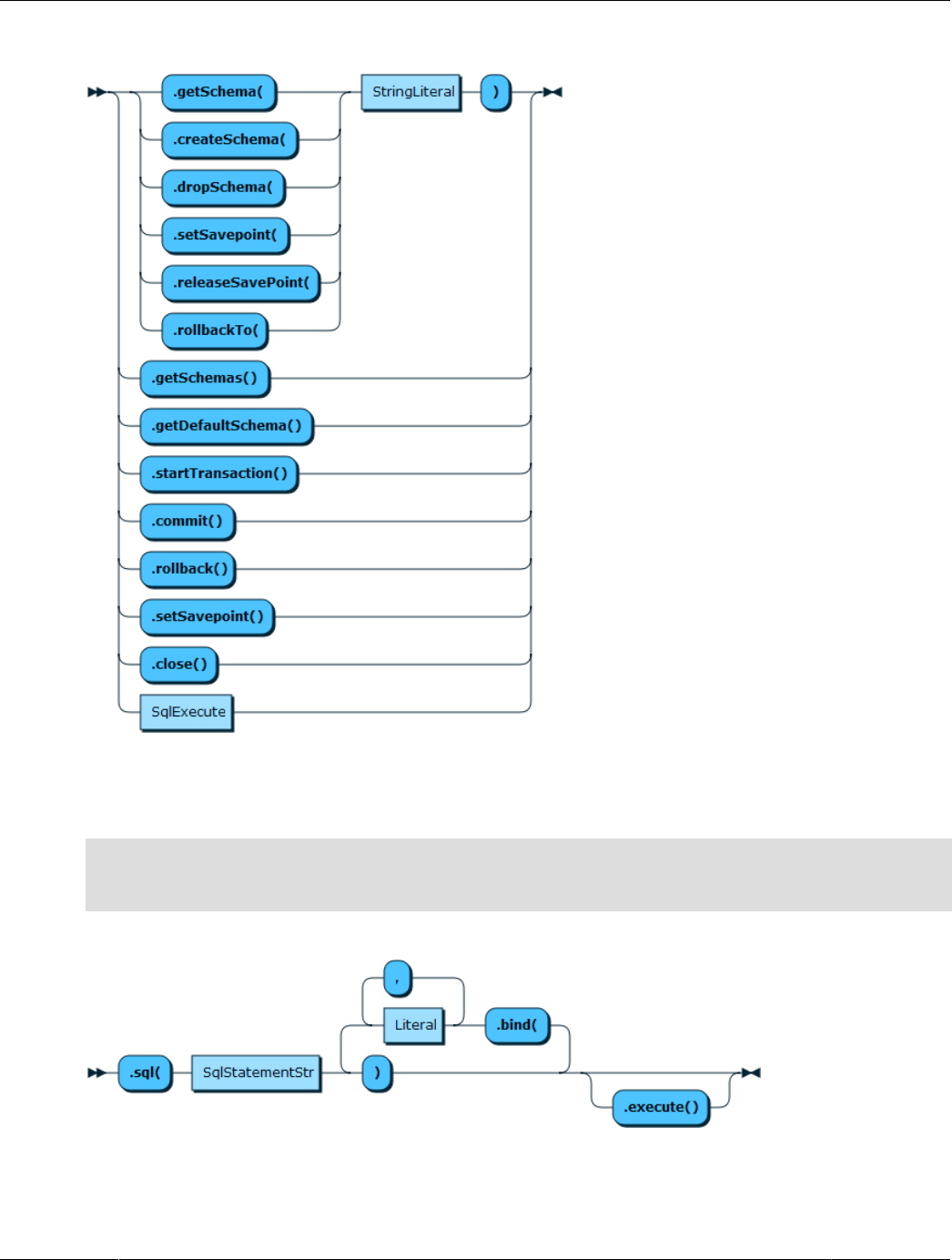
SqlExecute
Figure 11.1 Session
SqlExecute
The syntax for this function shown in EBNF is:
SqlExecute
::= '.sql(' SqlStatementStr ')'
( '.bind(' Literal (',' Literal)* ')')*
( '.execute()' )?
Figure 11.2 SqlExecute
SQLPlaceholderValues
The syntax for this function shown in EBNF is:
128
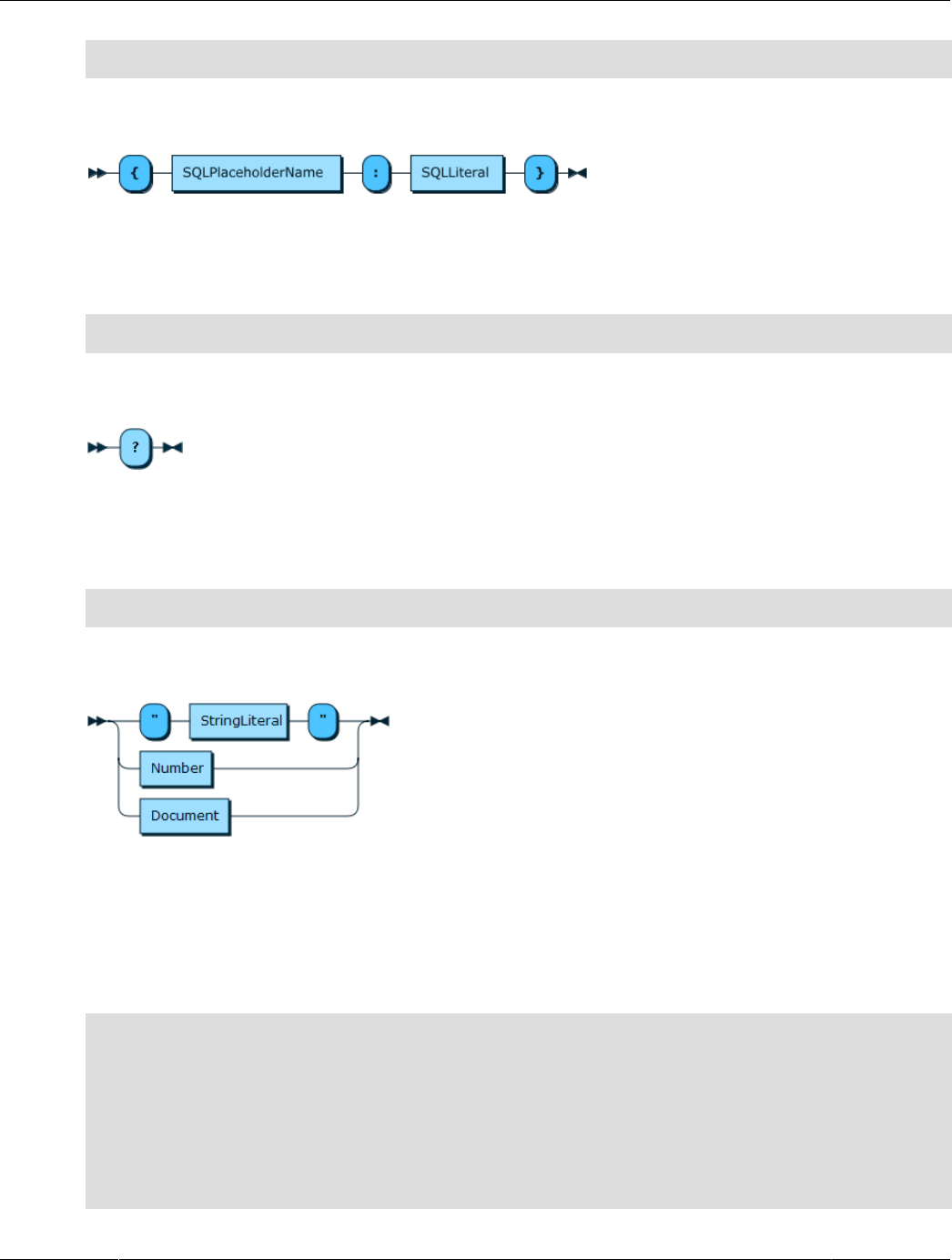
SQLPlaceholderName
SQLPlaceholderValues
::= '{' SQLPlaceholderName ':' ( SQLLiteral ) '}'
Figure 11.3 SQLPlaceholderValues
SQLPlaceholderName
The syntax for this function shown in EBNF is:
SQLPlaceholderName
::= '?'
Figure 11.4 SQLPlaceholderName
SQLLiteral
The syntax for this function shown in EBNF is:
SQLLiteral
::= '"' StringLiteral '"' | Number | Document
Figure 11.5 SQLLiteral
11.2 Schema Objects and Functions
Schema
The syntax for this function shown in EBNF is:
Schema
::= '.getName()'
| '.existsInDatabase()'
| '.getSession()'
| '.getCollection(' StringLiteral ')'
| '.getCollections()'
| '.getCollectionAsTable(' StringLiteral ')'
| '.dropCollection(' StringLiteral ')'
| '.getTable(' StringLiteral ')'
| '.getTables()'
| '.createCollection(' StringLiteral ')'
129
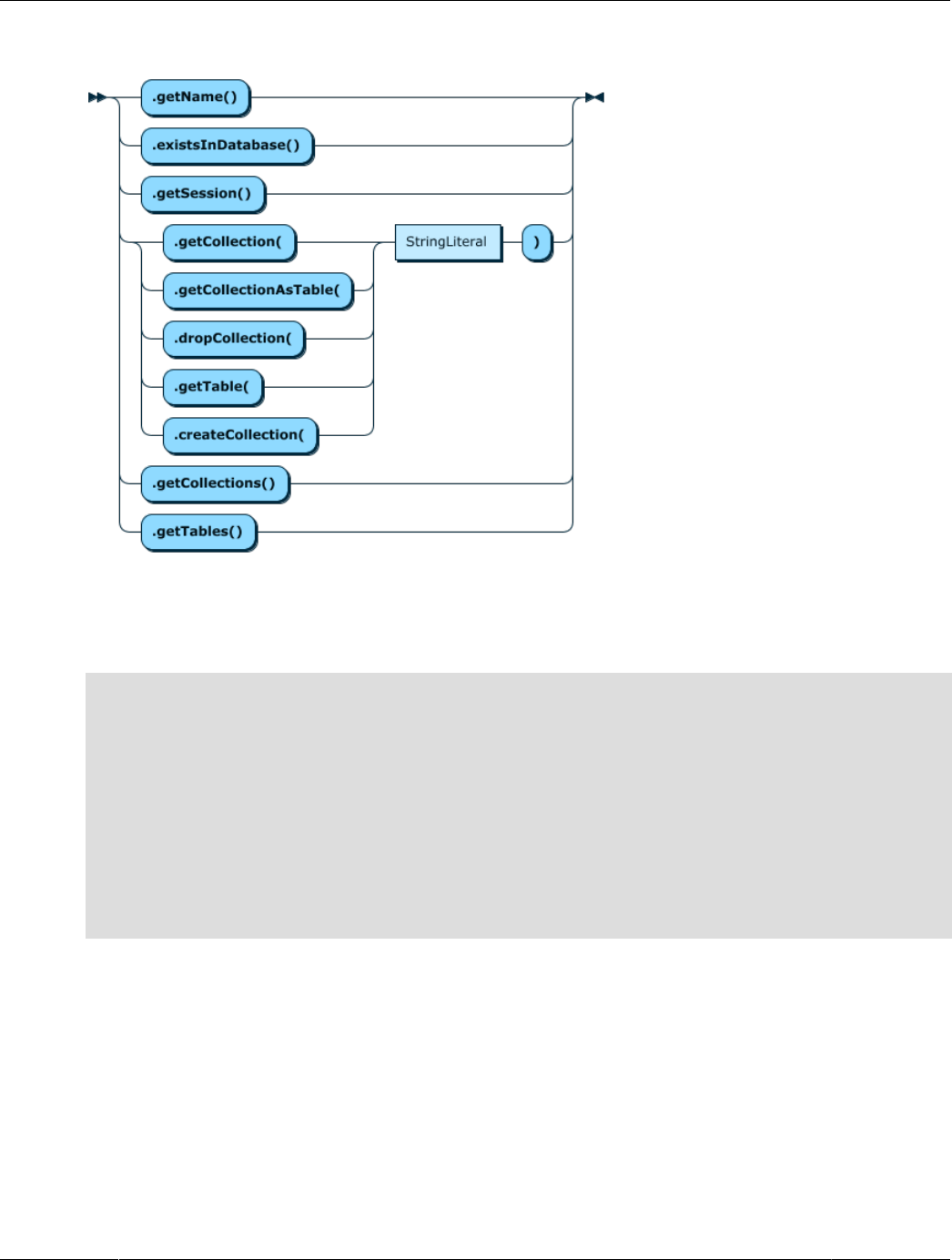
Collection
Figure 11.6 Schema
Collection
The syntax for this function shown in EBNF is:
Collection
::= '.getSchema()'
| '.getName()'
| '.getSession()'
| '.existsInDatabase()'
| '.replaceOne(' DocumentId ',' DocumentOrJSON ')'
| '.addOrReplaceOne(' DocumentId ',' DocumentOrJSON ')'
| '.getOne(' DocumentId ')'
| '.removeOne(' DocumentId ')'
| CollectionFindFunction
| CollectionModifyFunction
| CollectionAddFunction
| CollectionRemoveFunction
| CollectionCreateIndex
| CollectionDropIndex
130
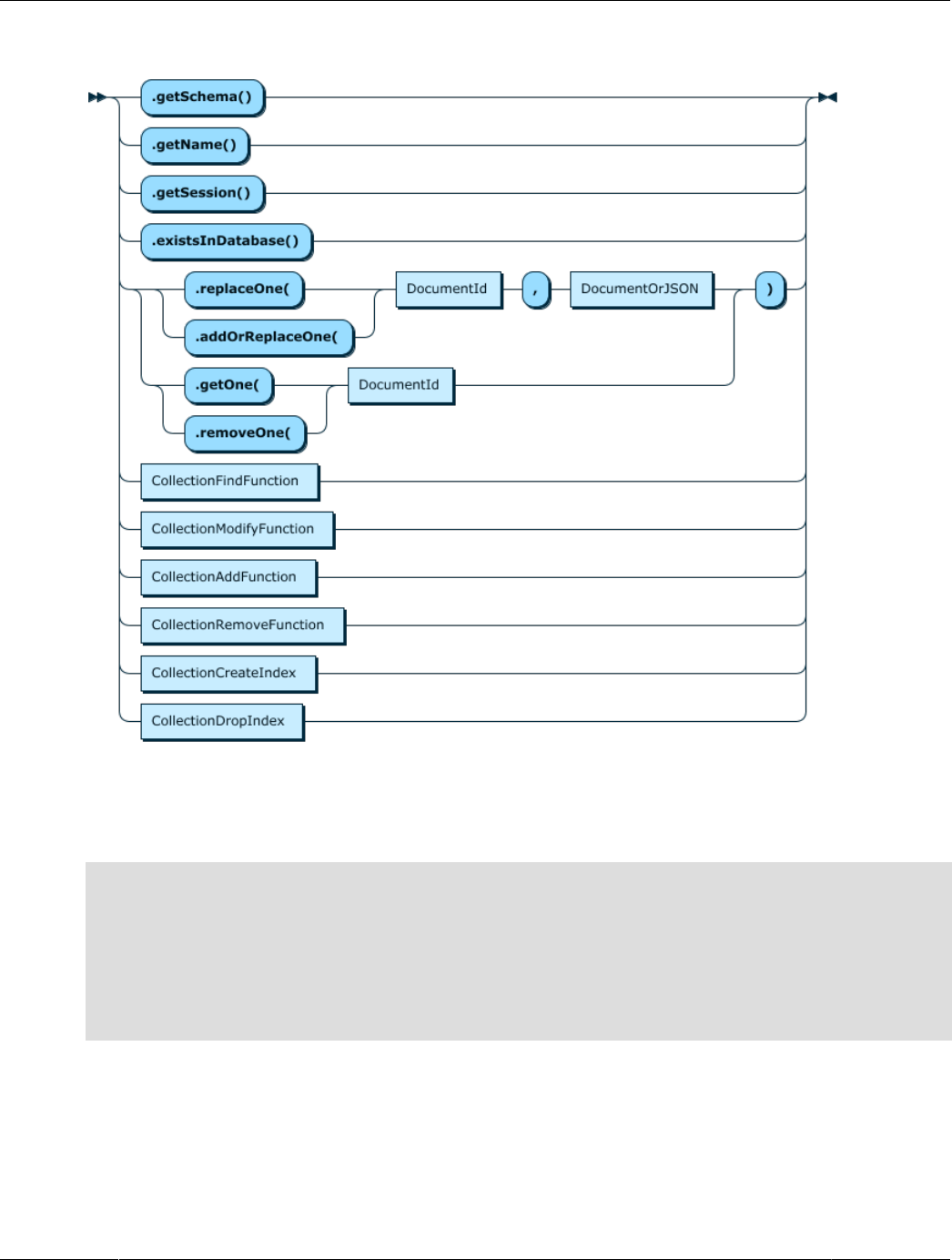
Table
Figure 11.7 Collection
Table
The syntax for this function shown in EBNF is:
Table
::= '.getSchema()'
| '.getName()'
| '.getSession()'
| '.existsInDatabase()'
| '.isView()'
| TableSelectFunction
| TableUpdateFunction
| TableInsertFunction
| TableDeleteFunction
131

Collection CRUD Functions
Figure 11.8 Table
11.3 Collection CRUD Functions
CollectionFindFunction
The syntax for this function in EBNF is:
CollectionFindFunction
::= '.find(' SearchConditionStr? ')' ( '.fields(' ProjectedDocumentExprStr ')' )?
( '.groupBy(' SearchExprStrList ')' )? ( '.having(' SearchConditionStr ')' )?
( '.sort(' SortExprStrList ')' )? ( '.limit(' NumberOfRows ')' ( '.offset(' NumberOfRows ')' )? )?
( '.lockExclusive(' LockContention ')' | '.lockShared(' LockContention ')' )?
( '.bind(' PlaceholderValues ')' )*
( '.execute()' )?
Figure 11.9 CollectionFindFunction
132
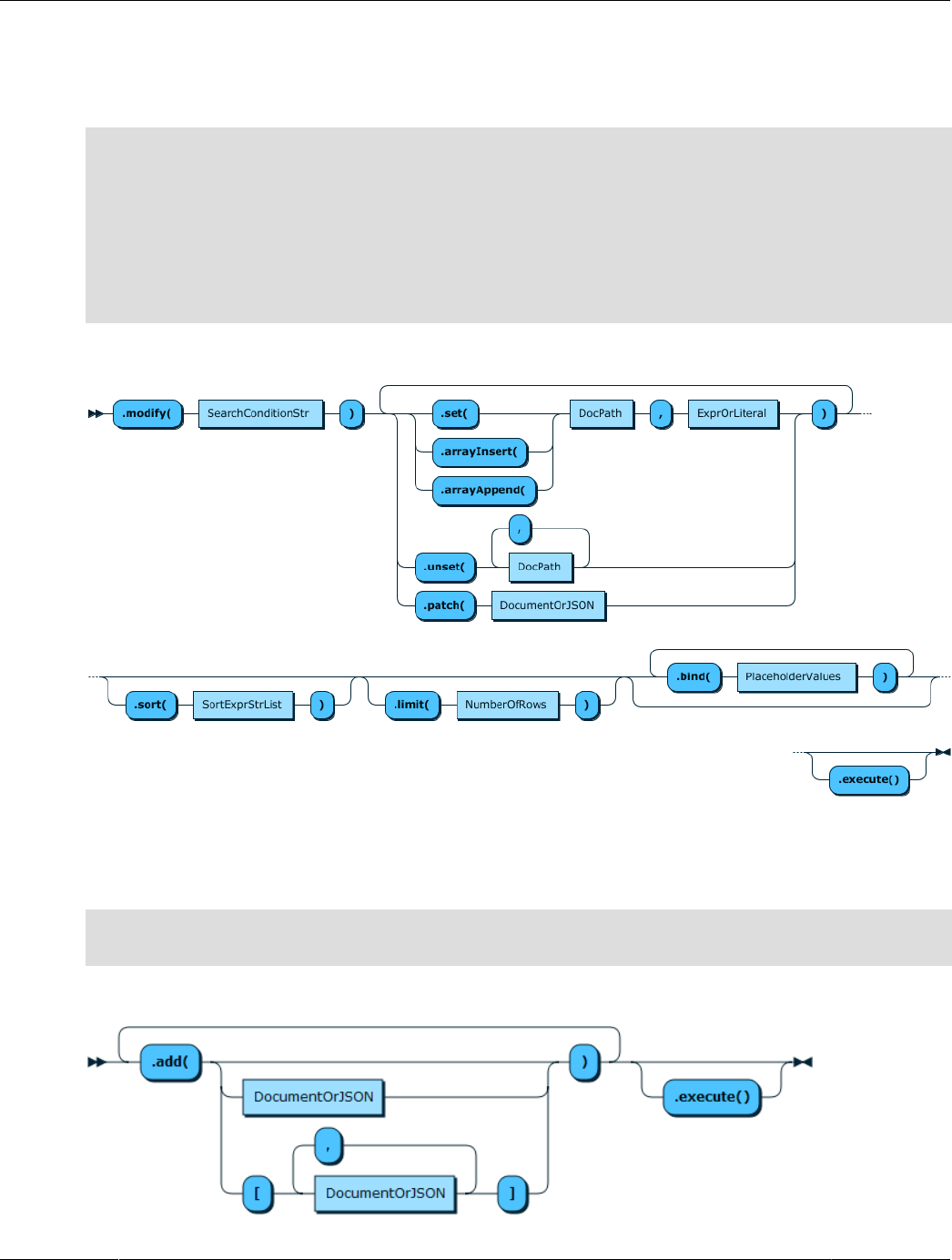
CollectionModifyFunction
CollectionModifyFunction
The syntax for this function shown in EBNF is:
CollectionModifyFunction
::= '.modify(' SearchConditionStr ')'
( '.set(' DocPath ',' ExprOrLiteral ')' |
'.unset(' DocPath ( ',' DocPath )* ')' |
'.arrayInsert(' DocPath ',' ExprOrLiteral ')' |
'.arrayAppend(' DocPath ',' ExprOrLiteral ')' |
'.patch(' DocumentOrJSON ')'
)+
( '.sort(' SortExprStrList ')' )? ( '.limit(' NumberOfRows ')' )?
( '.bind(' PlaceholderValues ')' )*
( '.execute()' )?
Figure 11.10 CollectionModifyFunction
CollectionAddFunction
The syntax for this function shown in EBNF is:
CollectionAddFunction
::= ( '.add(' ( DocumentOrJSON | '[' DocumentOrJSON ( ',' DocumentOrJSON )* ']' )? ')' )+
( '.execute()' )?
Figure 11.11 CollectionAddFunction
133
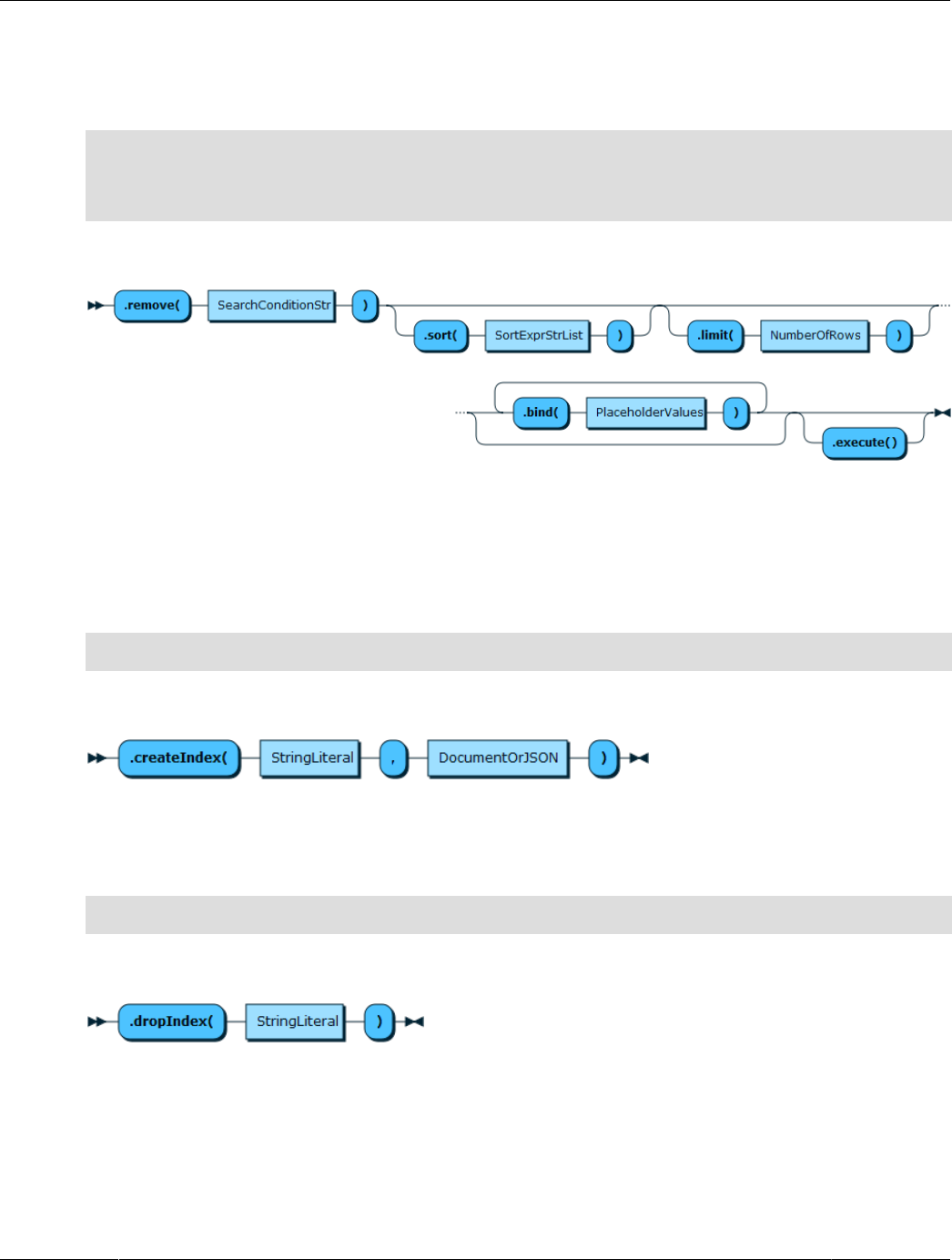
CollectionRemoveFunction
CollectionRemoveFunction
The syntax for this function shown in EBNF is:
CollectionRemoveFunction
::= '.remove(' SearchConditionStr ')'
( '.sort(' SortExprStrList ')' )? ( '.limit(' NumberOfRows ')' )?
( '.bind(' PlaceholderValues ')' )*
( '.execute()' )?
Figure 11.12 CollectionRemoveFunction
11.4 Collection Index Management Functions
Collection.createIndex() Function
The syntax for this function shown in EBNF is:
CollectionCreateIndex
::= '.createIndex(' StringLiteral ',' DocumentOrJSON ')'
Figure 11.13 CollectionCreateIndexFunction
CollectionDropIndex
The syntax for this function shown in EBNF is:
CollectionDropIndex
::= '.dropIndex(' StringLiteral ')'
Figure 11.14 CollectionDropIndex
11.5 Table CRUD Functions
TableSelectFunction
Table.select() and collection.find() use different methods for sorting results.
Table.select() follows the SQL language naming and calls the sort method orderBy().
134
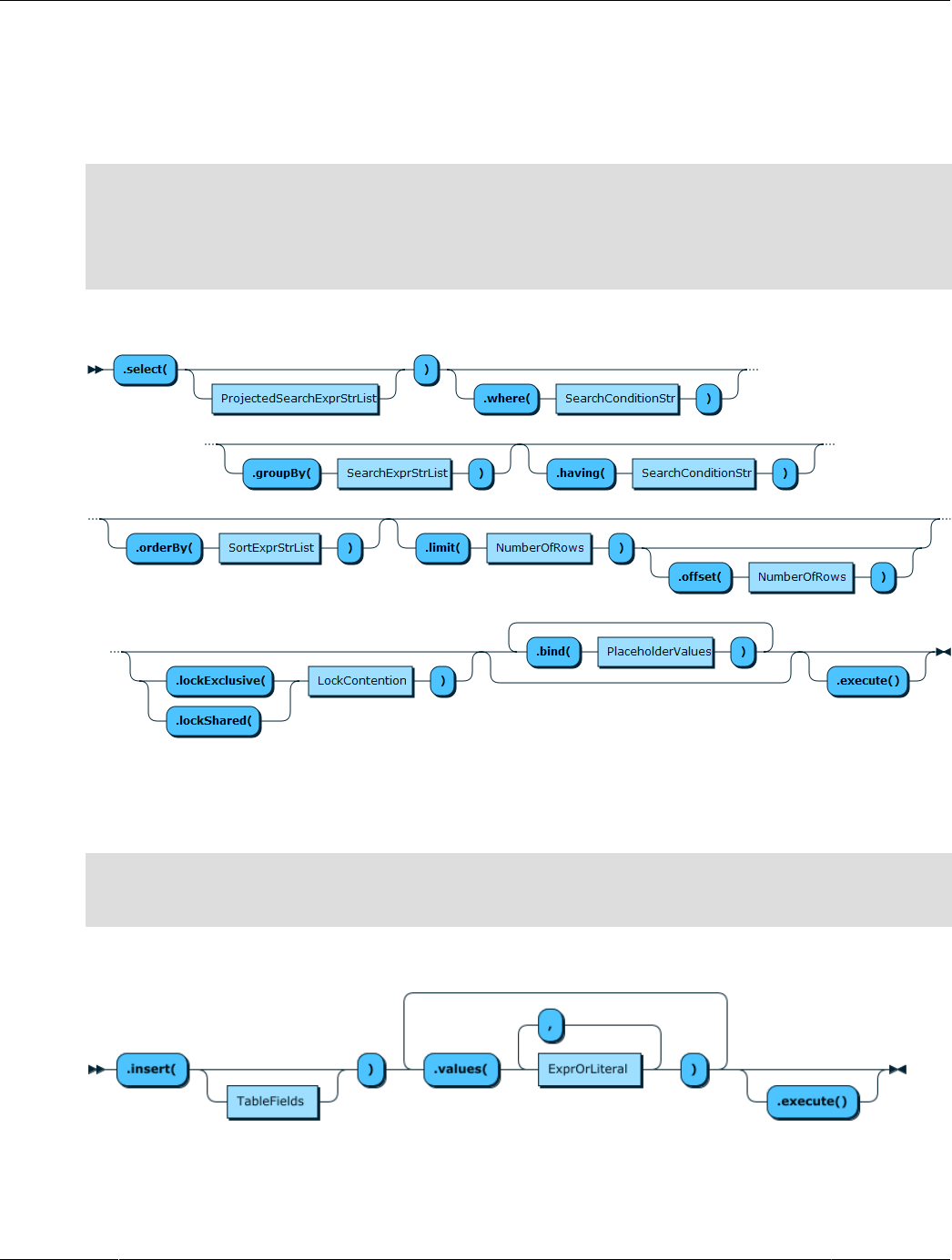
TableInsertFunction
Collection.find() does not. Use the method sort() to sort the results returned by
Collection.find(). Proximity with the SQL standard is considered more important than API uniformity
here.
The syntax for this function shown in EBNF is:
TableSelectFunction
::= '.select(' ProjectedSearchExprStrList? ')' ( '.where(' SearchConditionStr ')' )?
( '.groupBy(' SearchExprStrList ')' )? ( '.having(' SearchConditionStr ')' )?
( '.orderBy(' SortExprStrList ')' )? ( '.limit(' NumberOfRows ')' ( '.offset(' NumberOfRows ')' )? )?
( '.lockExclusive(' LockContention ')' | '.lockShared(' LockContention ')' )?
( '.bind(' ( PlaceholderValues ) ')' )*
( '.execute()' )?
Figure 11.15 TableSelectFunction
TableInsertFunction
The syntax for this function shown in EBNF is:
TableInsertFunction
::= '.insert(' ( TableFields )? ')'
( '.values(' ExprOrLiteral (',' ExprOrLiteral)* ')' )+
( '.execute()' )?
Figure 11.16 TableInsertFunction
TableUpdateFunction
The syntax for this function shown in EBNF is:
135
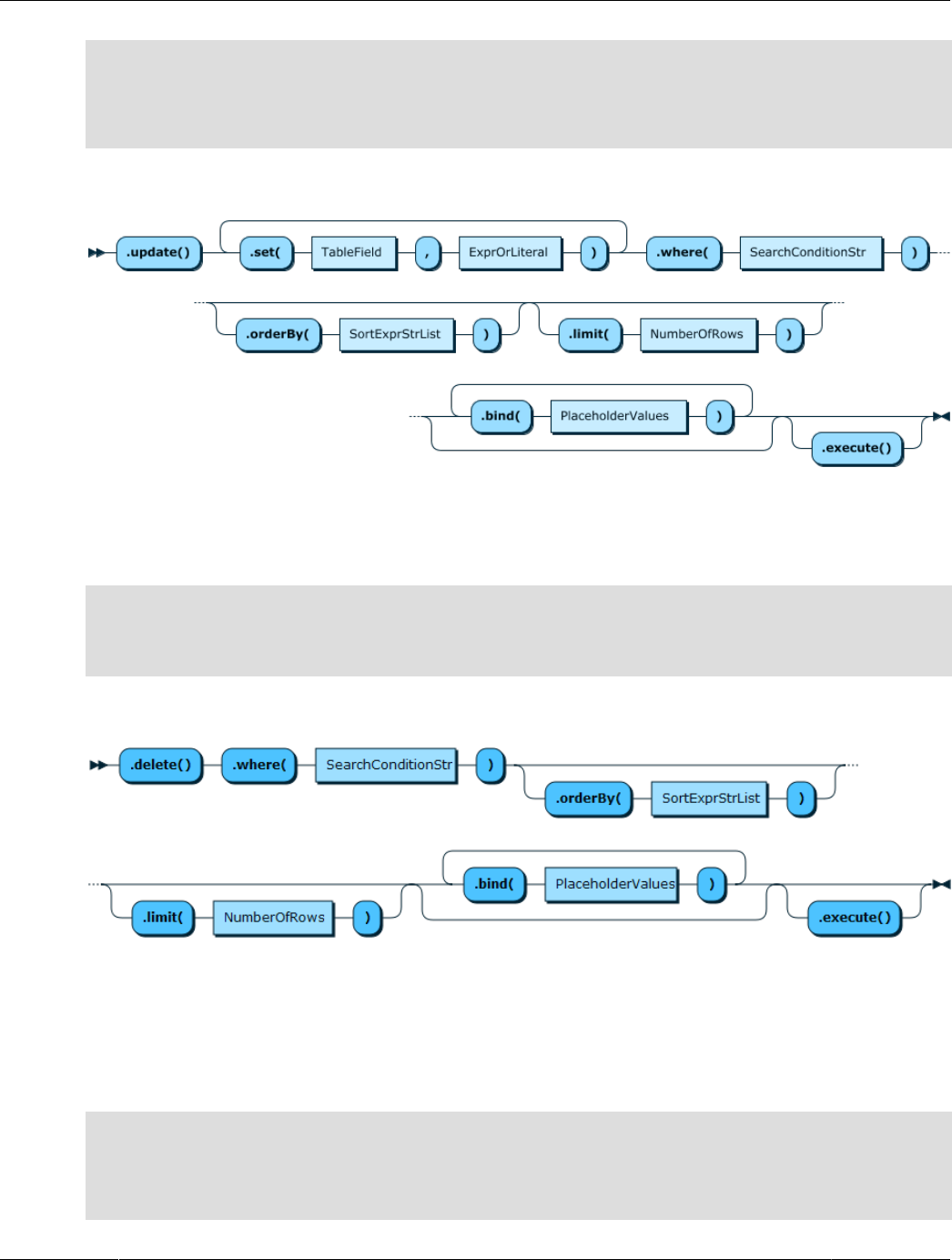
TableDeleteFunction
TableUpdateFunction
::= '.update()'
( '.set(' TableField ',' ExprOrLiteral ')' )+ '.where(' SearchConditionStr ')'
( '.orderBy(' SortExprStrList ')' )? ( '.limit(' NumberOfRows ')' )?
( '.bind(' ( PlaceholderValues ) ')' )*
( '.execute()' )?
Figure 11.17 TableUpdateFunction
TableDeleteFunction
The syntax for this function shown in EBNF is:
TableDeleteFunction
::= '.delete()' '.where(' SearchConditionStr ')'
( '.orderBy(' SortExprStrList ')' )? ( '.limit(' NumberOfRows ')' )?
( '.bind(' ( PlaceholderValues ) ')' )*
( '.execute()' )?
Figure 11.18 TableDeleteFunction
11.6 Result Functions
Result
The syntax for this function shown in EBNF is:
Result
::= '.getAffectedItemsCount()'
| '.getAutoIncrementValue()'
| '.getGeneratedIds()'
| '.getWarningsCount()'
| '.getWarnings()'
136
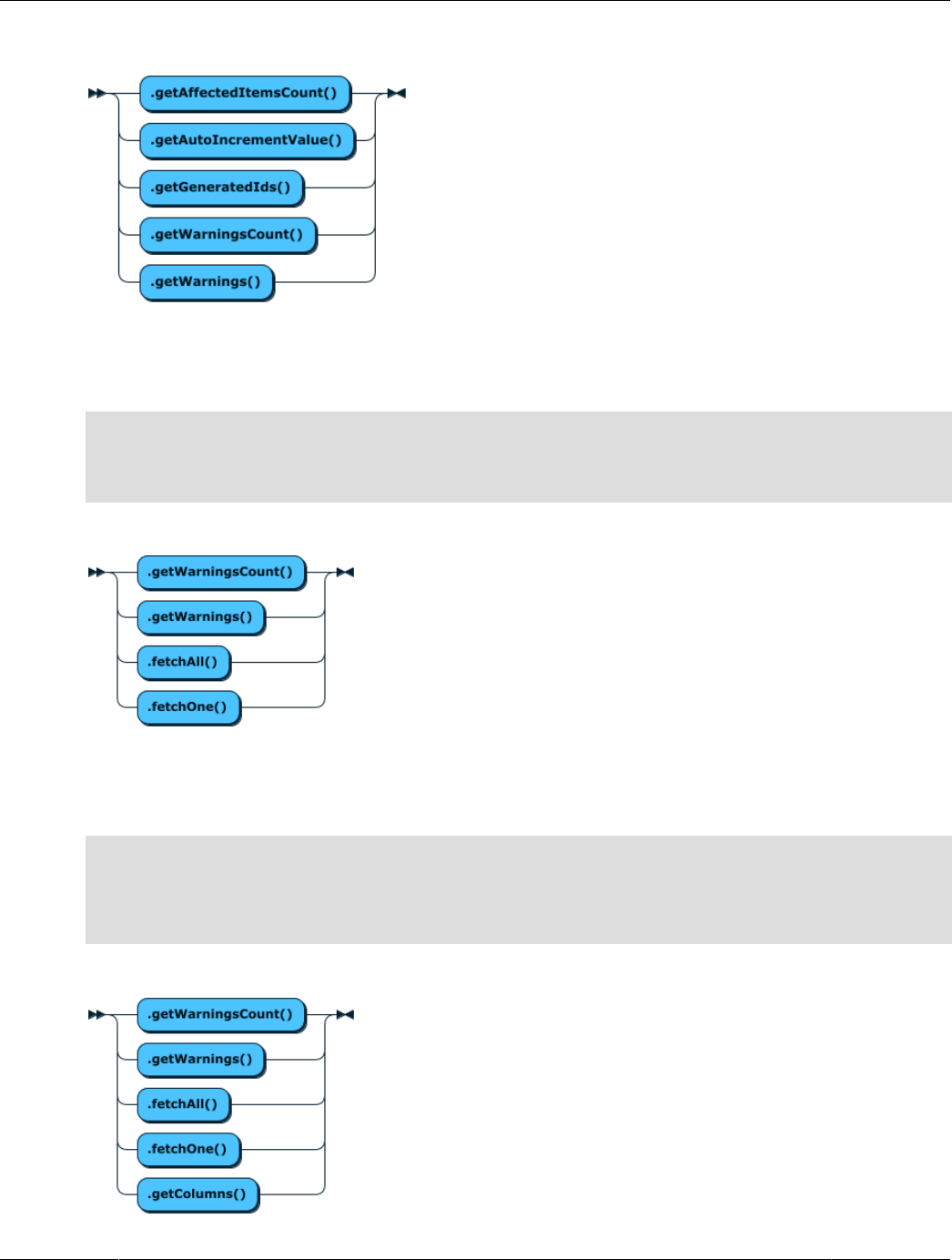
DocResult
Figure 11.19 Result
DocResult
The syntax for this function shown in EBNF is:
DocResult
::= '.getWarningsCount()'
| '.getWarnings()'
| '.fetchAll()'
| '.fetchOne()'
Figure 11.20 DocResult
RowResult
The syntax for this function shown in EBNF is:
RowResult
::= '.getWarningsCount()'
| '.getWarnings()'
| '.fetchAll()'
| '.fetchOne()'
| '.getColumns()'
Figure 11.21 RowResult
137
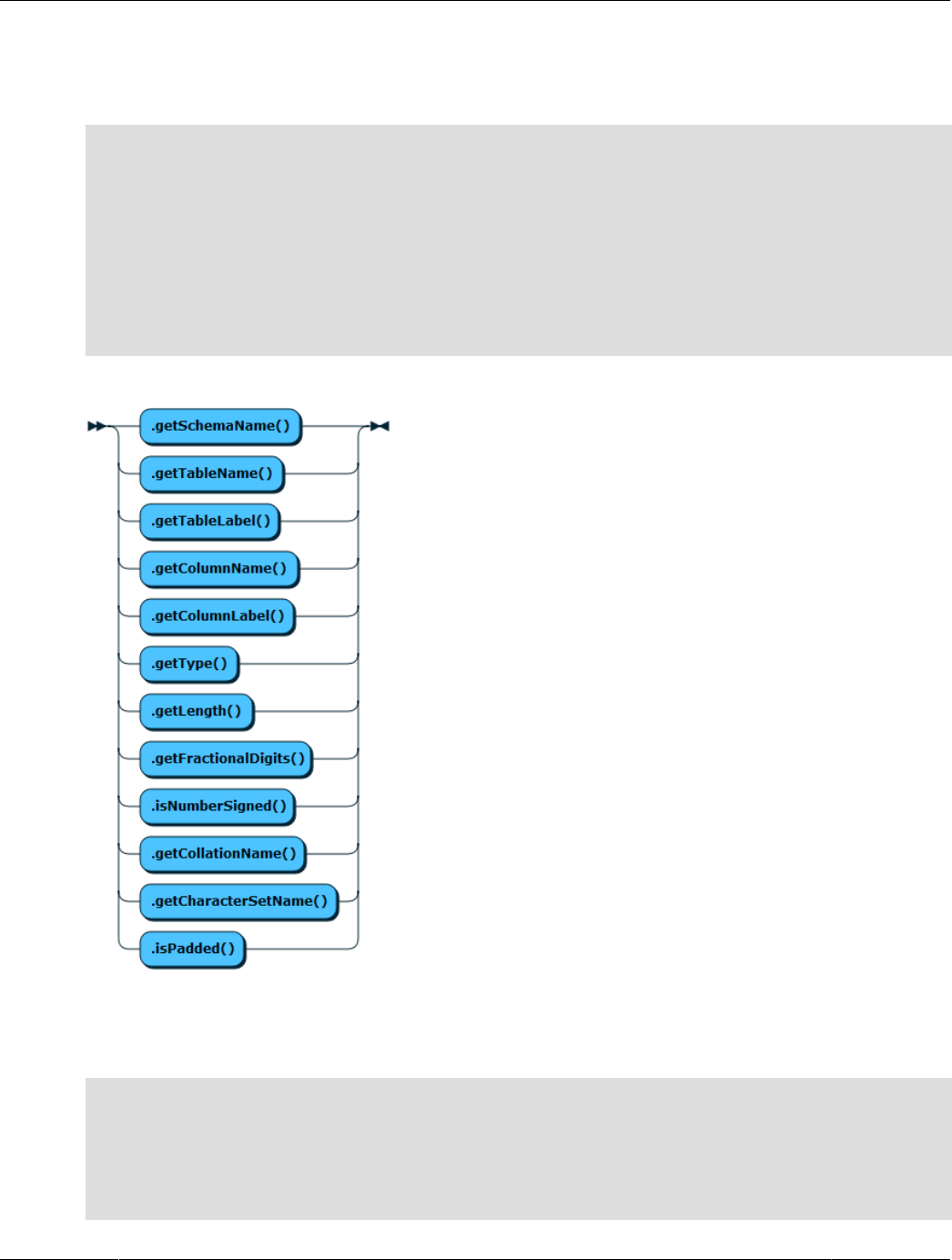
Column
Column
The syntax for this function shown in EBNF is:
Column
::= '.getSchemaName()'
| '.getTableName()'
| '.getTableLabel()'
| '.getColumnName()'
| '.getColumnLabel()'
| '.getType()'
| '.getLength()'
| '.getFractionalDigits()'
| '.isNumberSigned()'
| '.getCollationName()'
| '.getCharacterSetName()'
| '.isPadded()'
Figure 11.22 Column
SqlResult
The syntax for this function shown in EBNF is:
SqlResult
::= '.getWarningsCount()'
| '.getWarnings()'
| '.fetchAll()'
| '.fetchOne()'
| '.getColumns()'
| '.getAutoIncrementValue()'
| '.hasData()'
138
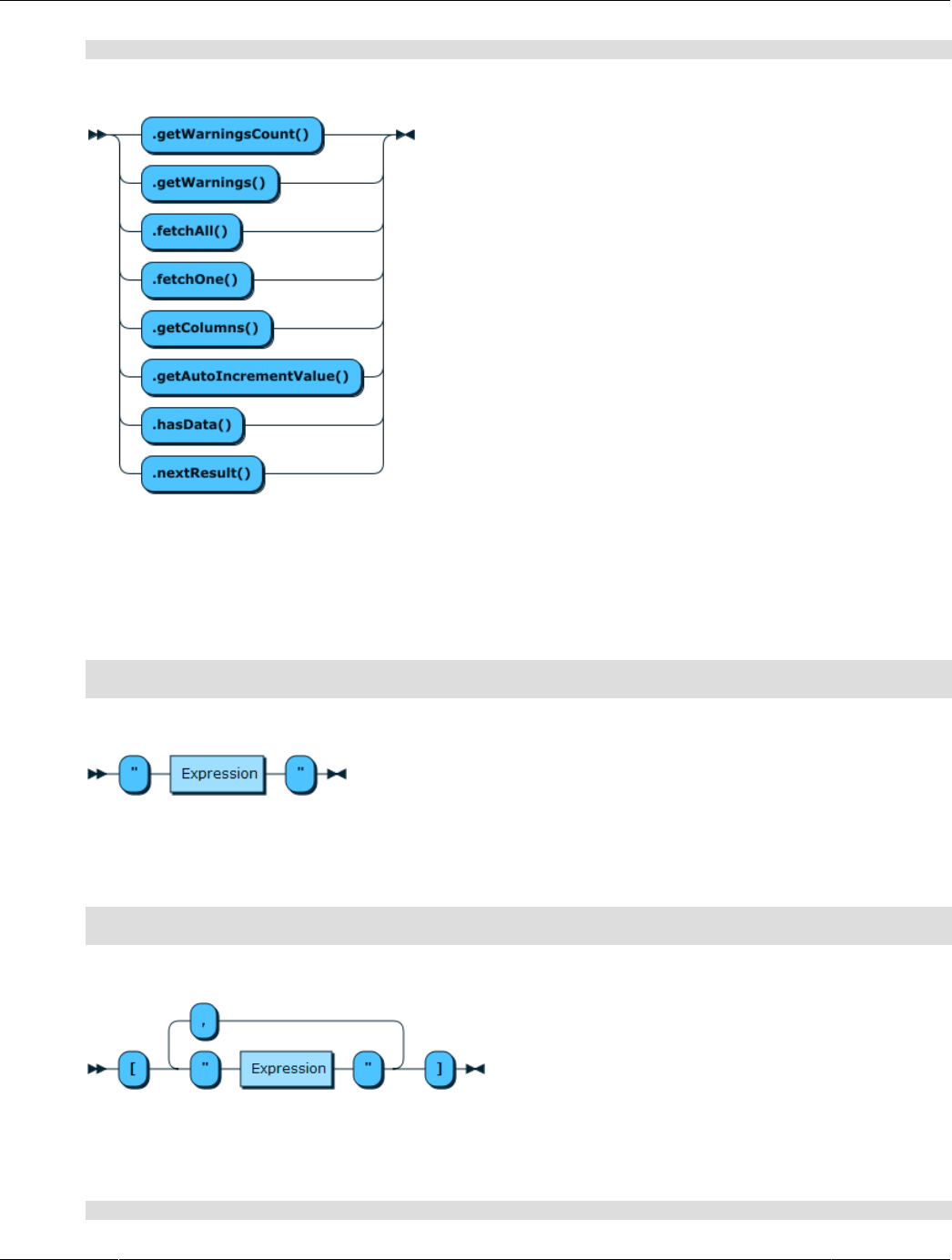
Other EBNF Definitions
| '.nextResult()'
Figure 11.23 SqlResult
11.7 Other EBNF Definitions
SearchConditionStr
The syntax for this function shown in EBNF is:
SearchConditionStr
::= '"' Expression '"'
Figure 11.24 SearchConditionStr
SearchExprStrList
The syntax for this function shown in EBNF is:
SearchExprStrList
::= '[' '"' Expression '"' ( ',' '"' Expression '"' )* ']'
Figure 11.25 SearchExprStrList
ProjectedDocumentExprStr
The syntax for this function shown in EBNF is:
ProjectedDocumentExprStr
139

ProjectedSearchExprStrList
::= ProjectedSearchExprStrList | 'expr("' JSONDocumentExpression '")'
Figure 11.26 ProjectedDocumentExprStr
ProjectedSearchExprStrList
The syntax for this function shown in EBNF is:
ProjectedSearchExprStrList
::= '[' '"' Expression ( 'AS' Alias )? '"' ( ',' '"' Expression ( 'AS' Alias )? '"' )* ']'
Figure 11.27 ProjectedSearchExprStrList
SortExprStrList
The syntax for this function shown in EBNF is:
SortExprStrList
::= '[' '"' Expression ( 'ASC' | 'DESC' )? '"' ( ',' '"' Expression ( 'ASC' | 'DESC' )? '"' )* ']'
Figure 11.28 SortExprStrList
ExprOrLiteral
The syntax for this function shown in EBNF is:
ExprOrLiteral
::= 'expr("' Expression '")' | Literal
Figure 11.29 ExprOrLiteral
140

ExprOrLiterals
ExprOrLiterals
The syntax for this function shown in EBNF is:
ExprOrLiterals
::= ExprOrLiteral ( ',' ExprOrLiteral )*
Figure 11.30 ExprOrLiterals
ExprOrLiteralOrOperand
The syntax for this function shown in EBNF is:
ExprOrLiteralOrOperand
::= ExprOrLiteral
Figure 11.31 ExprOrLiteralOrOperand
PlaceholderValues
The syntax for this function shown in EBNF is:
PlaceholderValues
::= '{' PlaceholderName ':' ( ExprOrLiteral ) '}'
Figure 11.32 PlaceholderValues
PlaceholderName
The syntax for this function shown in EBNF is:
PlaceholderName
::= NamedPlaceholderNotQuestionmarkNotNumbered
Figure 11.33 PlaceholderName
DocPath
The syntax for this function shown in EBNF is:
DocPath
::= ( '[*]' | ( '[' Index ']' ) | '.*' | ( '.' StringLiteral ) | '**' )+
141
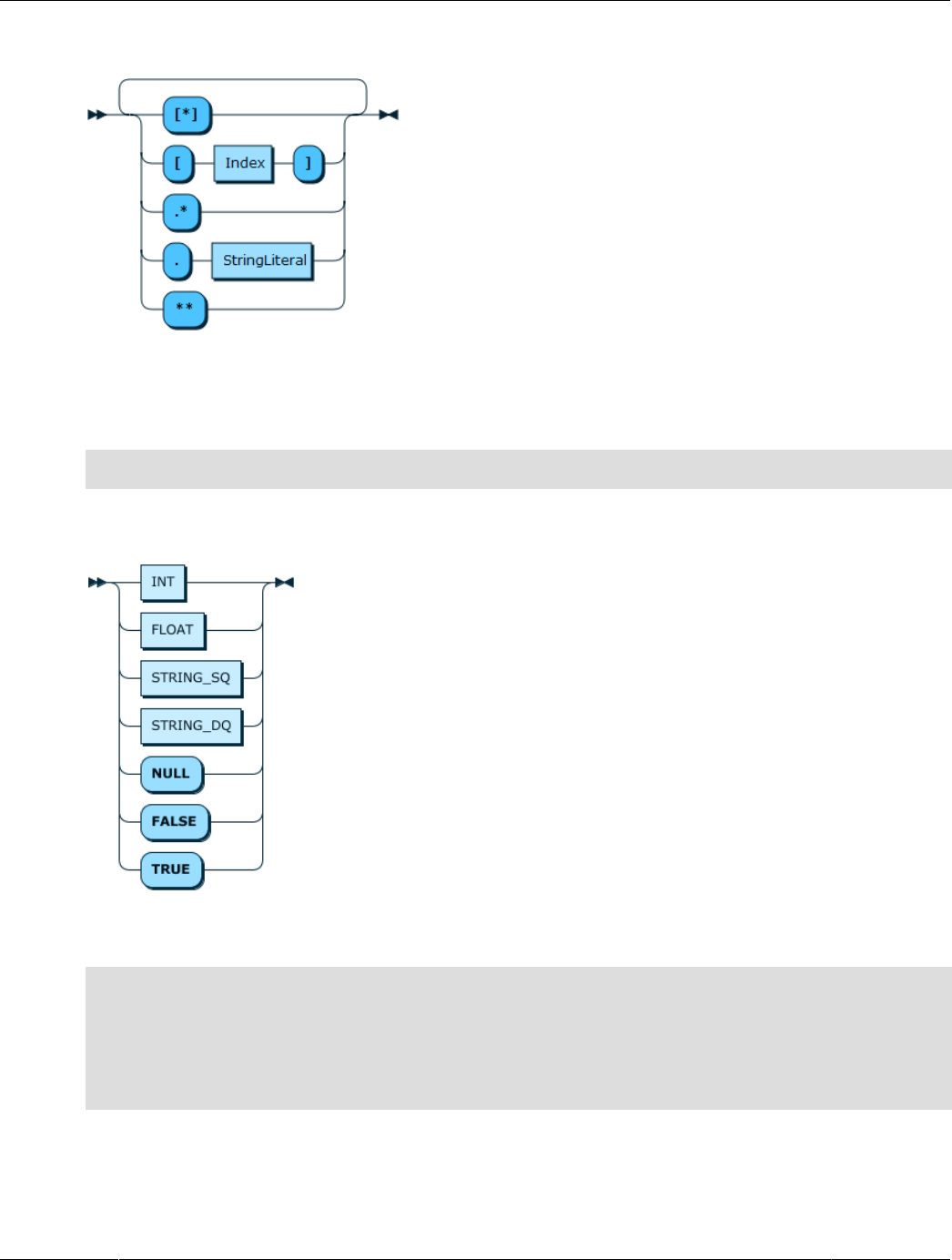
Literal
Figure 11.34 DocPath
Literal
The syntax for this function shown in EBNF is:
Literal
::= '"' StringLiteral '"' | Number | true | false | Document
Figure 11.35 Literal
Expression
Expression
::= Literal
| DocPath
| TableField
| FunctionName '(' Expression ( ',' Expression )* ')'
| ':' PlaceholderName
| Expression Operator Expression
| JSONExpression
142
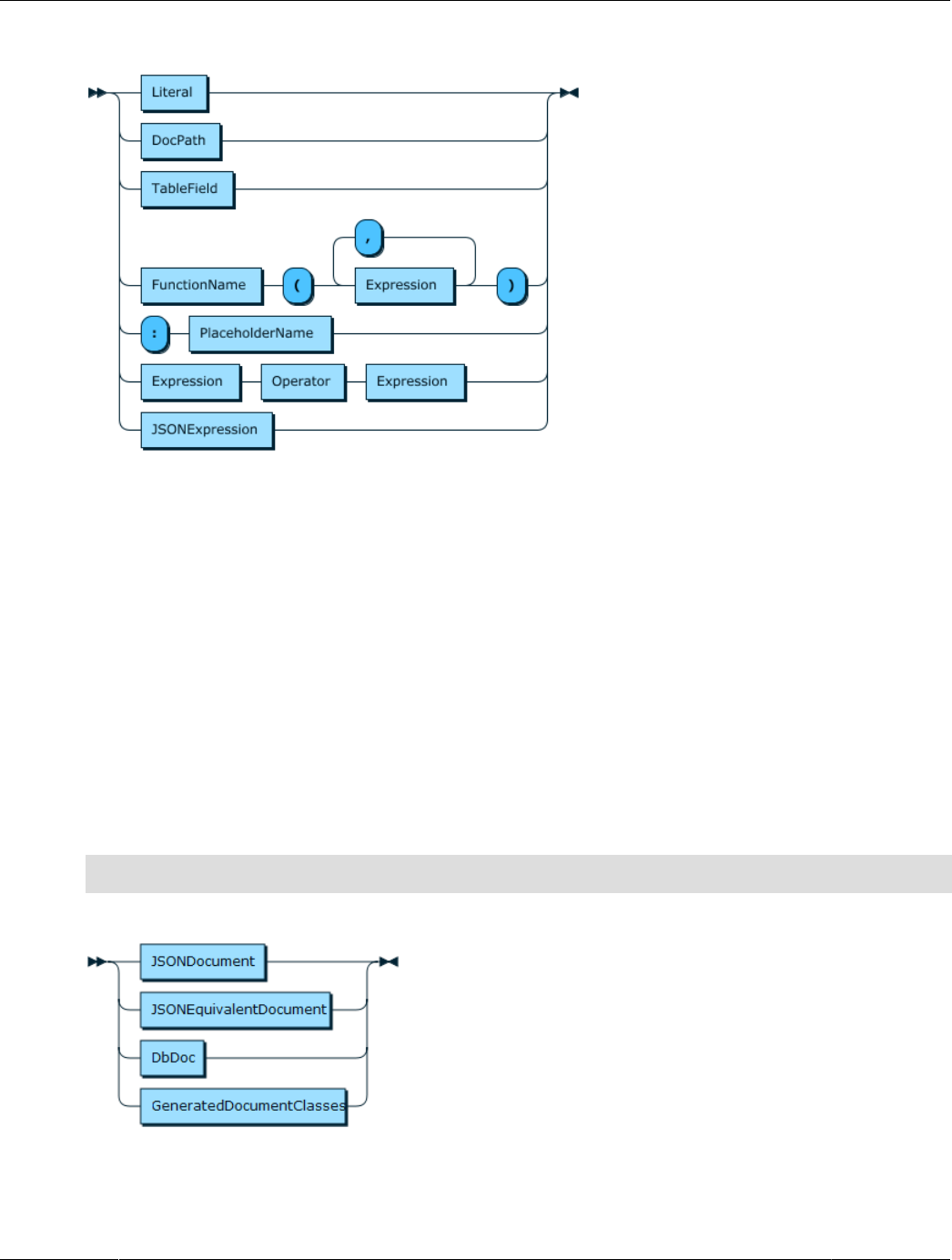
Document
Figure 11.36 Expression
Document
An API call expecting a JSON document allows the use of many data types to describe the document.
Depending on the X DevAPI implementation and language any of the following data types can be used:
• String
• Native JSON
• JSON equivalent syntax
• DbDoc
• Generated Doc Classes
All implementations of X DevAPI allow expressing a document by the special DbDoc type and as a string.
The syntax for this function shown in EBNF is:
Document
::= JSONDocument | JSONEquivalentDocument | DbDoc | GeneratedDocumentClasses
Figure 11.37 Document
JSONExpression
The syntax for this function shown in EBNF is:
143
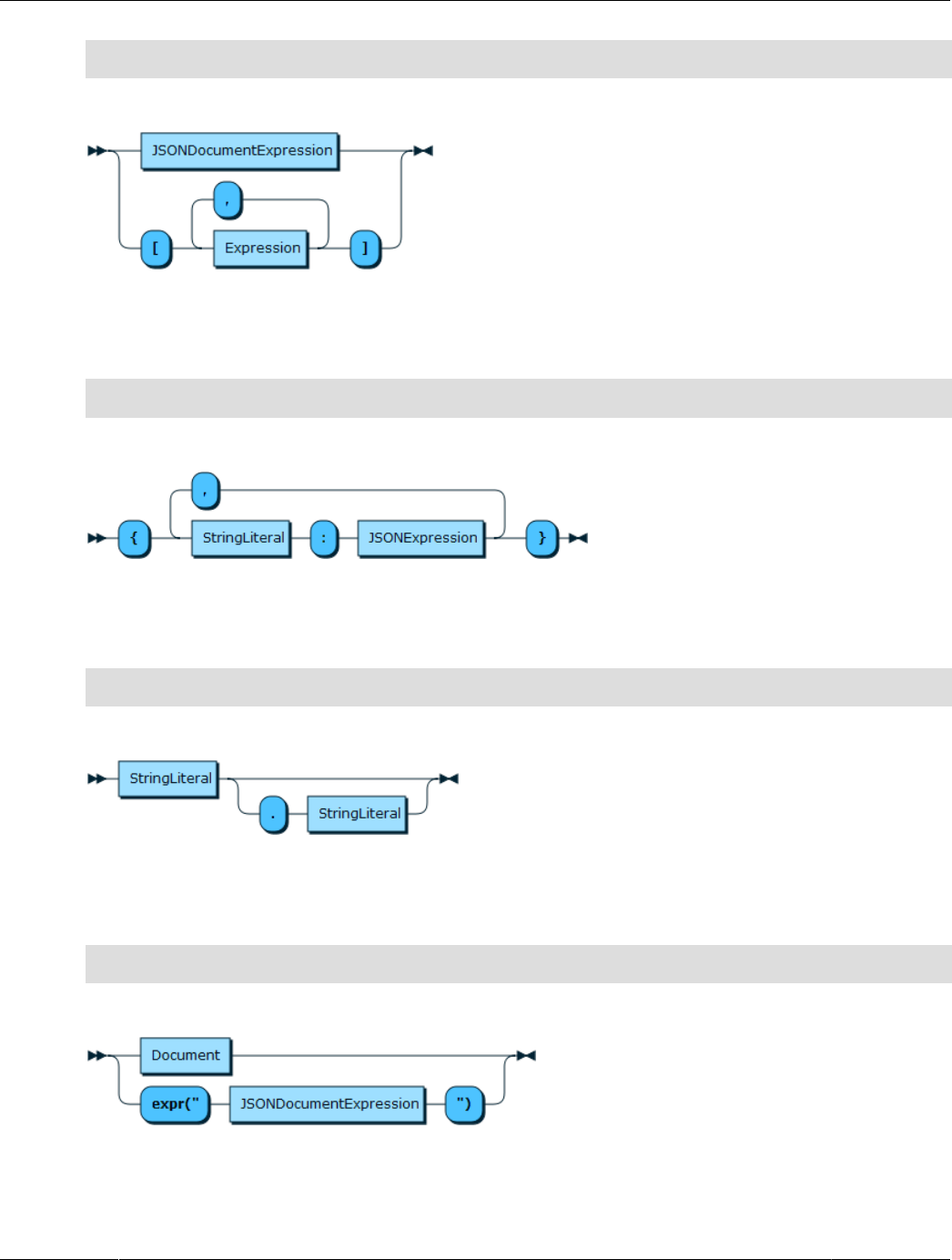
JSONDocumentExpression
JSONExpression
::= JSONDocumentExpression | '[' Expression ( ',' Expression )* ']'
Figure 11.38 JSONExpression
JSONDocumentExpression
The syntax for this function shown in EBNF is:
JSONDocumentExpression
::= '{' StringLiteral ':' JSONExpression (',' StringLiteral ':' JSONExpression)* '}'
Figure 11.39 JSONDocumentExpression
FunctionName
The syntax for this function shown in EBNF is:
FunctionName
::= StringLiteral | StringLiteral '.' StringLiteral
Figure 11.40 FunctionName
DocumentOrJSON
The syntax for this function shown in EBNF is:
DocumentOrJSON
::= Document | 'expr("' JSONDocumentExpression '")'
Figure 11.41 DocumentOrJSON
TableField
The syntax for this function shown in EBNF is:
144
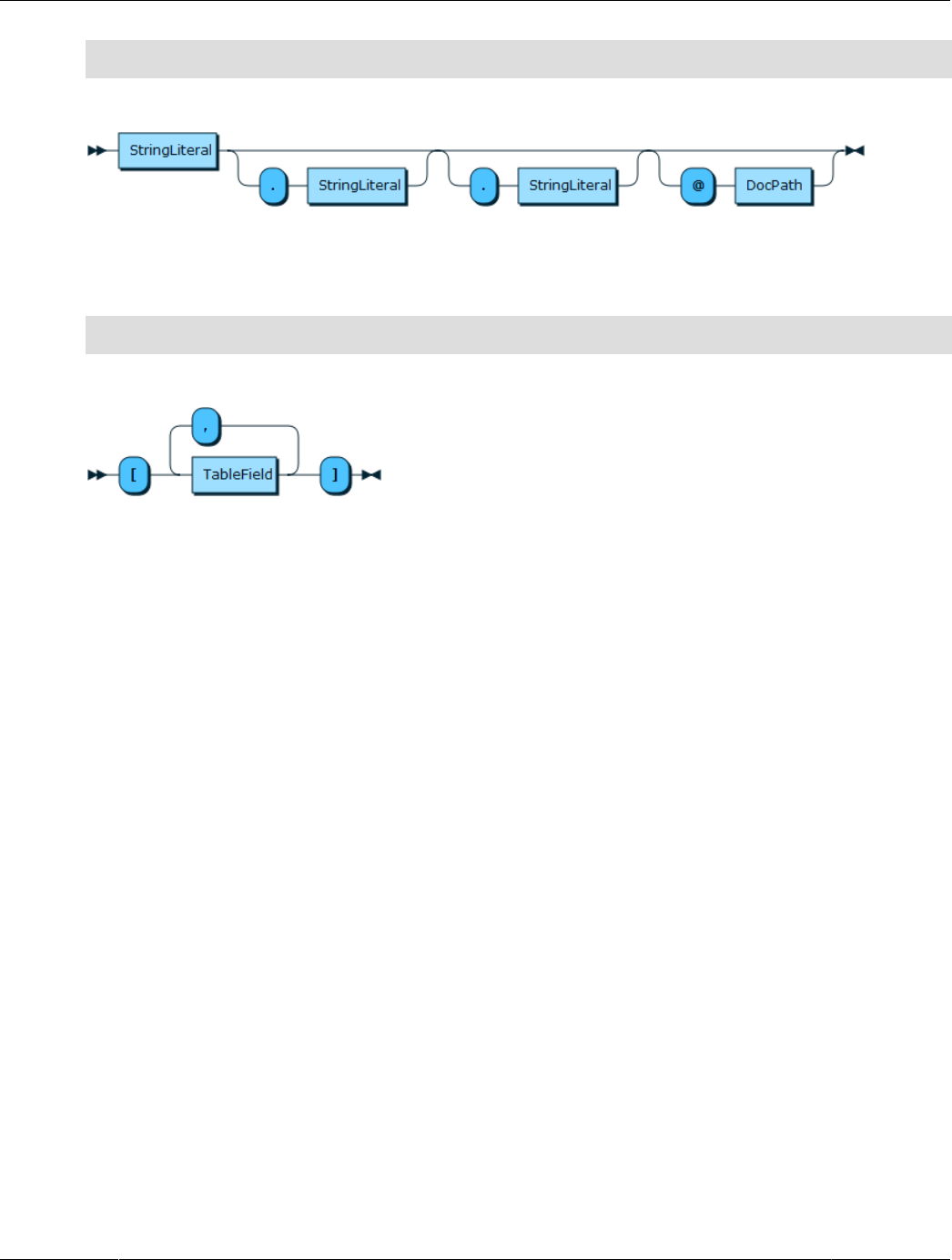
TableFields
TableField
::= ( StringLiteral '.' )? ( StringLiteral '.' )? StringLiteral ( '@' DocPath )?
Figure 11.42 TableField
TableFields
The syntax for this function shown in EBNF is:
TableFields
::= ( '[' TableField ( ',' TableField )* ']' )
Figure 11.43 TableFields
145

146
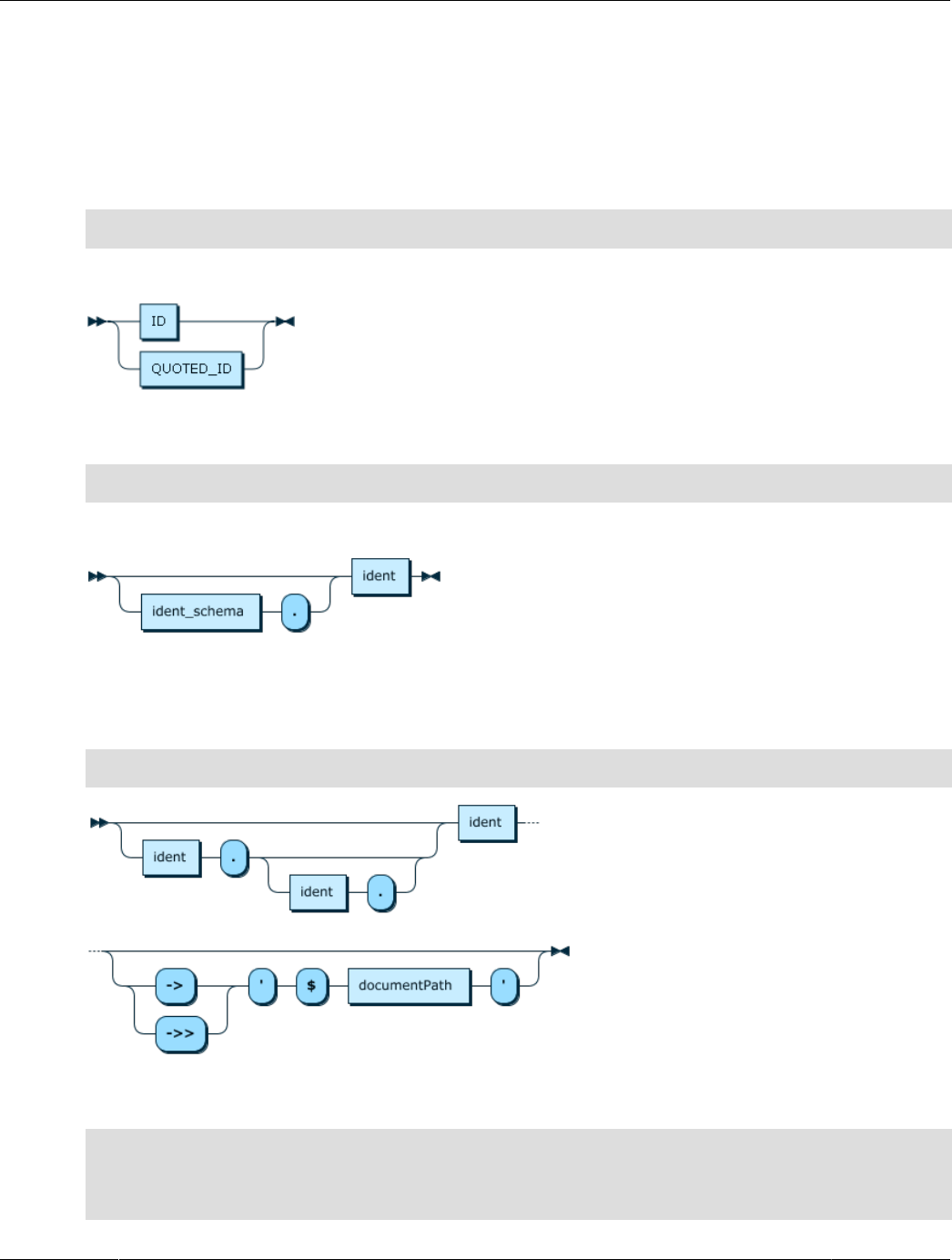
Chapter 12 Expressions EBNF Definitions
This section provides a visual reference guide to the grammar for the expression language used in X
DevAPI.
ident
ident
::= ID | QUOTED_ID
Figure 12.1 ident
schemaQualifiedIdent
schemaQualifiedIdent
::= ( ident_schema '.' )? ident
Figure 12.2 schemaQualifiedIdent
columnIdent
Figure 12.3 columnIdent
columnIdent
::= ( ident '.' ( ident '.' )? )? ident ( ( '->' | '->>' ) "'" '$' documentPath "'" )?
documentPathLastItem
documentPathLastItem
::= '[*]'
| '[' INT ']'
| '.*'
| '.' documentPathMember
147
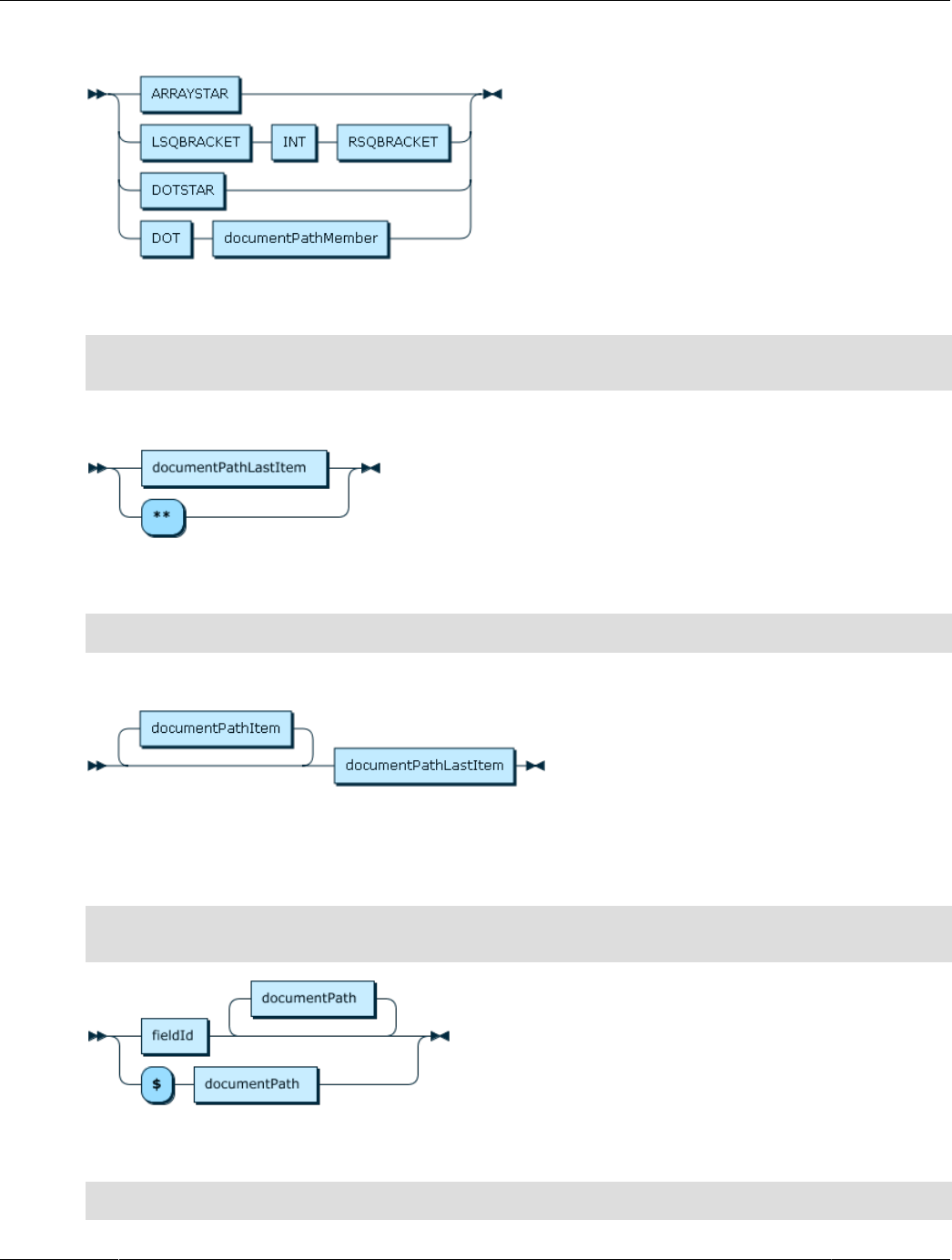
documentPathItem
Figure 12.4 documentPathLastItem
documentPathItem
documentPathItem
::= documentPathLastItem
| '**'
Figure 12.5 documentPathItem
documentPath
documentPath
::= documentPathItem* documentPathLastItem
Figure 12.6 documentPath
documentField
Figure 12.7 documentField
documentField
::= fieldId documentPath*
| '$' documentPath
argsList
argsList ::= expr ( ',' expr )*
148

lengthSpec
Figure 12.8 argsList
lengthSpec
lengthSpec ::= '(' INT ')'
Figure 12.9 lengthSpec
castType
castType ::= 'SIGNED' 'INTEGER'*
| 'UNSIGNED' 'INTEGER'*
| 'CHAR' lengthSpec*
| 'BINARY' lengthSpec*
| 'DECIMAL' ( lengthSpec | '(' INT ',' INT ')' )?
| 'TIME'
| 'DATE'
| 'DATETIME'
| 'JSON'
149
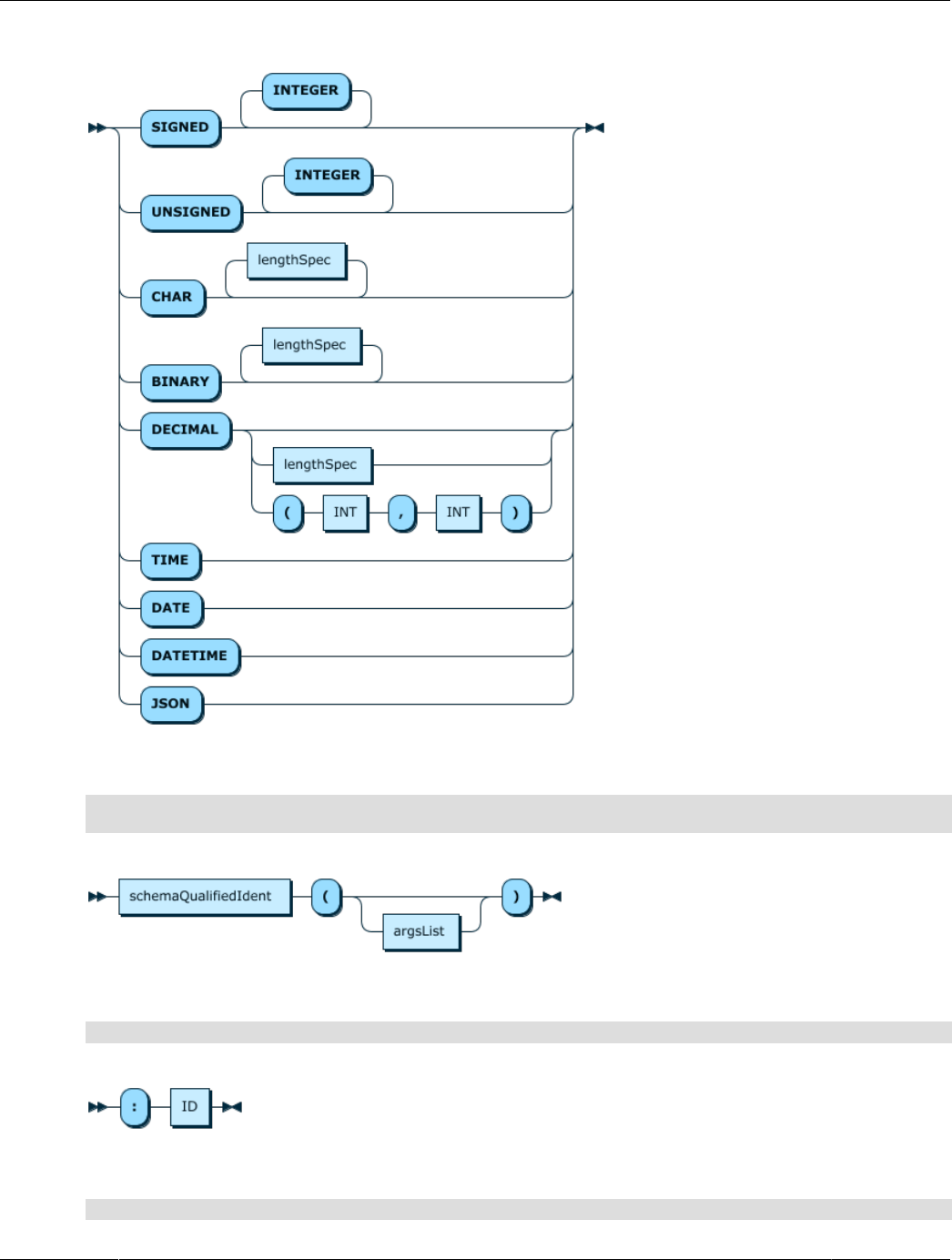
functionCall
Figure 12.10 castType
functionCall
functionCall
::= schemaQualifiedIdent '(' argsList? ')'
Figure 12.11 functionCall
placeholder
placeholder ::= ':' ID
Figure 12.12 placeholder
groupedExpr
groupedExpr ::= '(' expr ')'
150

unaryOp
Figure 12.13 groupedExpr
unaryOp
unaryOp ::= ( '!' | '~' | '+' | '-' ) atomicExpr
Figure 12.14 unaryOp
literal
literal ::= INT
| FLOAT
| STRING_SQ
| STRING_DQ
| 'NULL'
| 'FALSE'
| 'TRUE'
Figure 12.15 literal
jsonKeyValue
jsonKeyValue ::= STRING_DQ ':' expr
Figure 12.16 jsonKeyValue
151
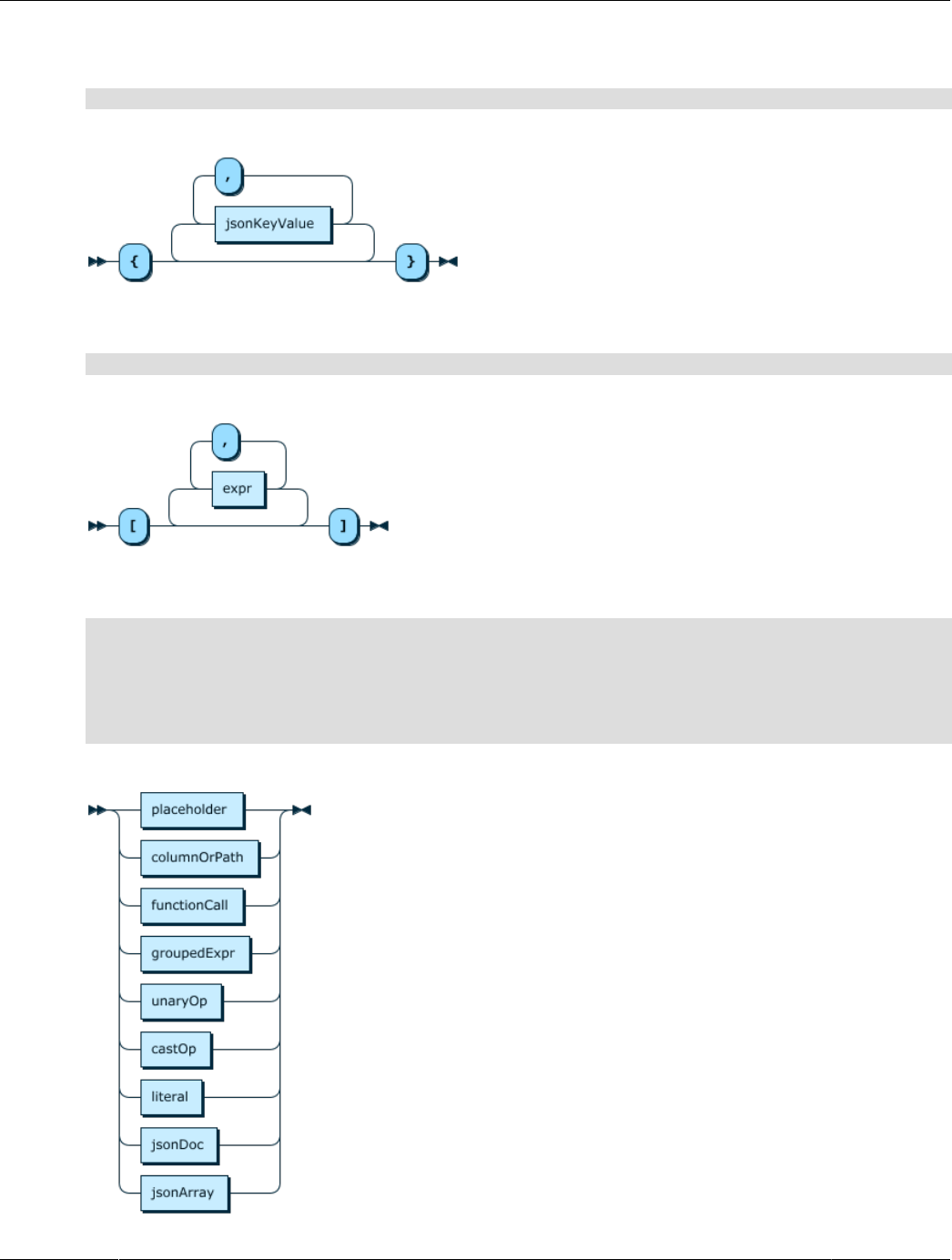
jsonDoc
jsonDoc
jsonDoc ::= '{' ( jsonKeyValue ( ',' jsonKeyValue )* )* '}'
Figure 12.17 jsonDoc
jsonarray
jsonArray ::= '[' ( expr ( ',' expr )* )* ']'
Figure 12.18 jsonarray
atomicExpr
atomicExpr
::= placeholder
| columnOrPath
| functionCall
| groupedExpr
| unaryOp
| castOp
Figure 12.19 atomicExpr
152

intervalUnit
intervalUnit
INTERVAL_UNIT
::= 'MICROSECOND'
| 'SECOND'
| 'MINUTE'
| 'HOUR'
| 'DAY'
| 'WEEK'
| 'MONTH'
| 'QUARTER'
| 'YEAR'
| 'SECOND_MICROSECOND'
| 'MINUTE_MICROSECOND'
| 'MINUTE_SECOND'
| 'HOUR_MICROSECOND'
| 'HOUR_SECOND'
| 'HOUR_MINUTE'
| 'DAY_MICROSECOND'
| 'DAY_SECOND'
| 'DAY_MINUTE'
| 'DAY_HOUR'
| 'YEAR_MONTH'
153
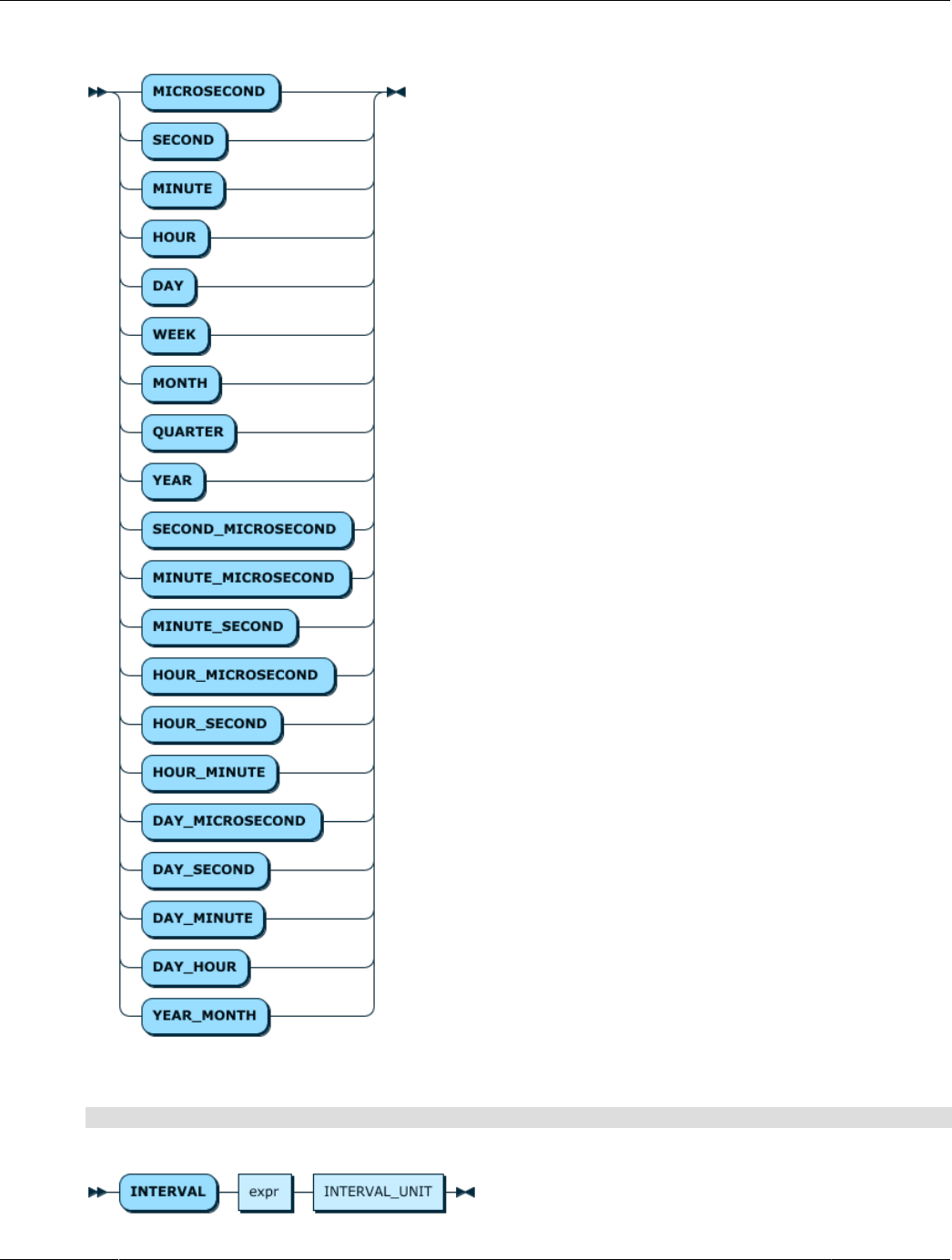
interval
Figure 12.20 INTERVAL_UNIT
interval
interval ::= 'INTERVAL' expr INTERVAL_UNIT
Figure 12.21 interval
154
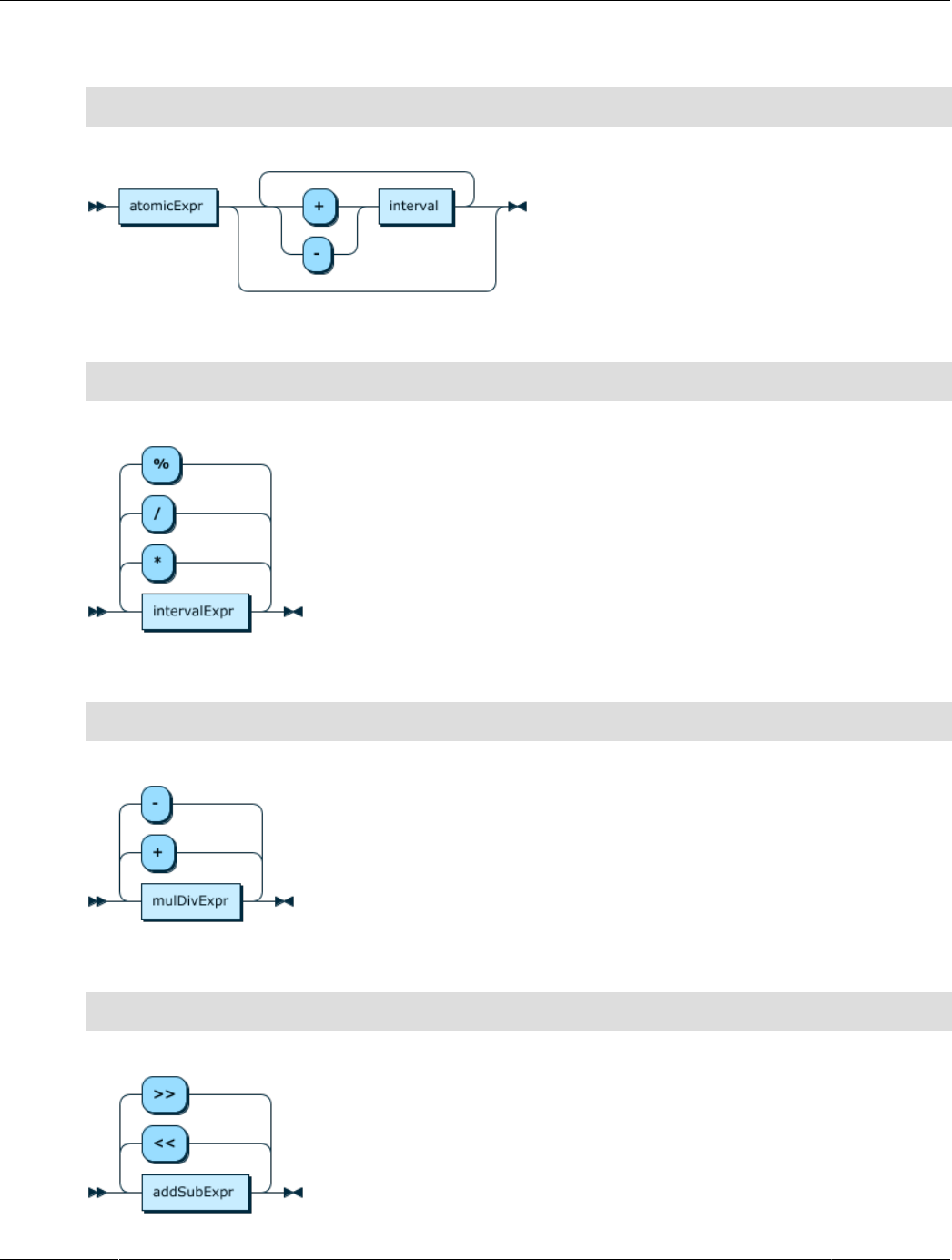
intervalExpr
intervalExpr
intervalExpr
::= atomicExpr ( ( '+' | '-' ) interval )*
Figure 12.22 intervalExpr
mulDivExpr
mulDivExpr
::= intervalExpr ( ( '*' | '/' | '%' ) intervalExpr )*
Figure 12.23 mulDivExpr
addSubExpr
addSubExpr
::= mulDivExpr ( ( '+' | '-' ) mulDivExpr )*
Figure 12.24 addSubExpr
shiftExpr
shiftExpr
::= addSubExpr ( ( '<<' | '>>' ) addSubExpr )*
Figure 12.25 shiftExpr
155

bitExpr
bitExpr
bitExpr ::= shiftExpr ( ( '&' | '|' | '^' ) shiftExpr )*
Figure 12.26 bitExpr
compExpr
compExpr ::= bitExpr ( ( '>=' | '>' | '<=' | '<' | '=' | '<>' | '!=' ) bitExpr )*
Figure 12.27 compExpr
ilriExpr
ilriExpr ::= compExpr 'IS' 'NOT'* ( 'NULL' | 'TRUE' | 'FALSE' )
| compExpr 'NOT'* 'IN' '(' argsList* ')'
| compExpr 'NOT'* 'IN' compExpr
| compExpr 'NOT'* 'LIKE' compExpr ( 'ESCAPE' compExpr )*
| compExpr 'NOT'* 'BETWEEN' compExpr 'AND' compExpr
| compExpr 'NOT'* 'REGEXP' compExpr
| compExpr
156
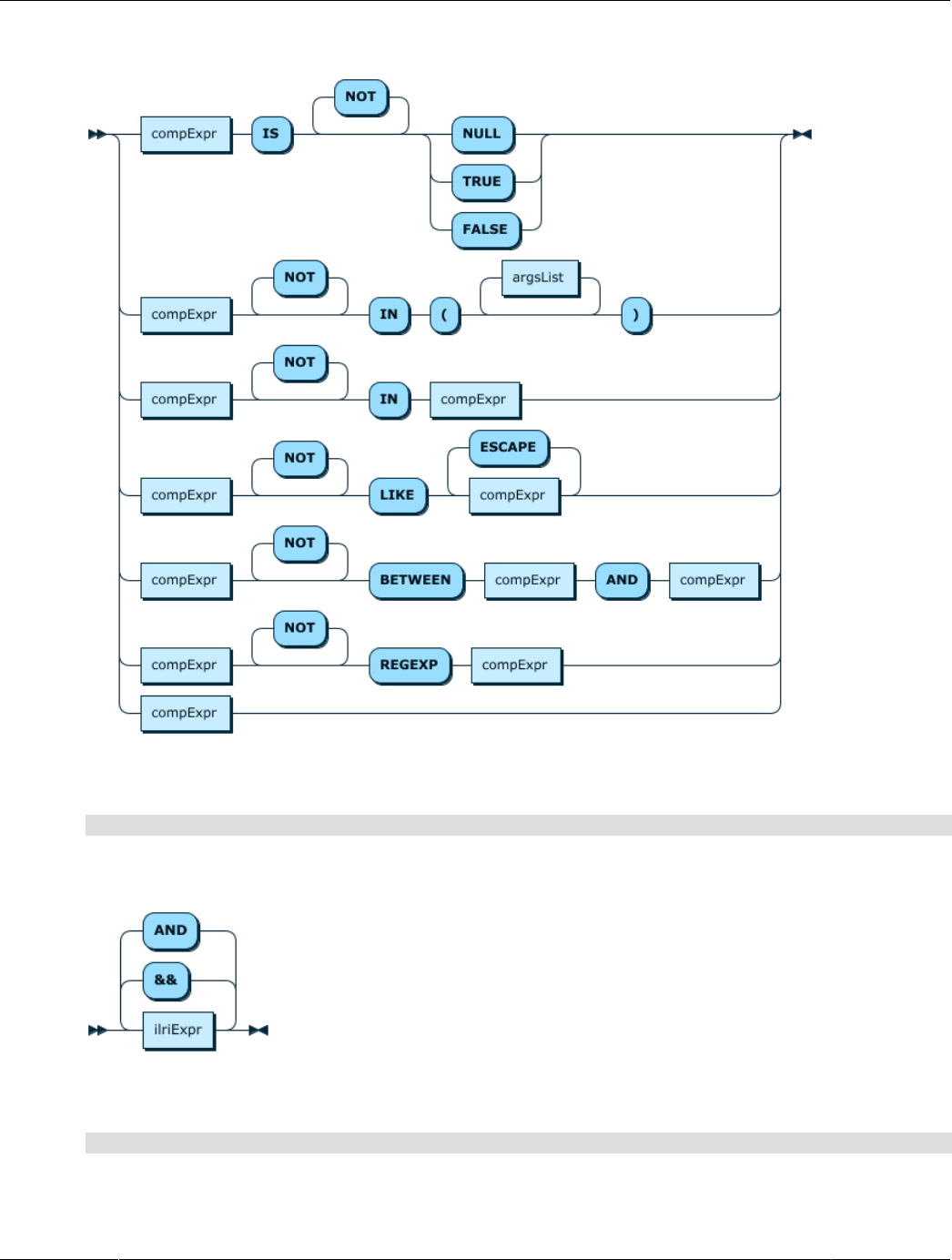
andExpr
Figure 12.28 ilriExpr
andExpr
andExpr ::= ilriExpr ( ( '&&' | 'AND' ) ilriExpr )*
Figure 12.29 andExpr
orExpr
orExpr ::= andExpr ( ( '||' | 'OR' ) andExpr )*
157

expr
Figure 12.30 orExpr
expr
expr ::= orExpr
Figure 12.31 expr
DIGIT
DIGIT ::= '0' - '9'
Figure 12.32 DIGIT
FLOAT
FLOAT ::= DIGIT* '.' DIGIT+ ( 'E' ( '+' | '-' )* DIGIT+ )*
| DIGIT+ 'E' ( '+' | '-' )* DIGIT+
Figure 12.33 FLOAT
INT
INT ::= DIGIT+
158
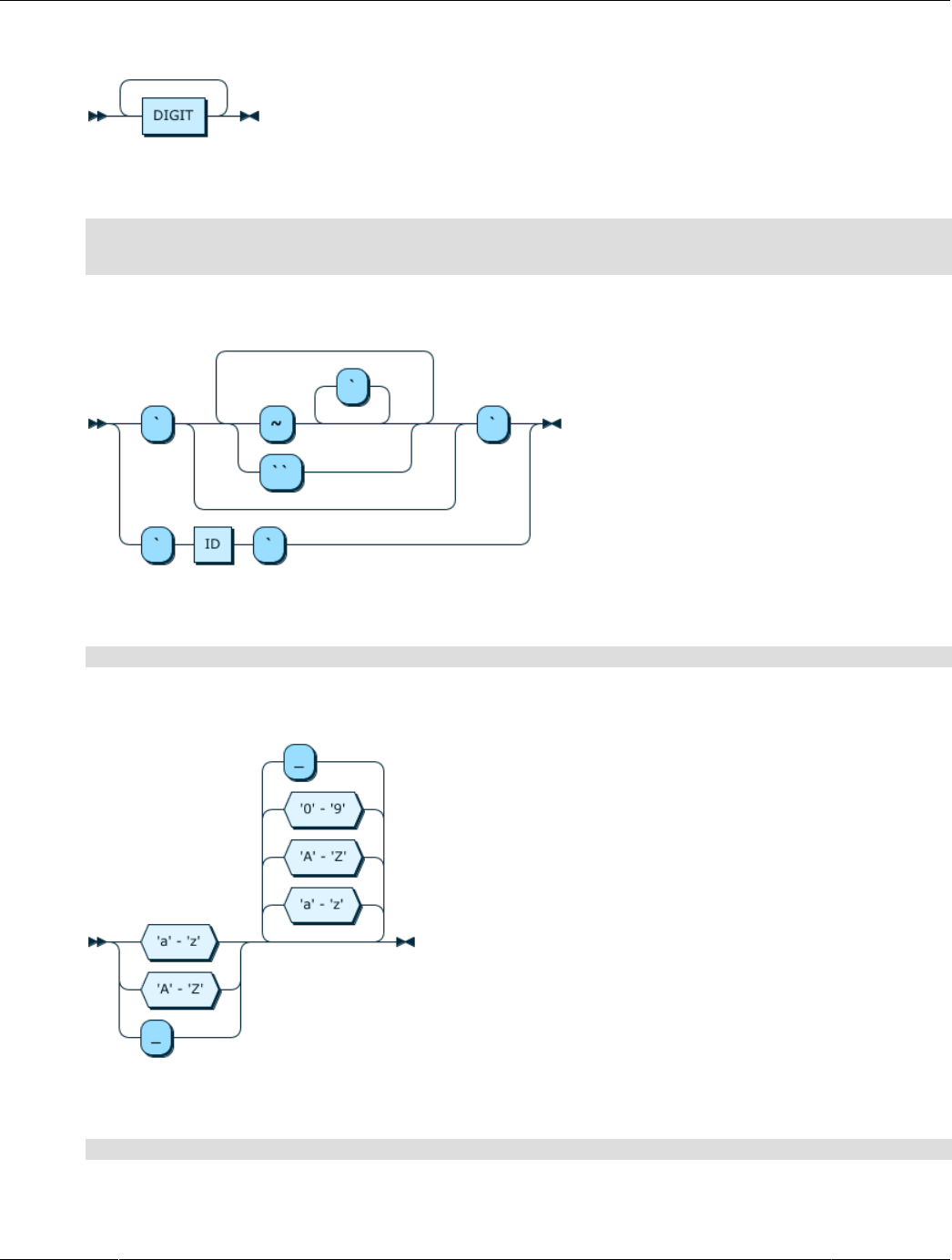
QUOTED_ID
Figure 12.34 INT
QUOTED_ID
QUOTED_ID
::= '`' ID '`'
| '`' ( '~' '`'* | '``' )* '`'
Figure 12.35 QUOTED_ID
ID
ID ::= ( 'a' - 'z' | 'A' - 'Z' | '_' ) ( 'a' - 'z' | 'A' - 'Z' | '0' - '9' | '_' )*
Figure 12.36 ID
WS
WS ::= [ \t\r\n]+
159

SCHAR
Figure 12.37 WS
SCHAR
SCHAR ::= [\u0020\u0021\u0023\u0024\u0025\u0026\u0028-\u005B\u005D-\u007E]
160

SCHAR
Figure 12.38 SCHAR
161
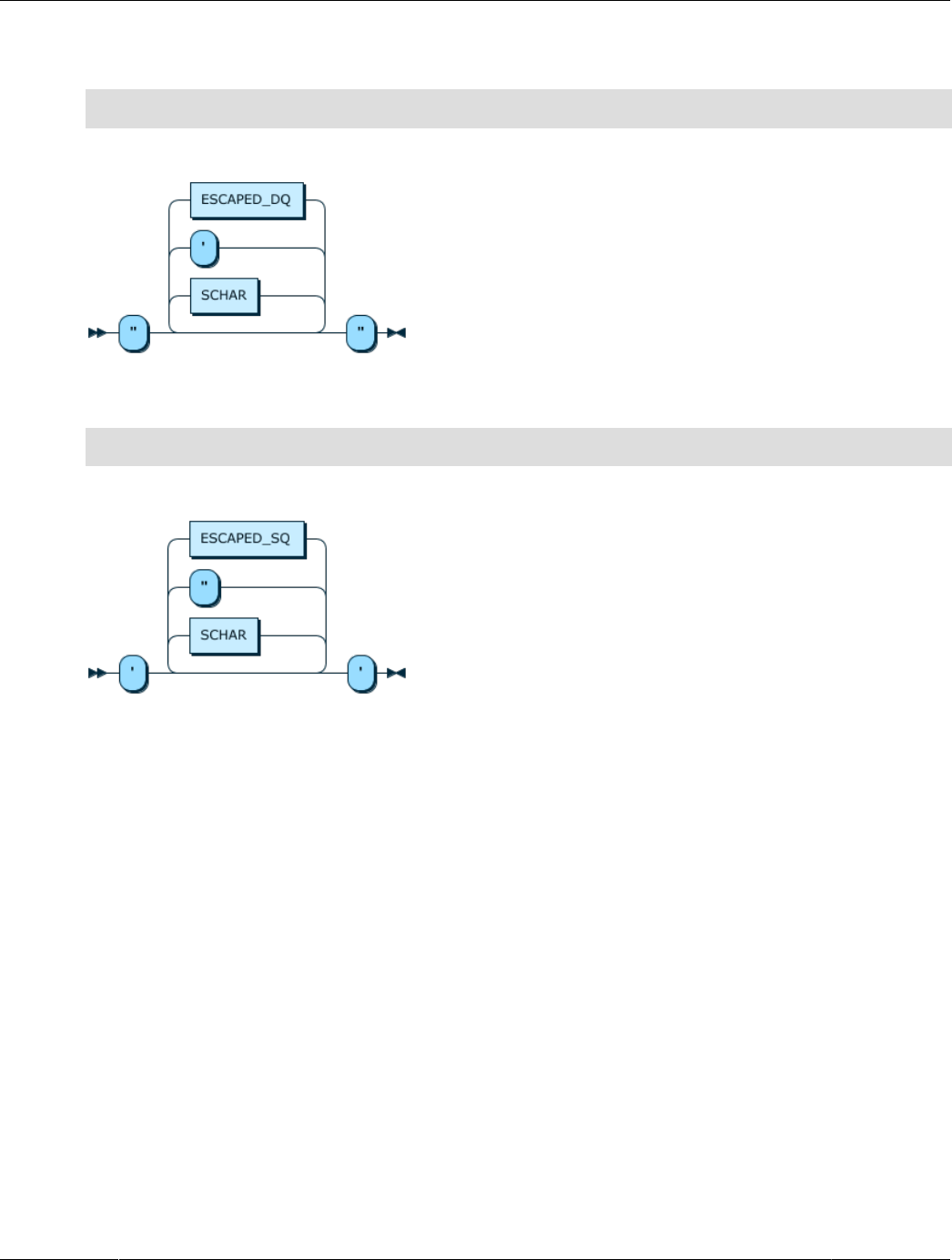
STRING_DQ
STRING_DQ
STRING_DQ
::= '"' ( SCHAR | "'" | ESCAPED_DQ )* '"'
Figure 12.39 STRING_DQ
STRING_SQ
STRING_SQ
::= "'" ( SCHAR | '"' | ESCAPED_SQ )* "'"
Figure 12.40 STRING_SQ
162

Chapter 13 Implementation Notes
Table of Contents
13.1 MySQL Connector Notes ........................................................................................................ 163
13.2 MySQL Shell X DevAPI extensions ......................................................................................... 163
13.3 MySQL Connector/Node.js Notes ............................................................................................ 163
13.4 MySQL Connector/J Notes ...................................................................................................... 163
This section provides notes on the different language-specific implementations of X DevAPI.
13.1 MySQL Connector Notes
Each driver implementation of X DevAPI may deviate from the description in marginal details to align
the implementation to the common pattern and styles of the host language. All class names are identical
among drivers and all drivers support the same core concepts such as find() or the chaining supported
for find() to ensure developers experience similar APIs in all implementations.
The following implementation differences are possible:
• Function names can be postfixed to add specialisation. For example, implementations can choose
between 'execute([<flag_async>])' and/or 'executeAsync()'.
• Functions can have prefixes such as 'get'.
• Connectors may offer native language result set iteration patterns in addition to a basic while() loop
shown in many examples. For example, drivers may define iterator interfaces or classes.
13.2 MySQL Shell X DevAPI extensions
MySQL Shell deviates from the Connector implementations of X DevAPI in certain places. A Connector
can connect to MySQL Server instances running X Plugin only by means of X Protocol. MySQL Shell
contains an extension of X DevAPI to access MySQL Server instances through X Protocol. An additional
ClassicSession class is available to establish a connection to a single MySQL Server instance using
classic MySQL protocol. The functionality of the ClassicSession is limited to basic schema browsing and
SQL execution.
See MySQL Shell 8.4.0, for more information.
13.3 MySQL Connector/Node.js Notes
MySQL Connector/Node.js is built with ECMAScript 6 Promise objects to provide an asynchronous API.
All network operations return a Promise, which resolves when the server responds. Please refer to the
information on the ES6 Promise implementation.
13.4 MySQL Connector/J Notes
The following are some features unique to X DevAPI for Connector/J:
• The creation of new Session objects with SessionFactory.
• The creation of new Client objects with ClientFactory.
163


